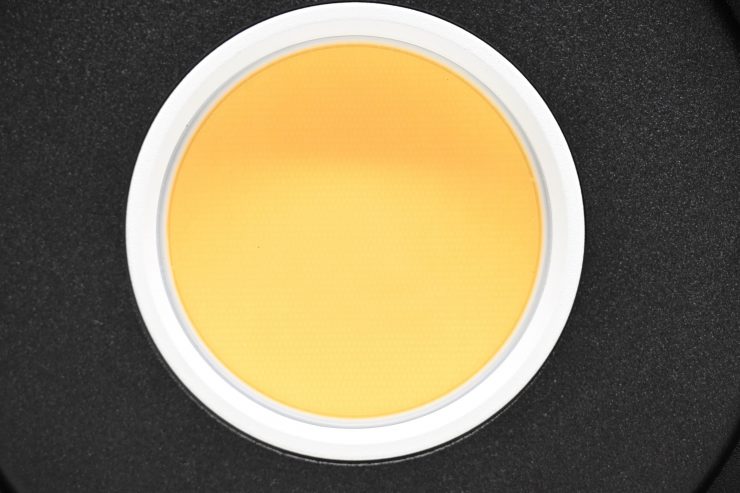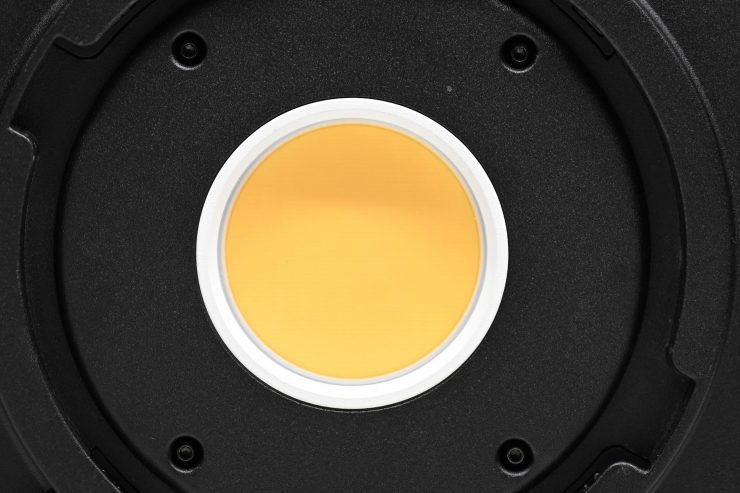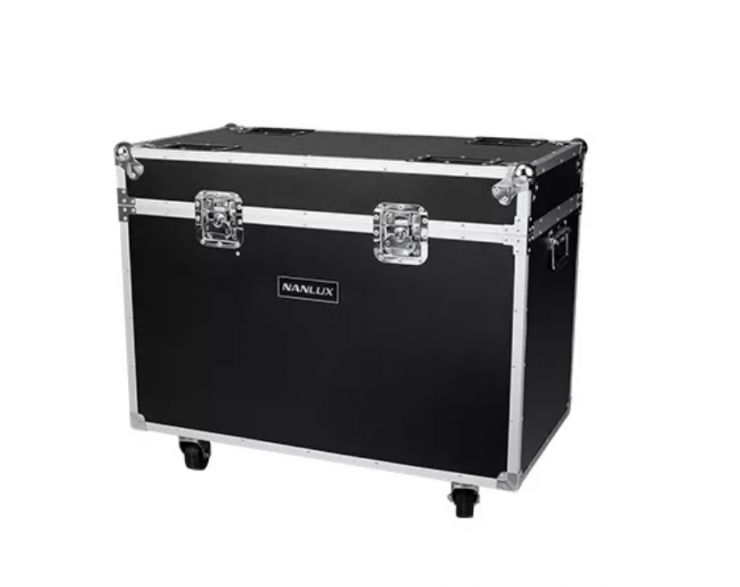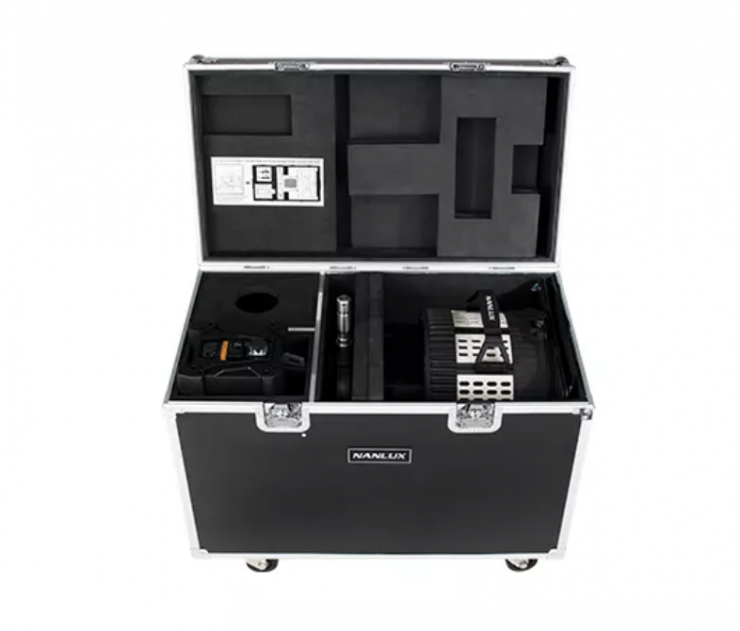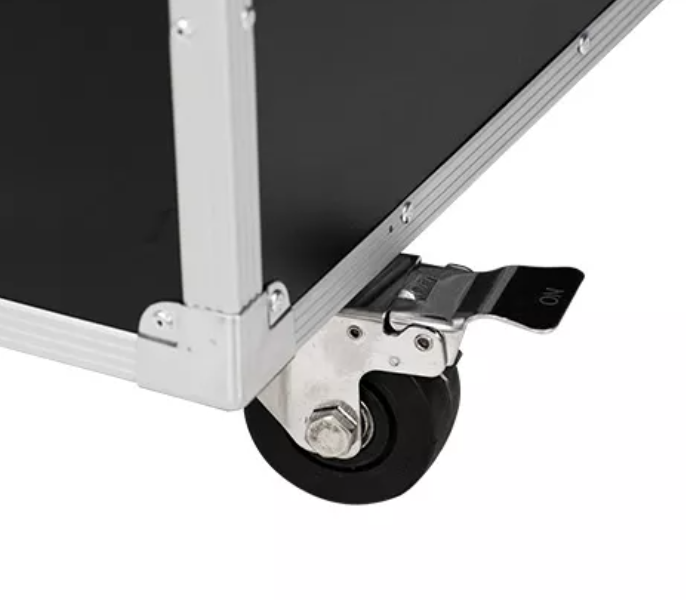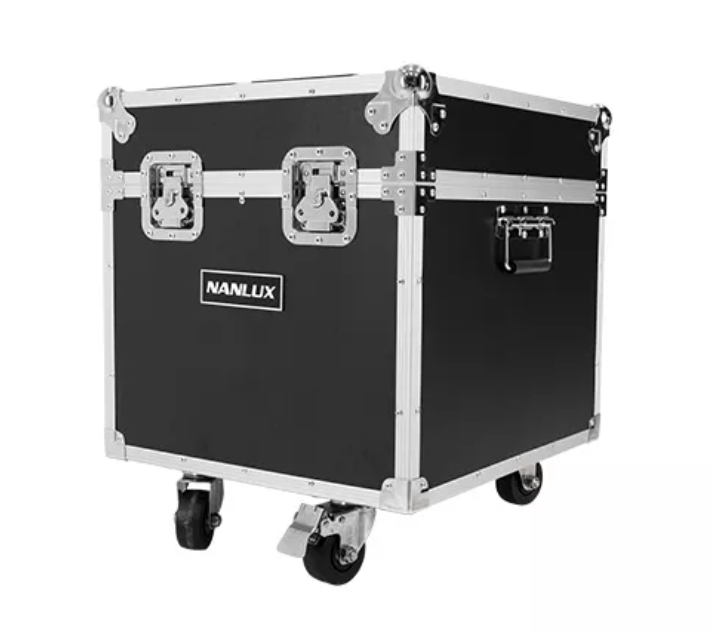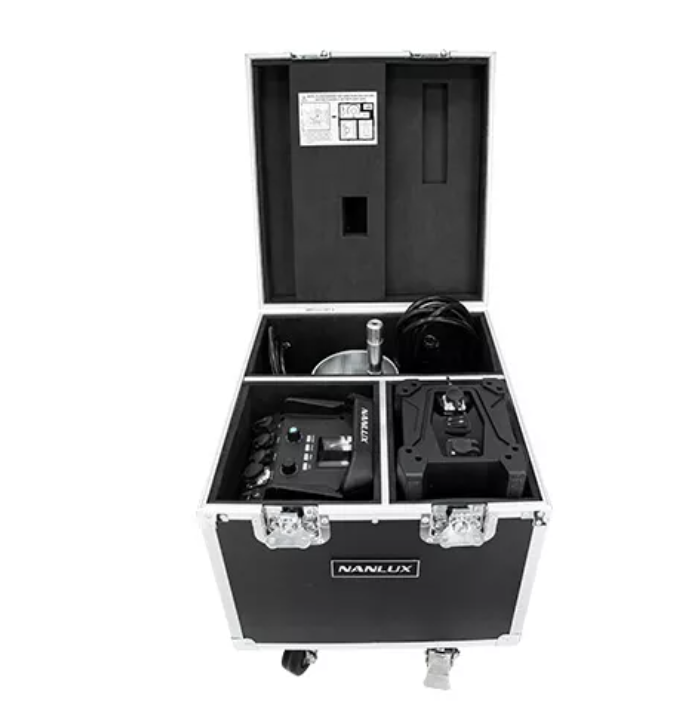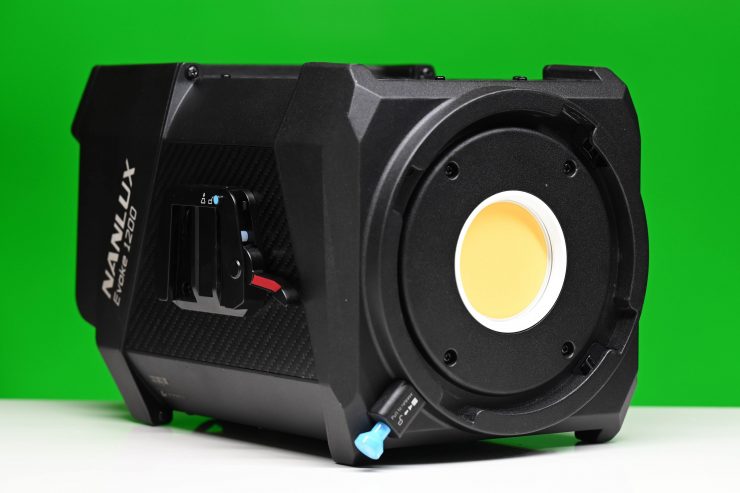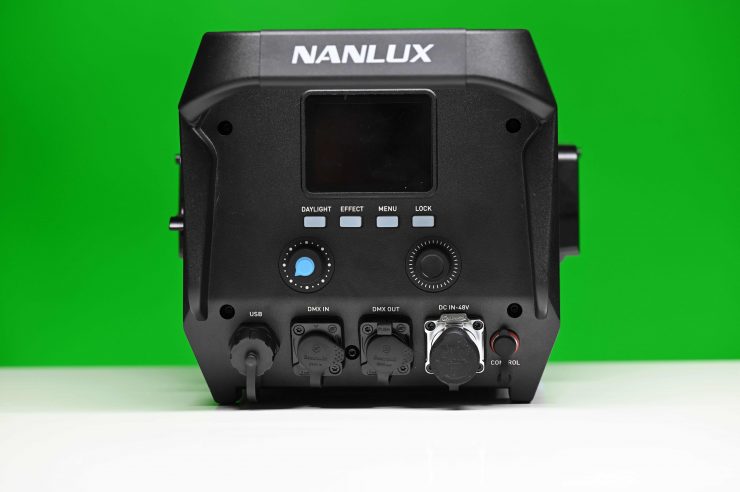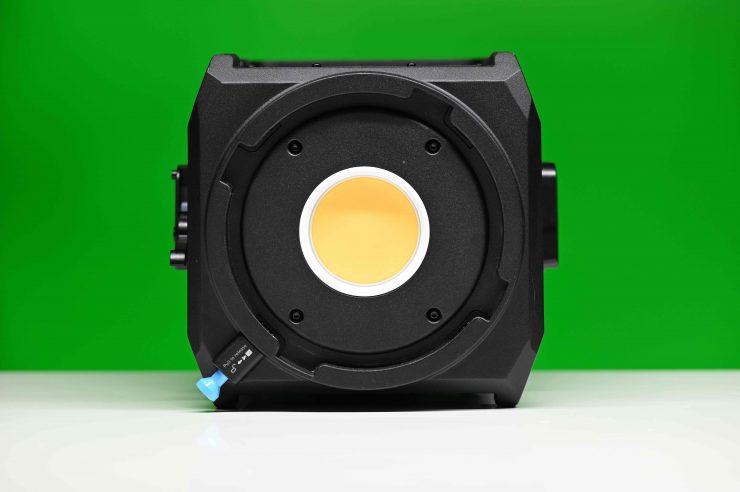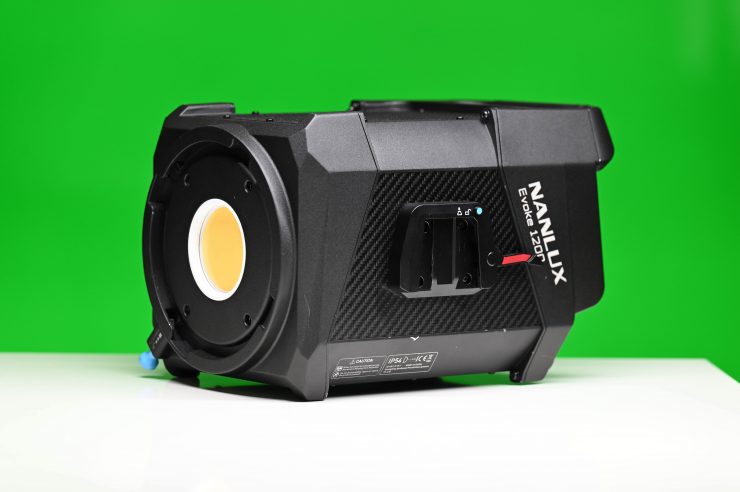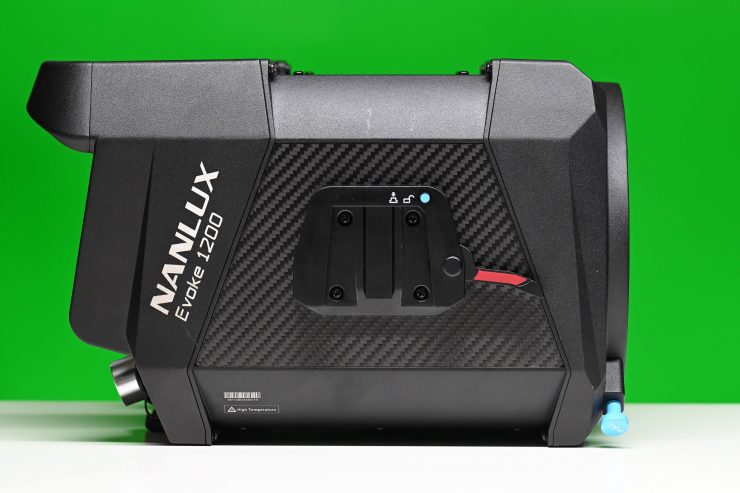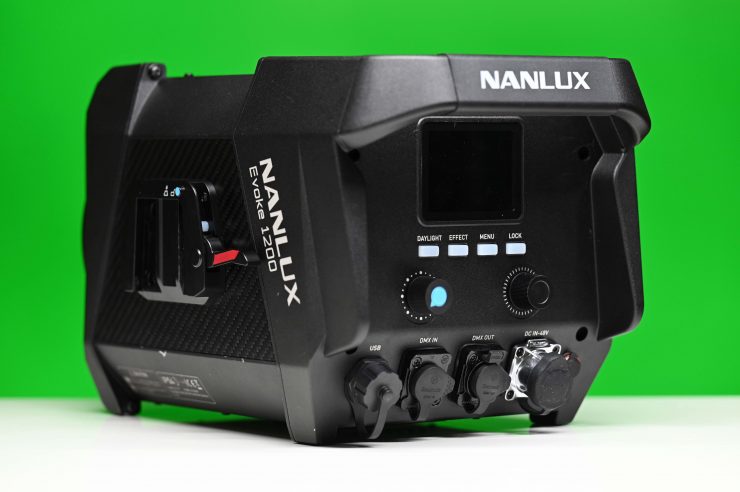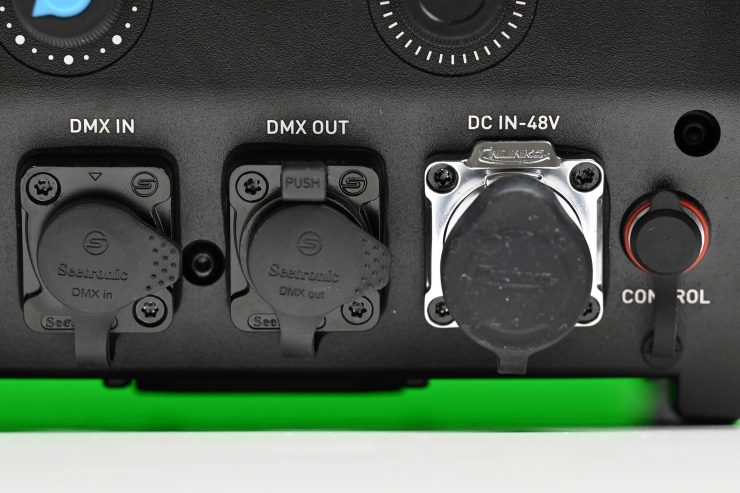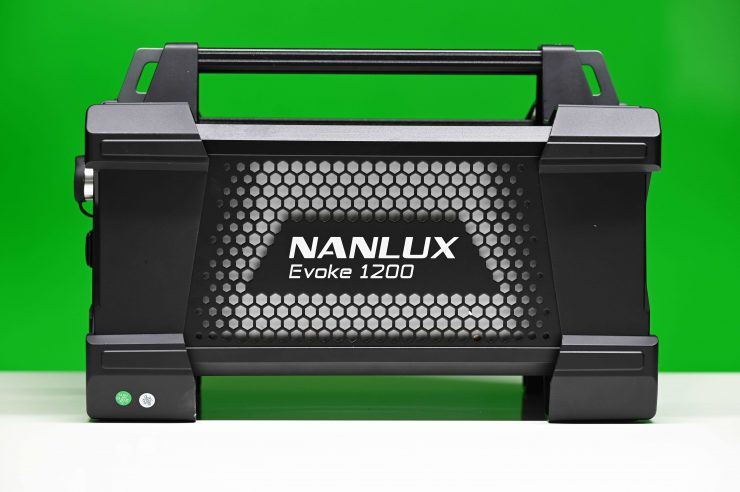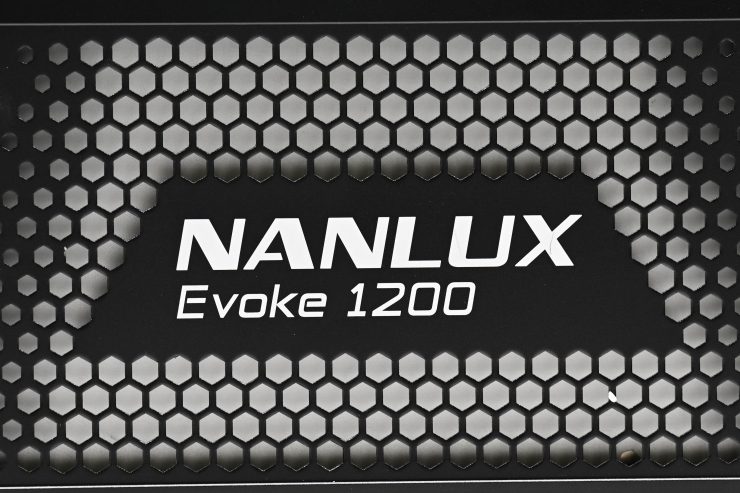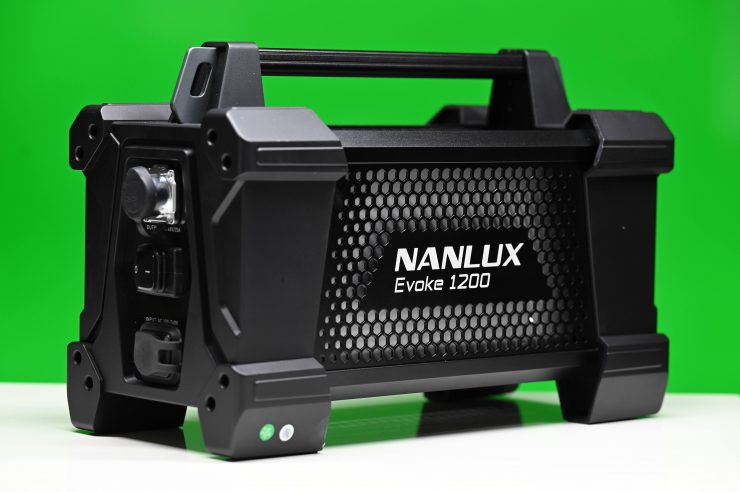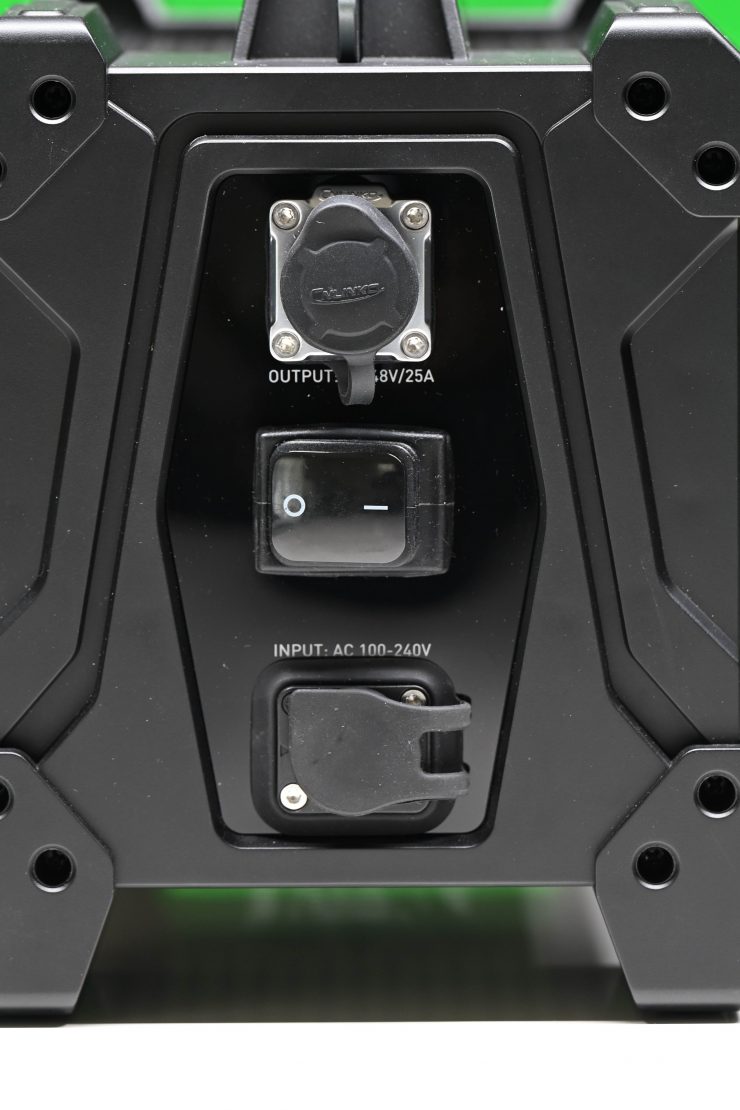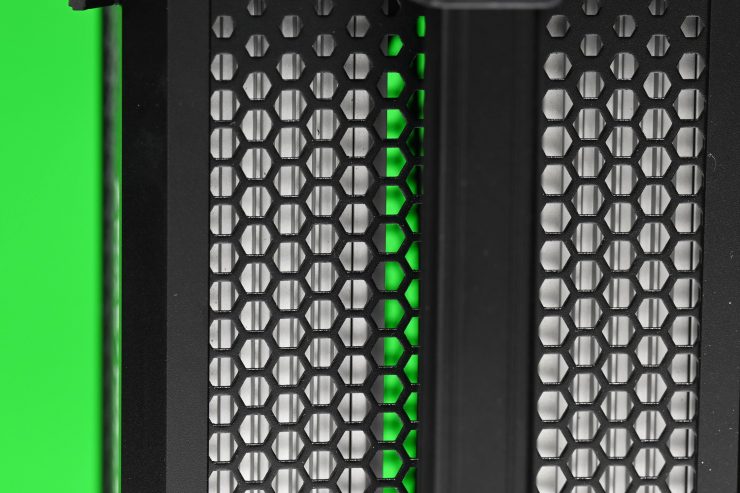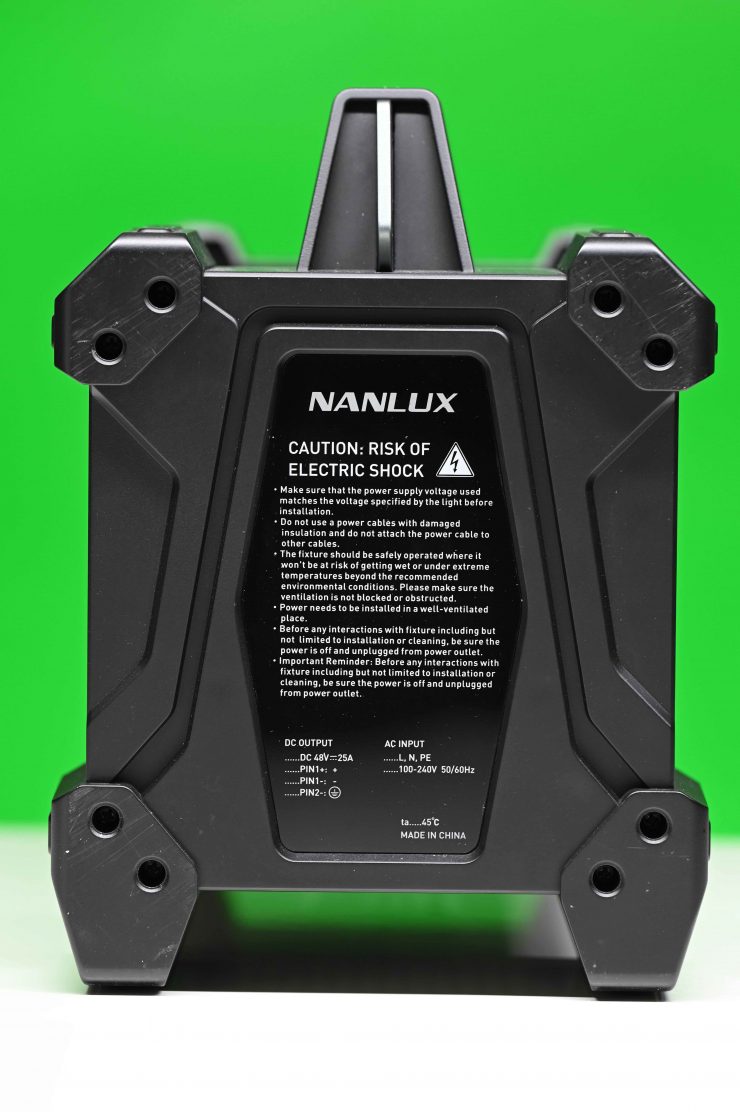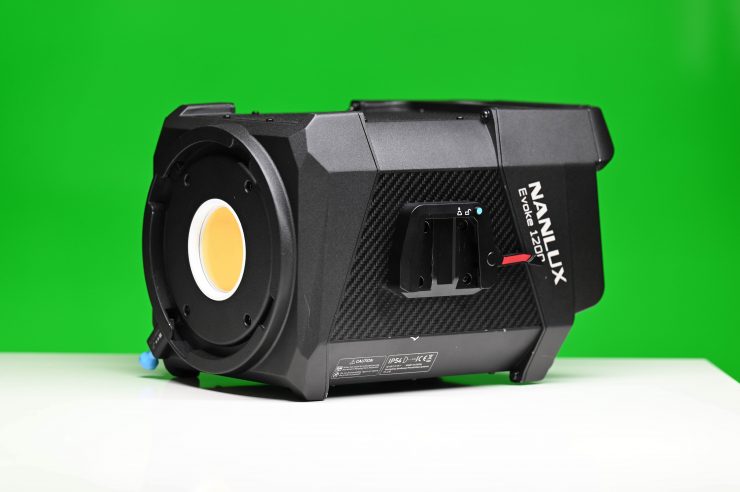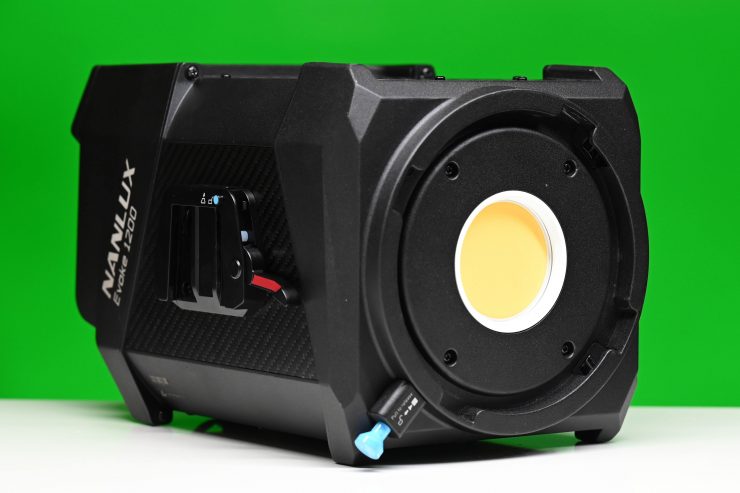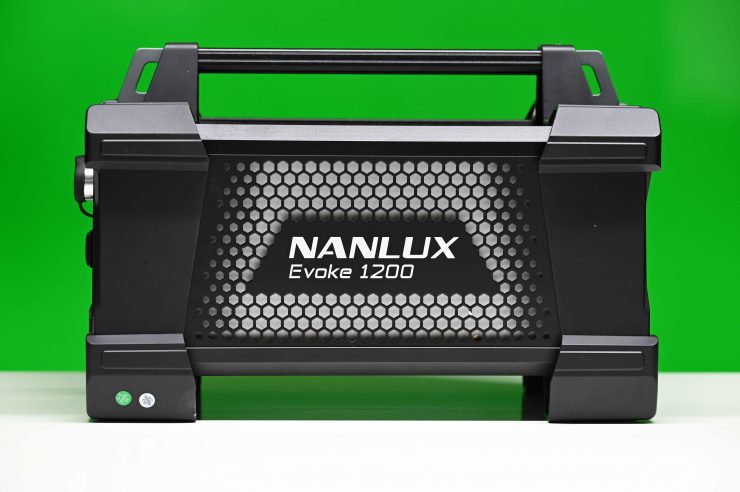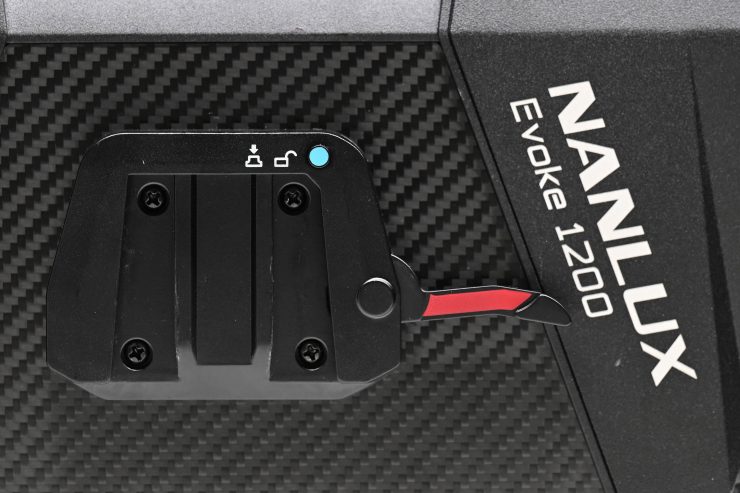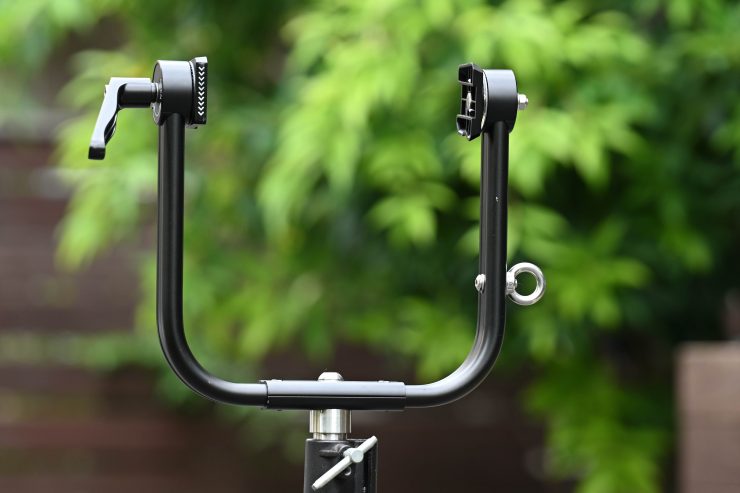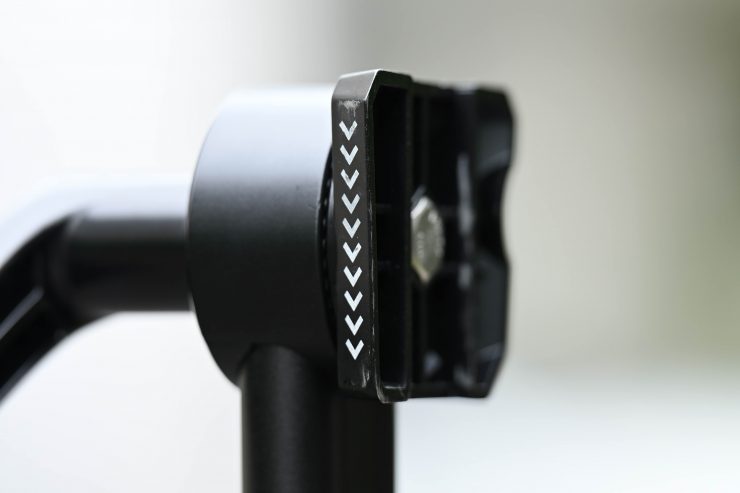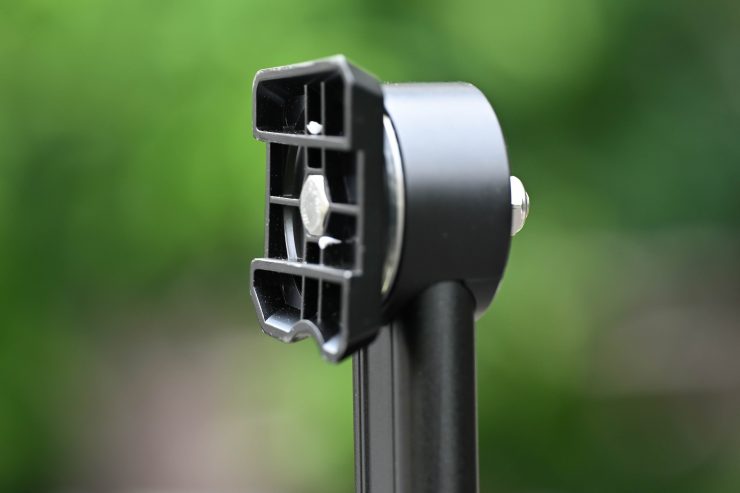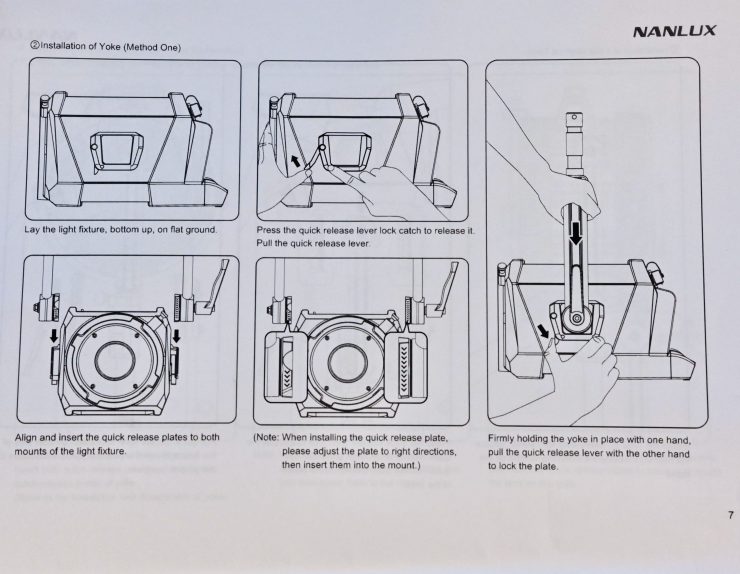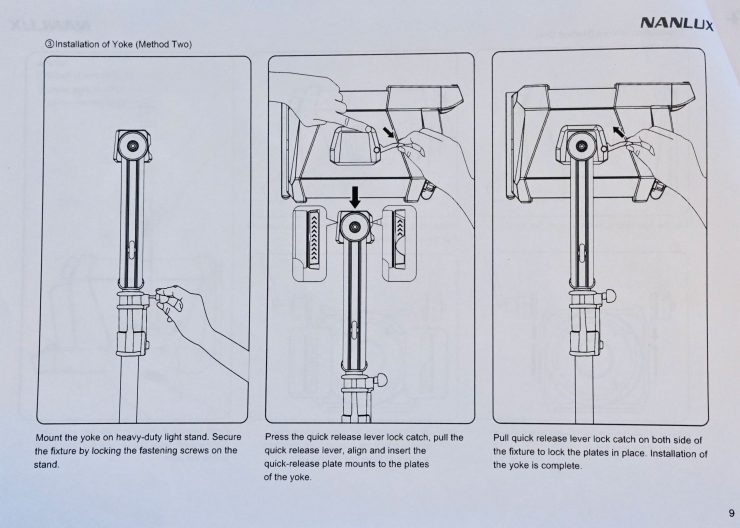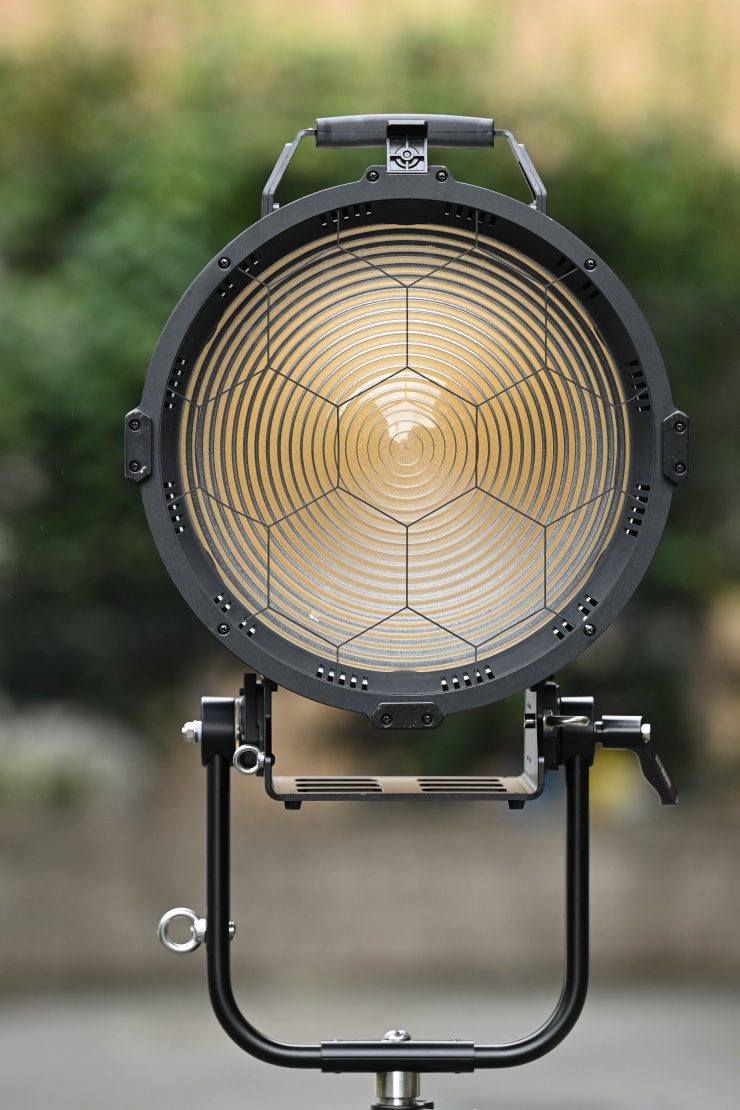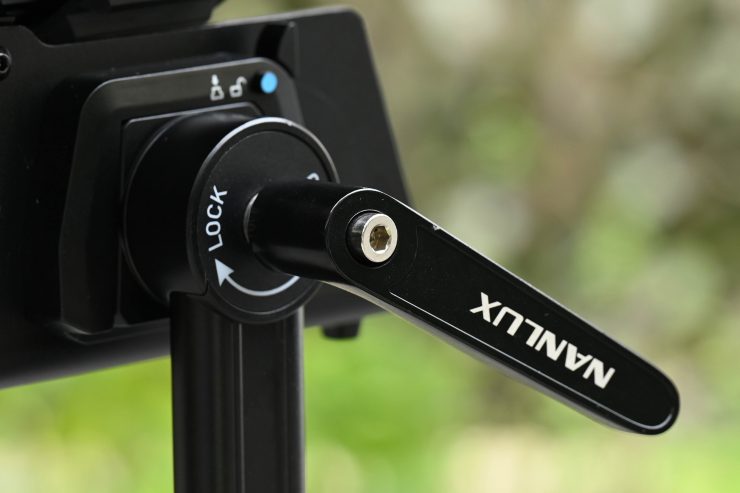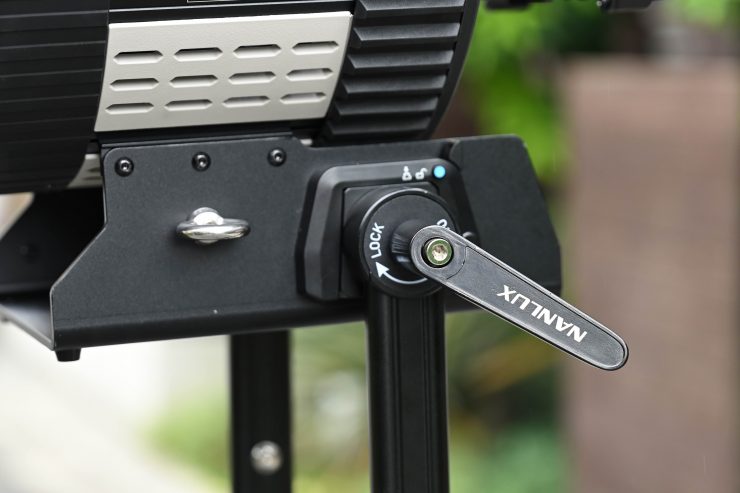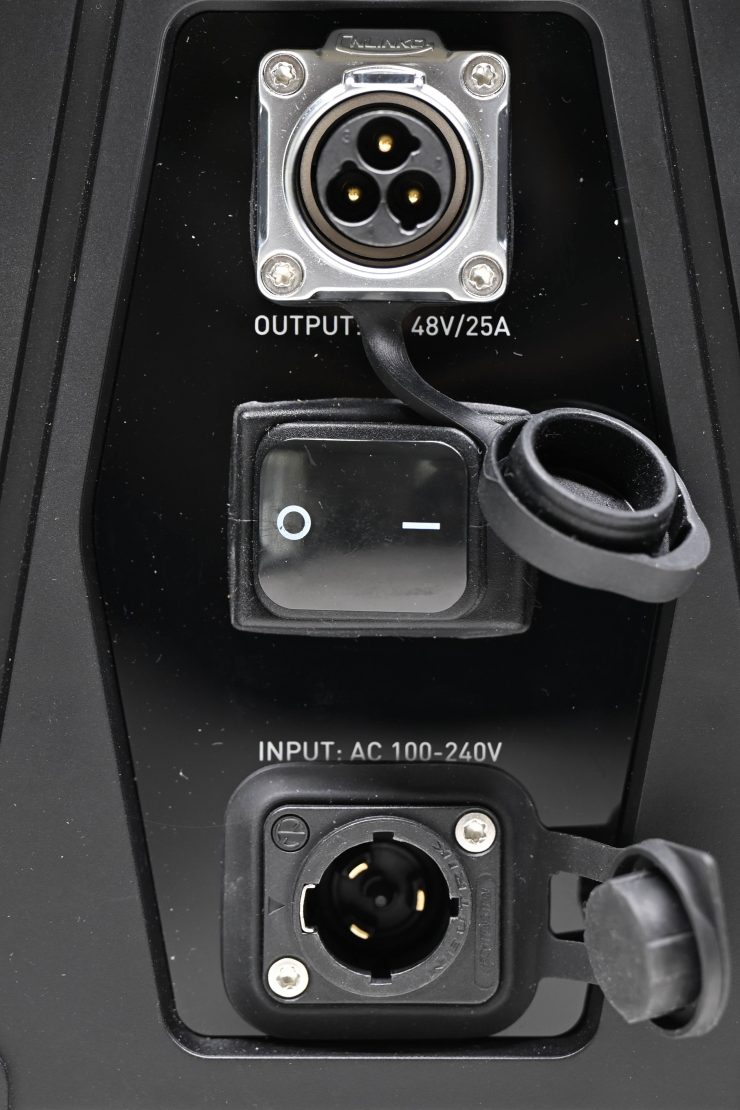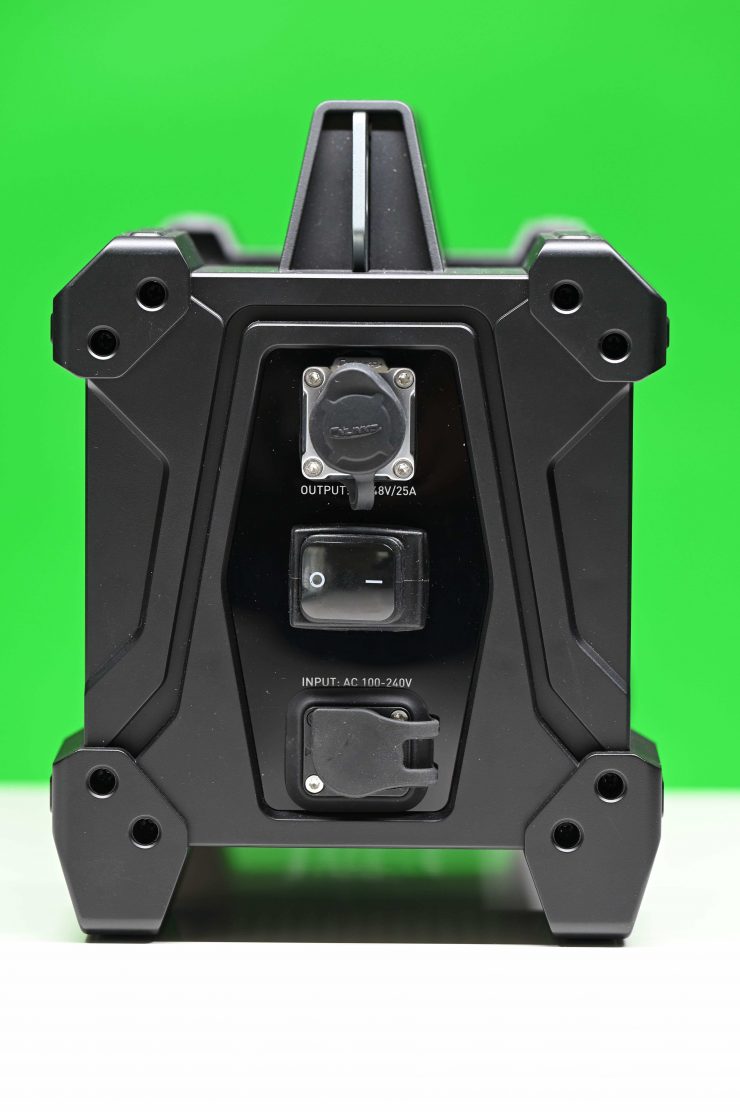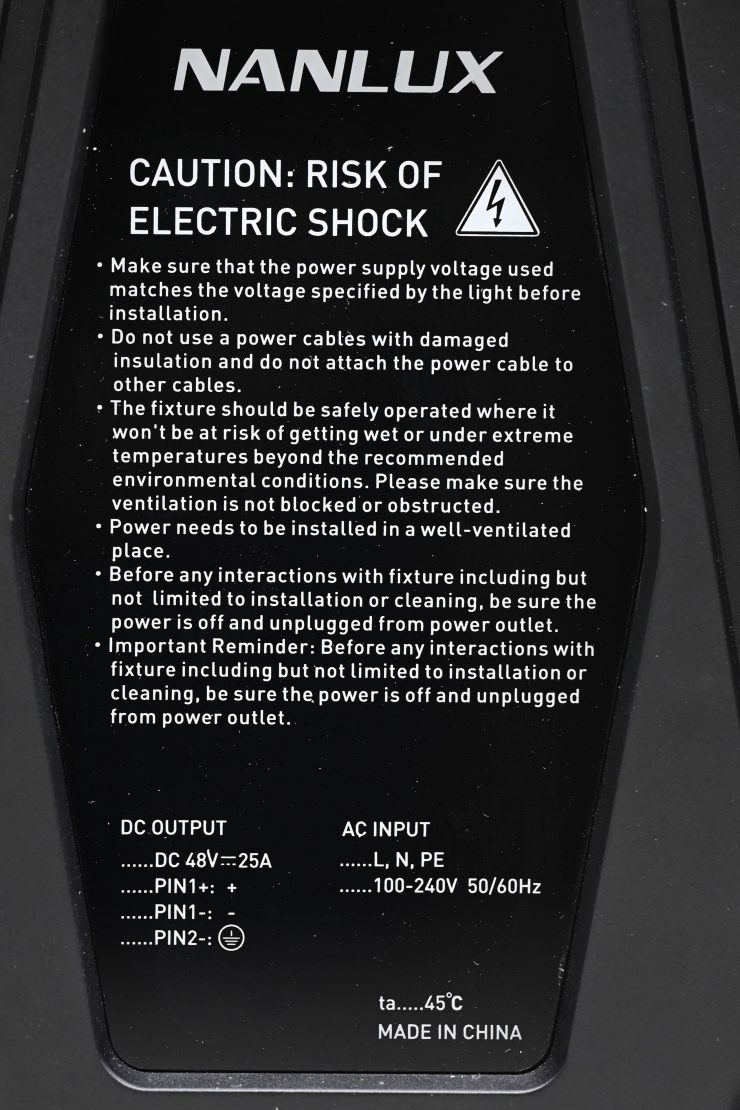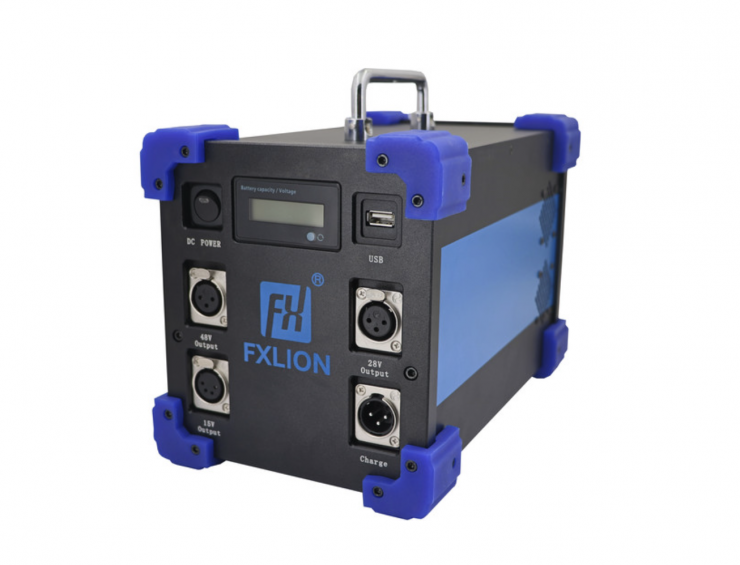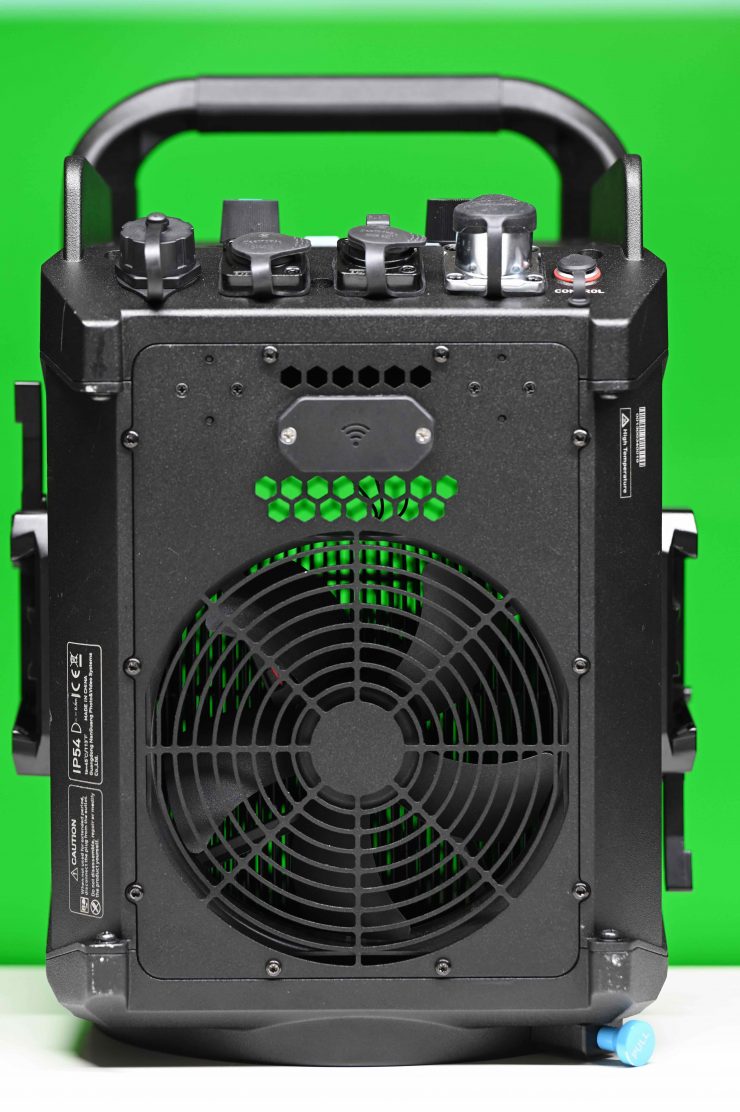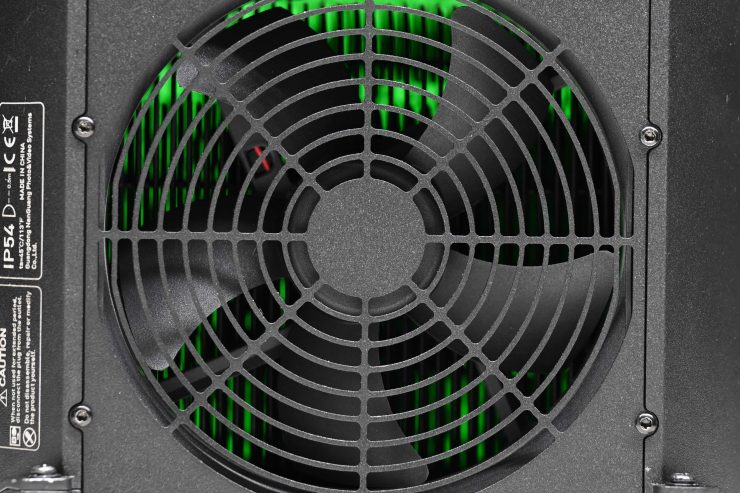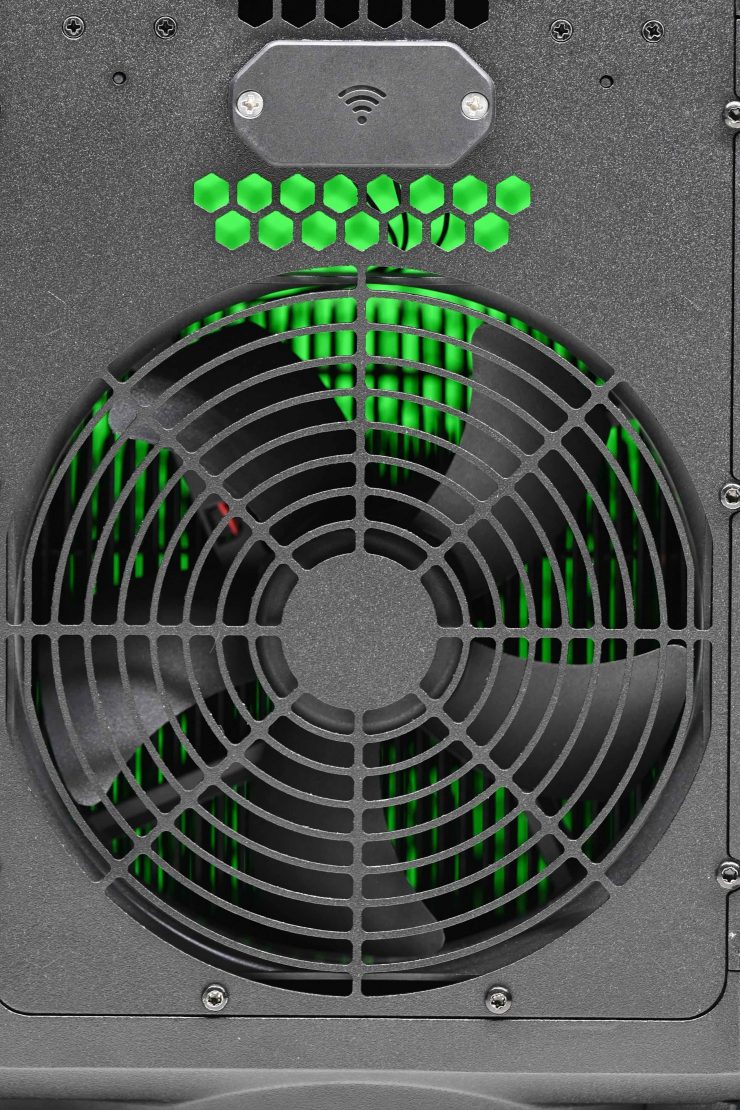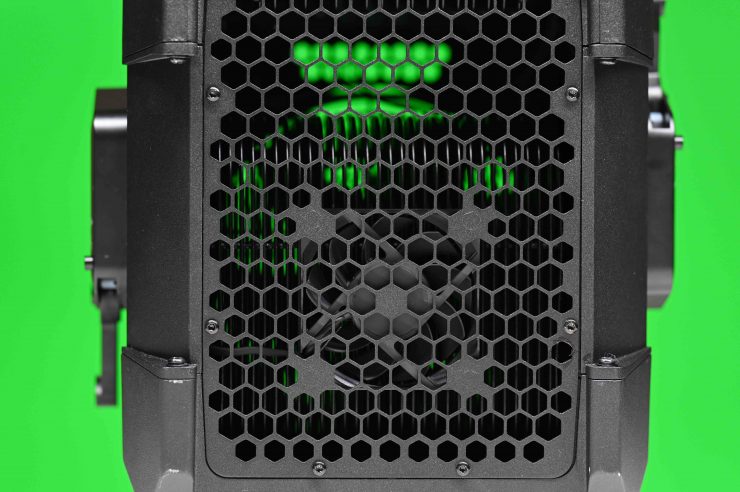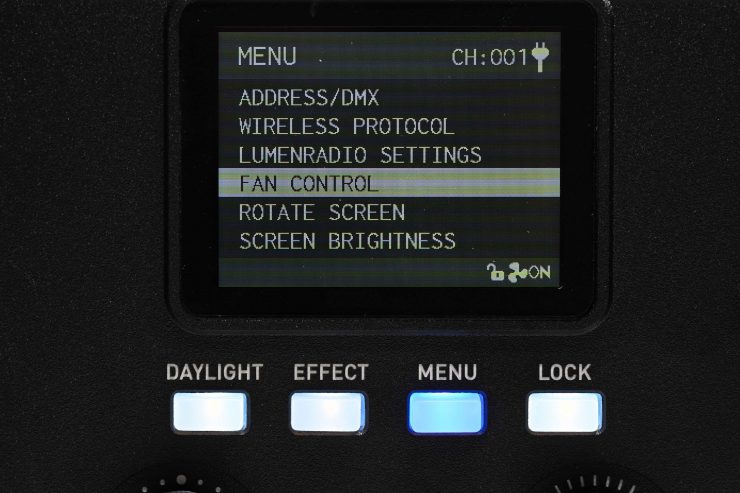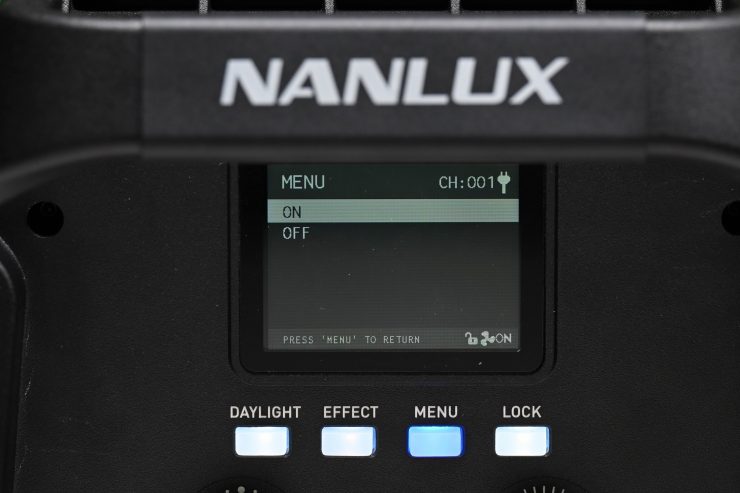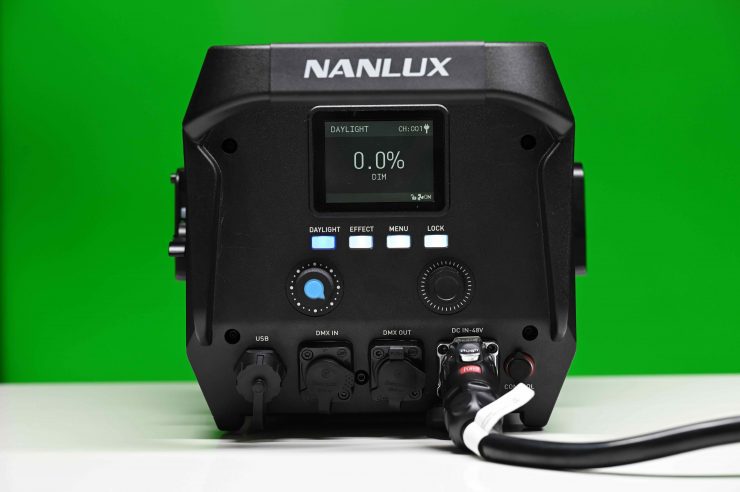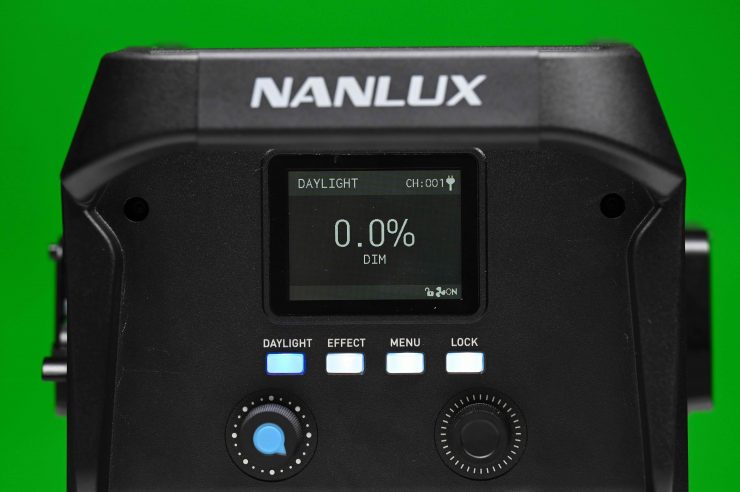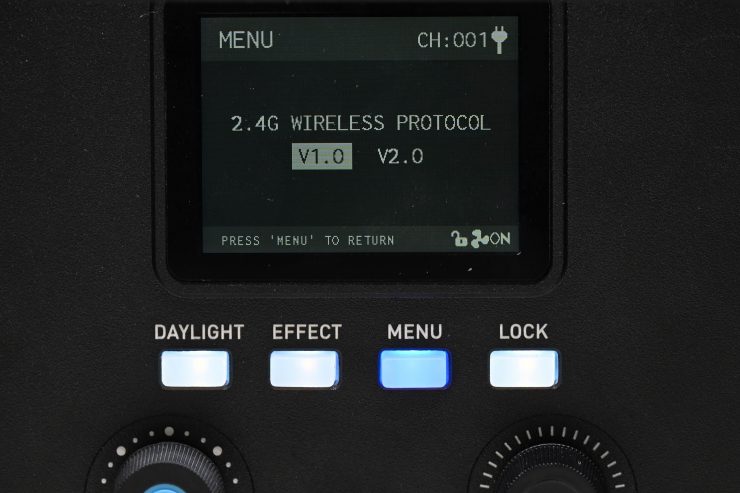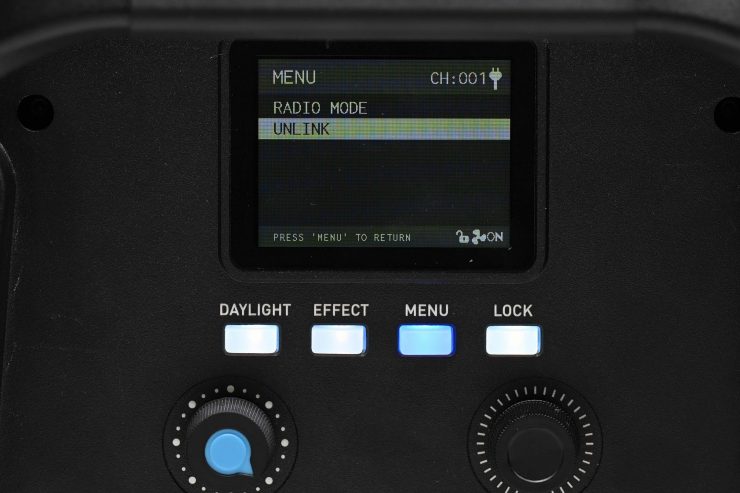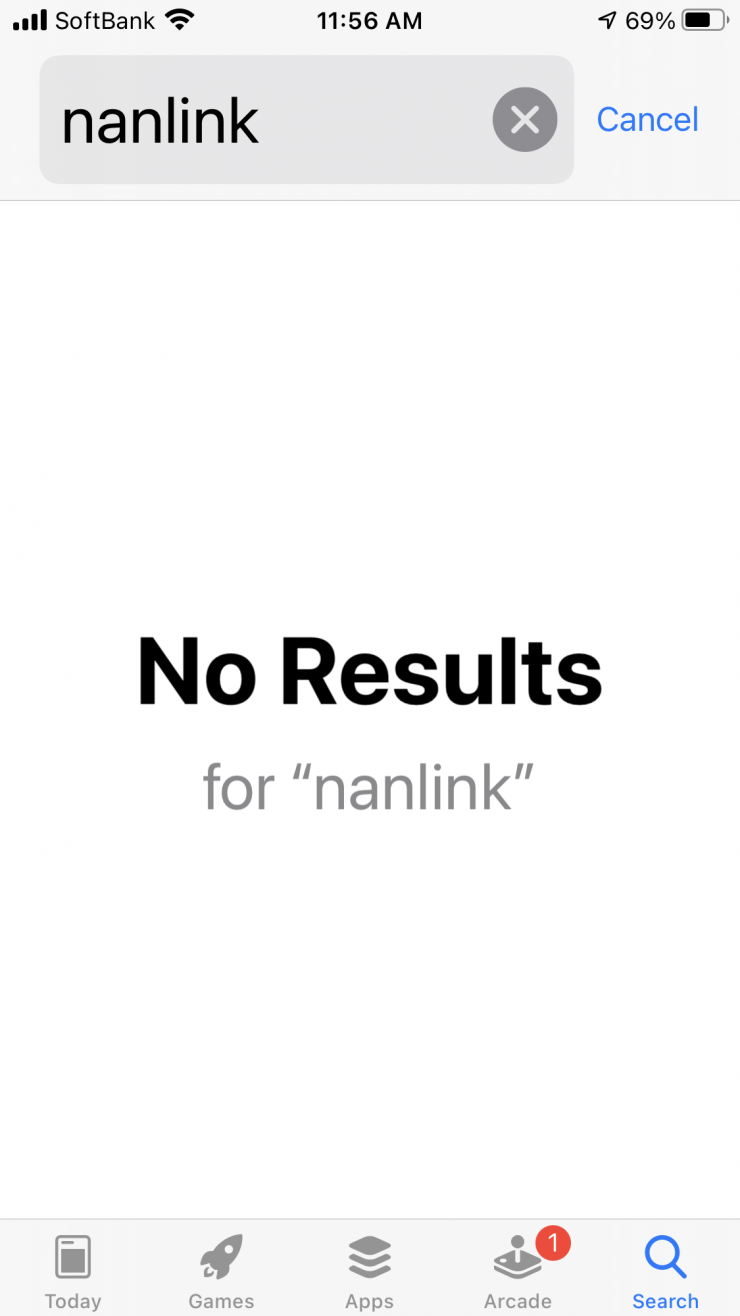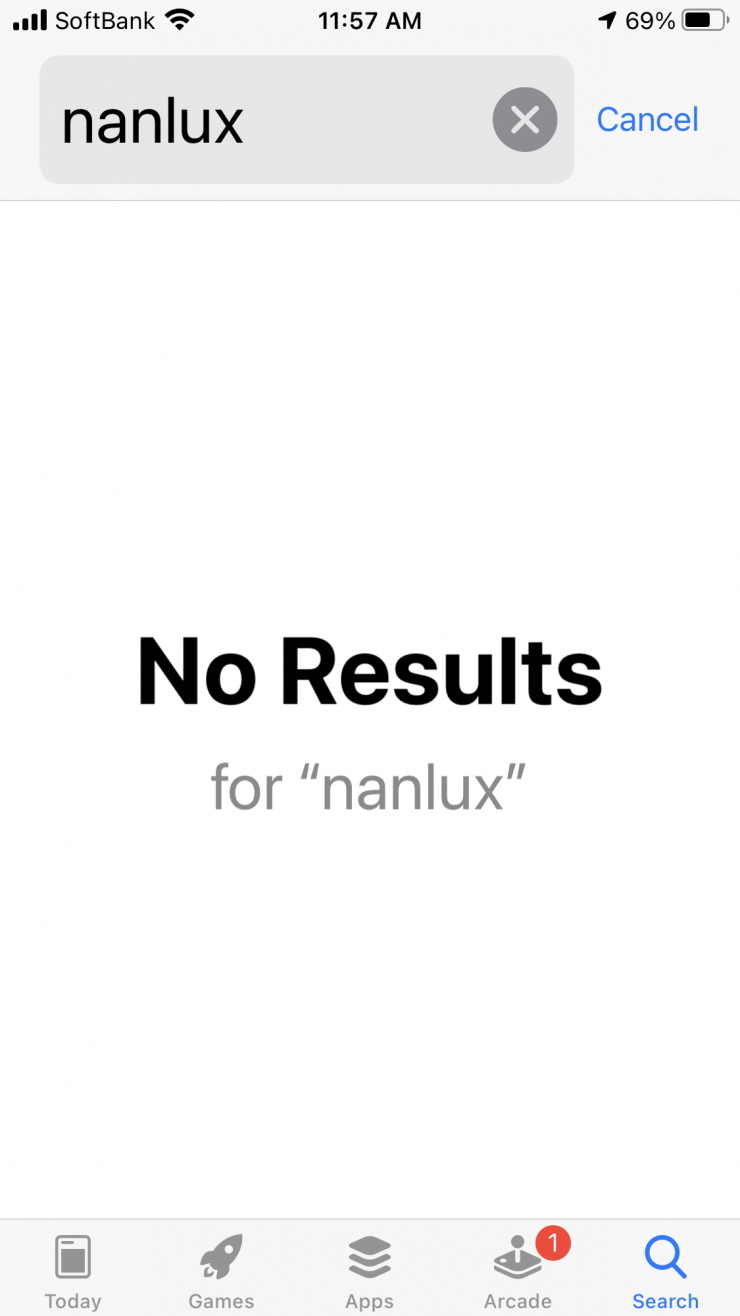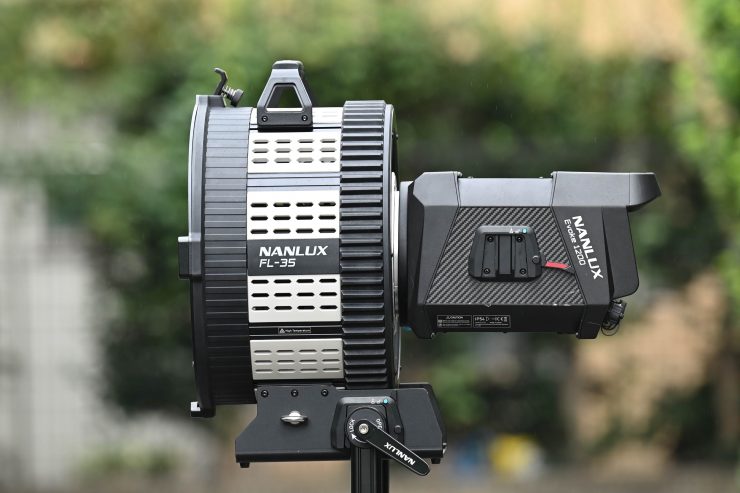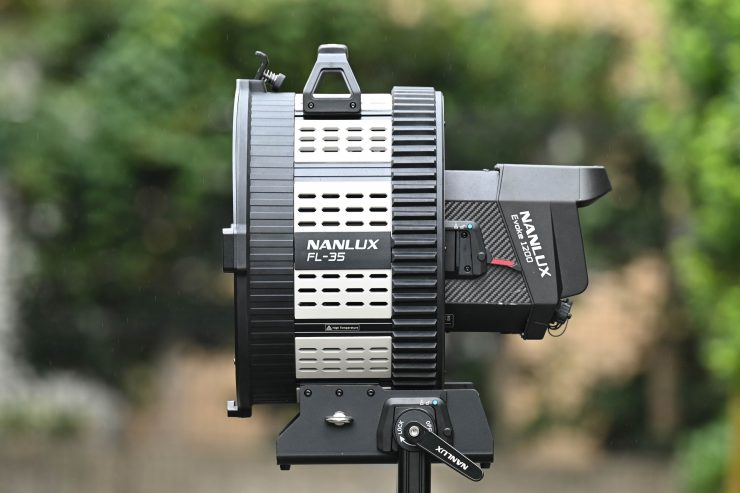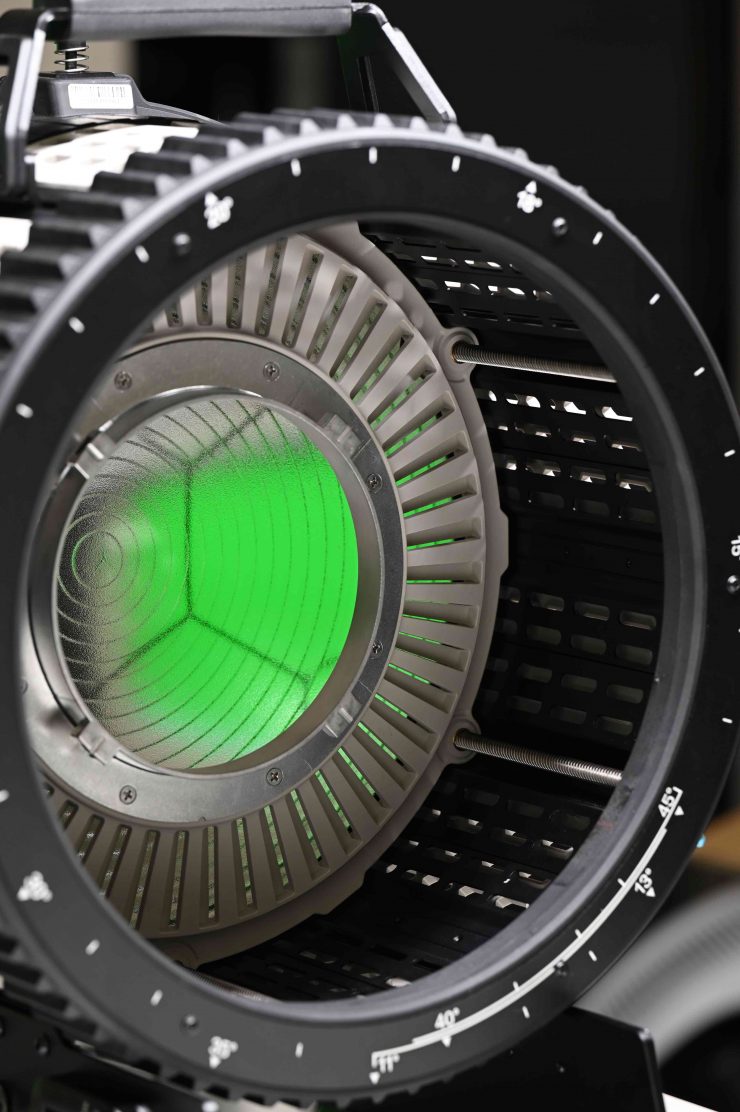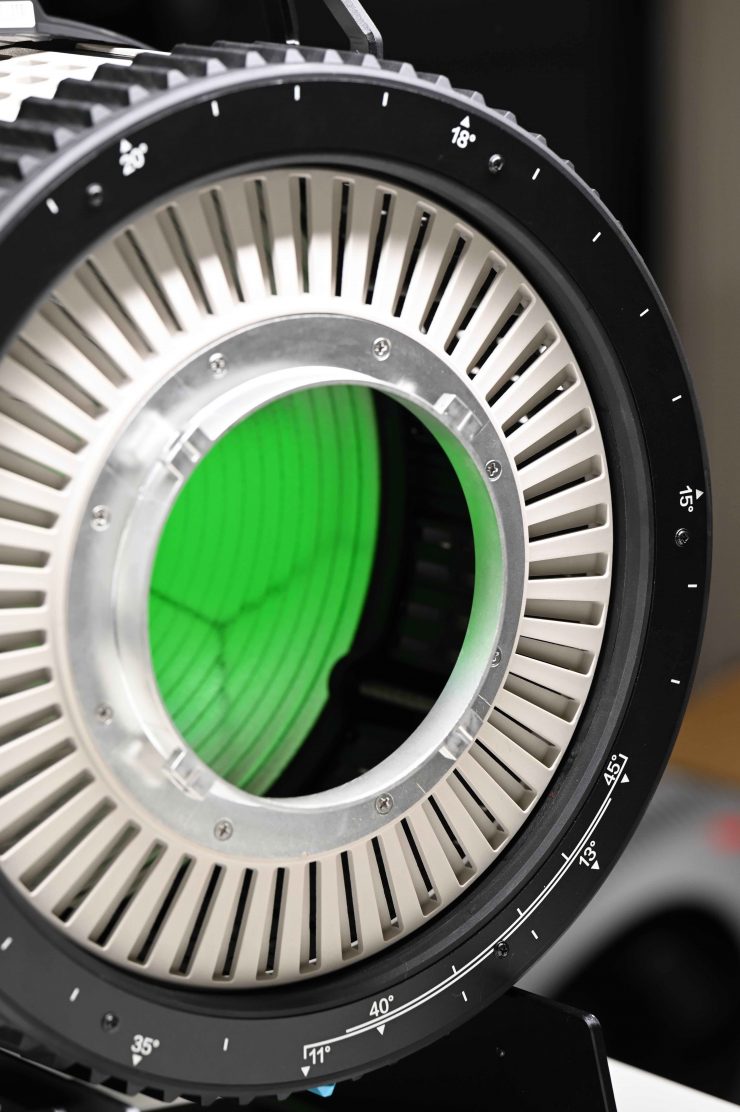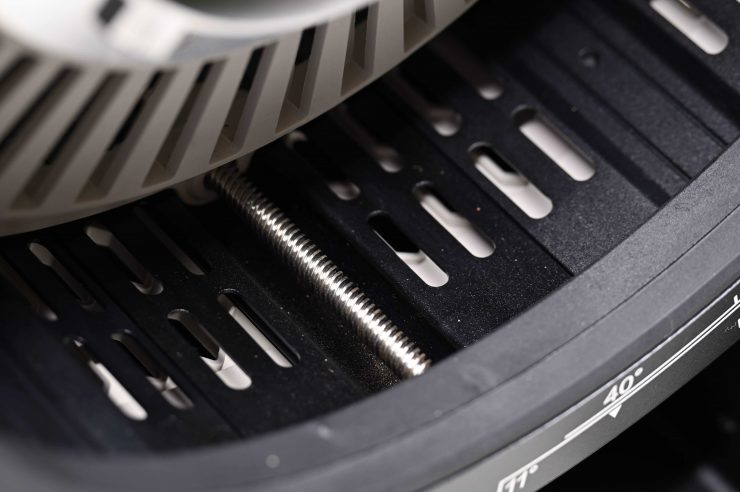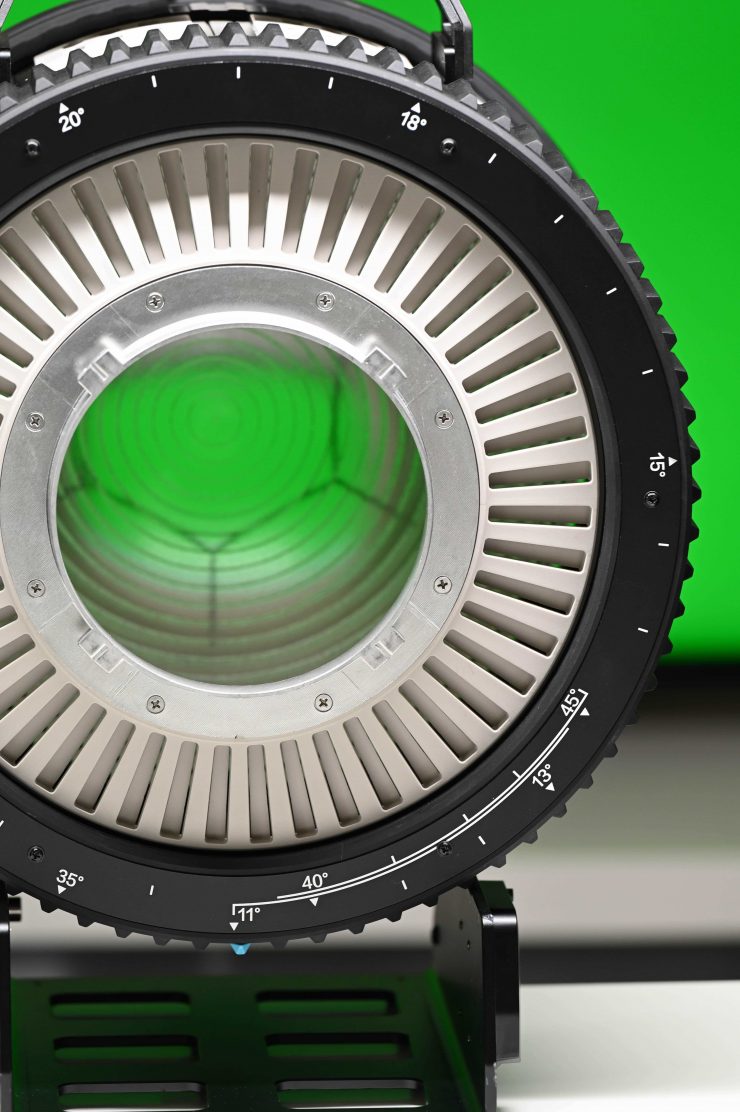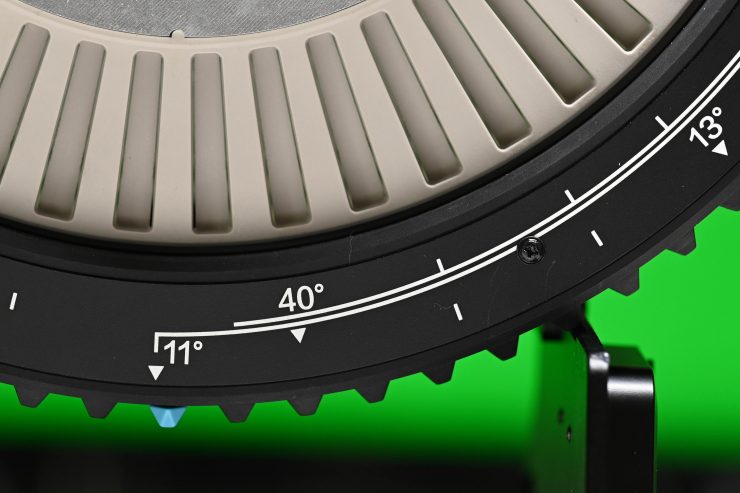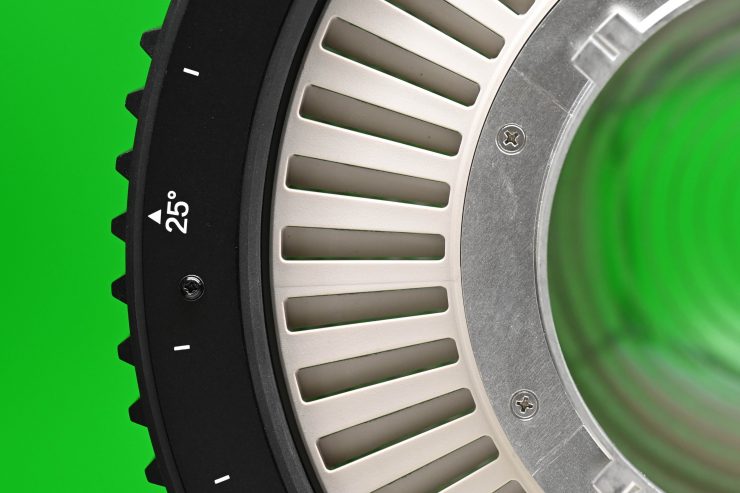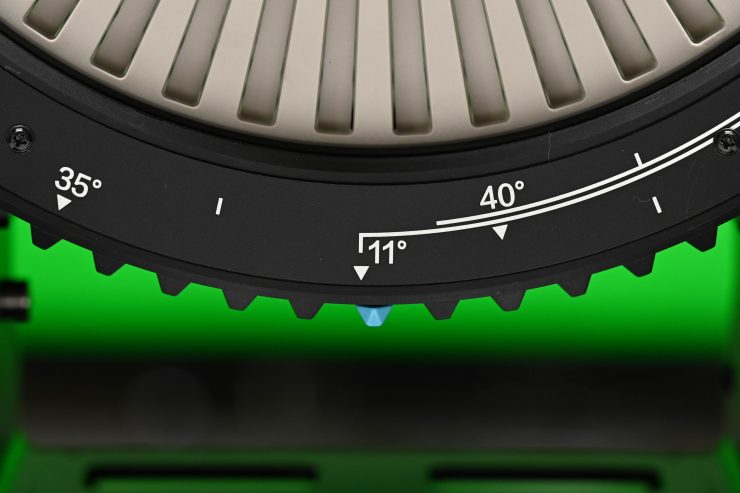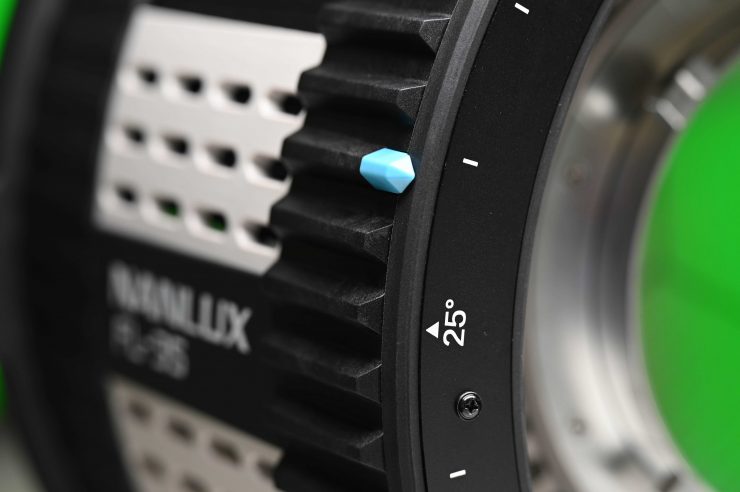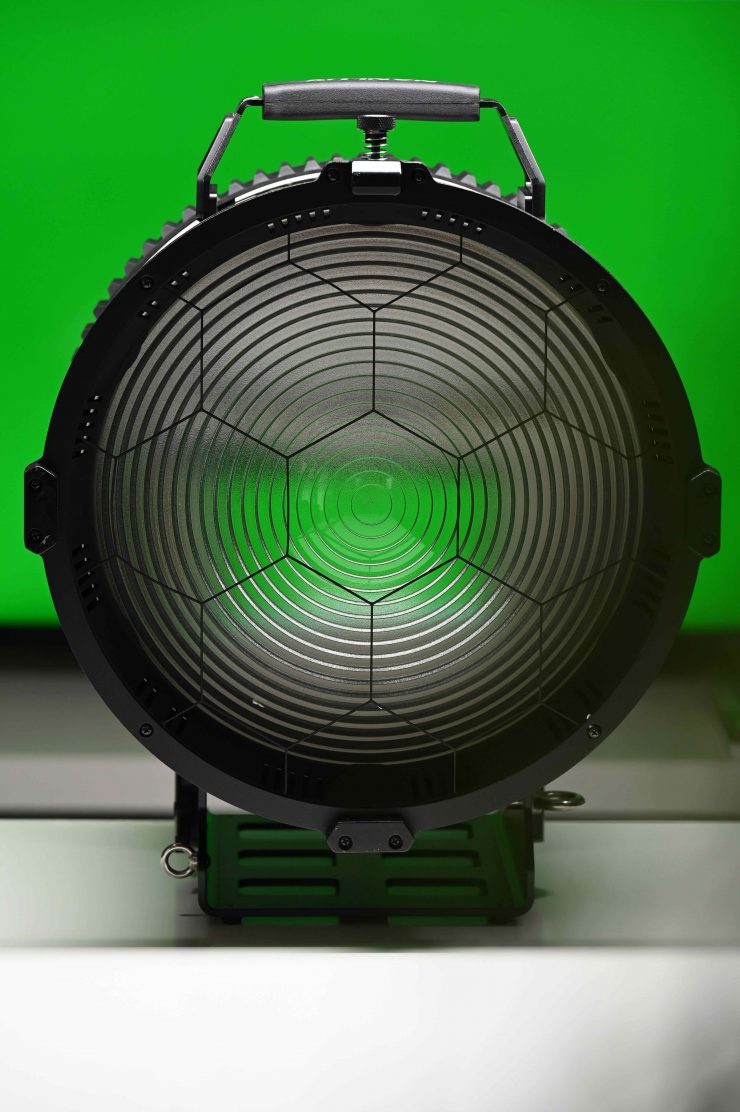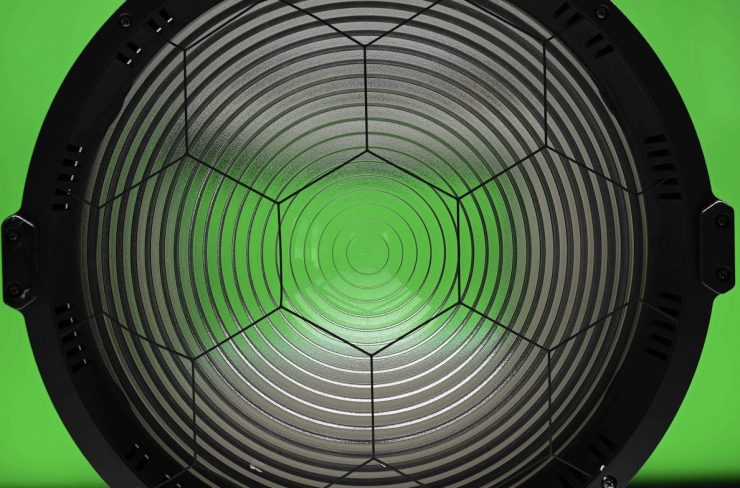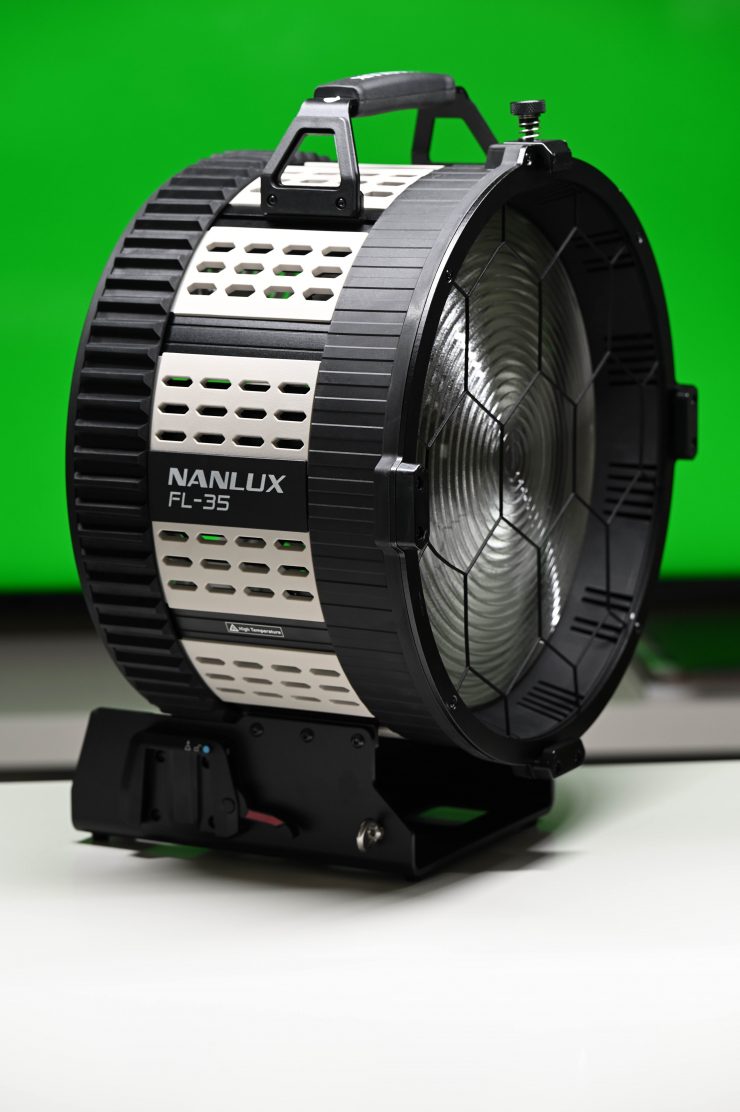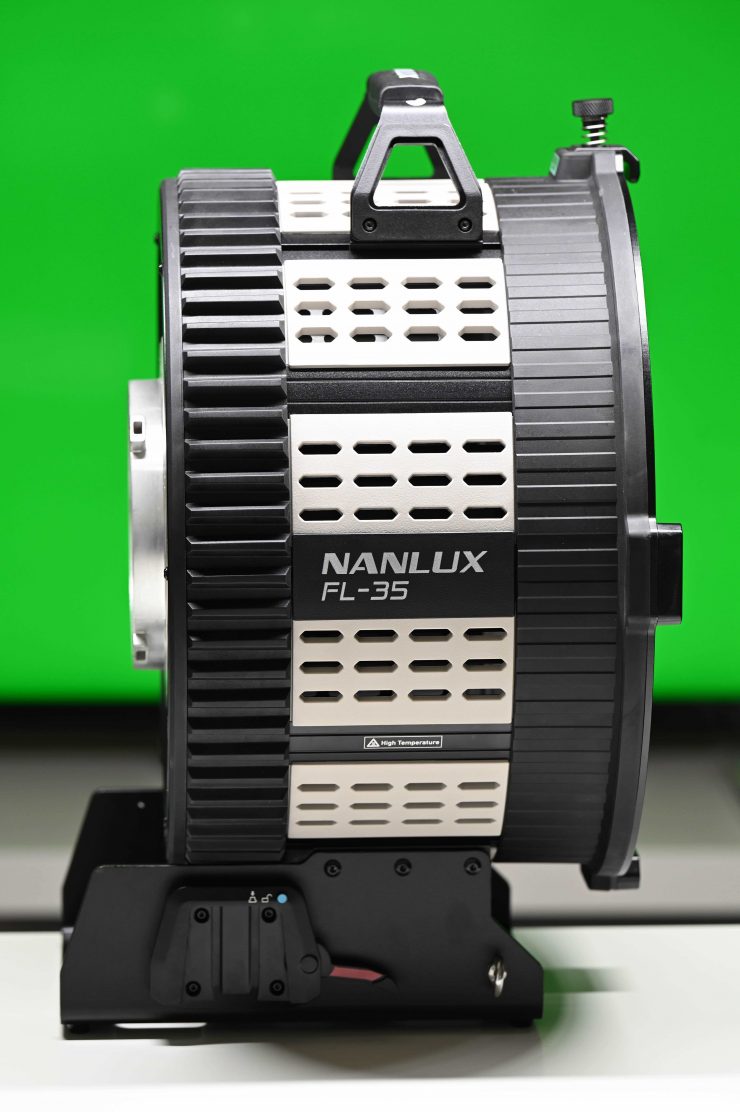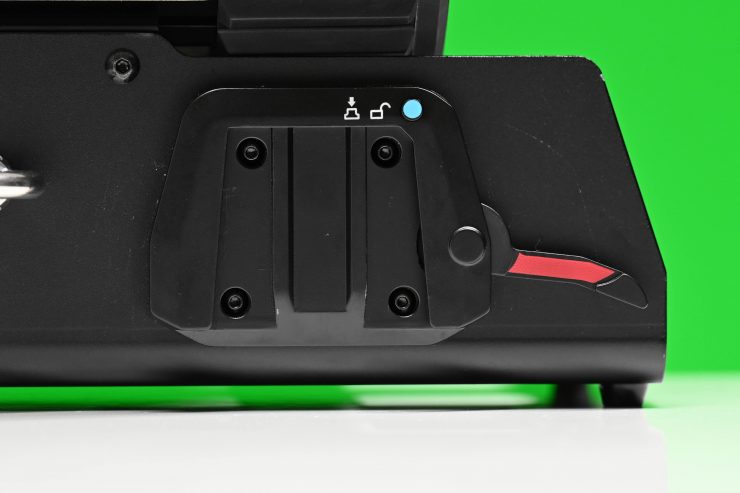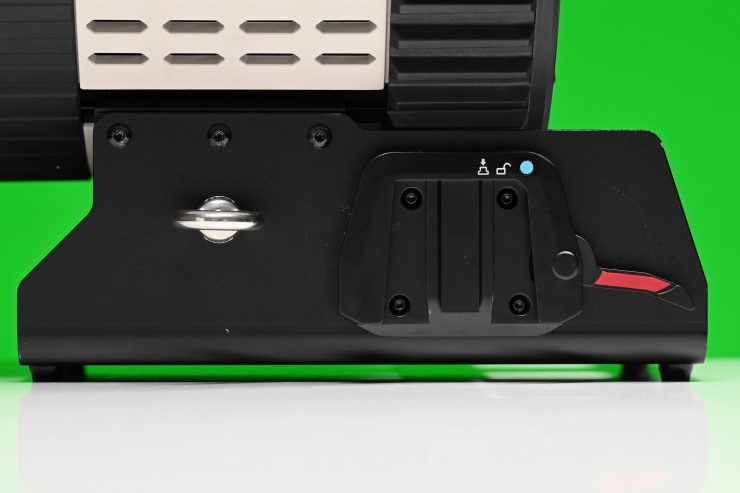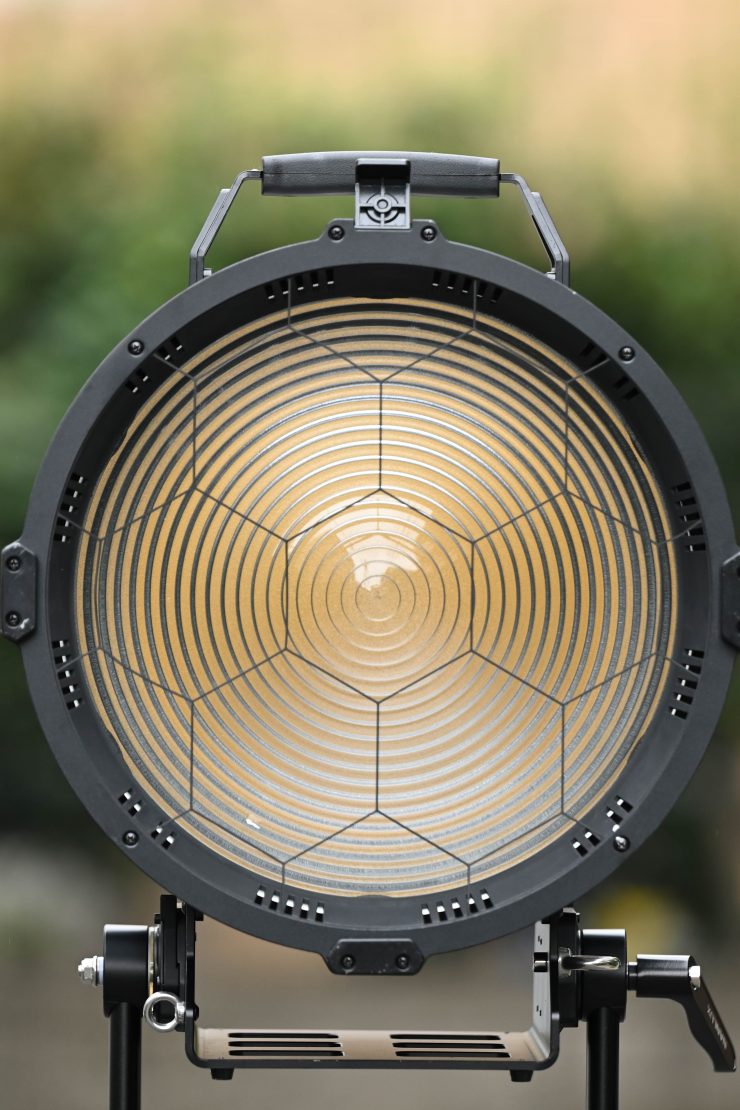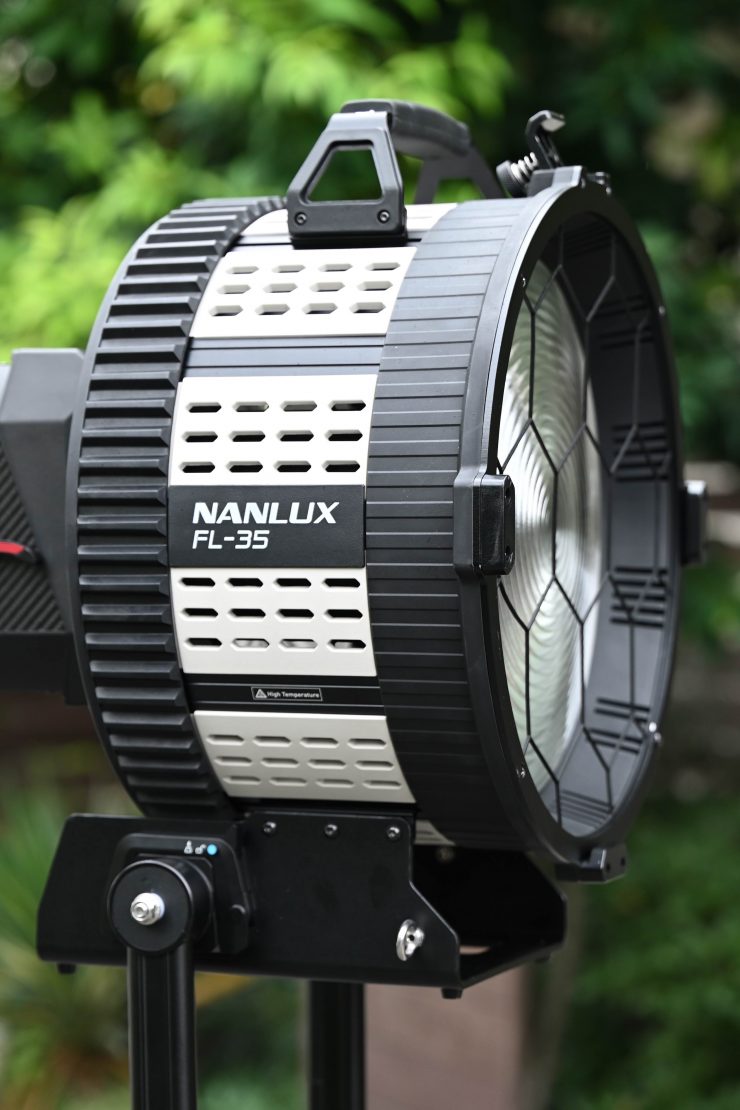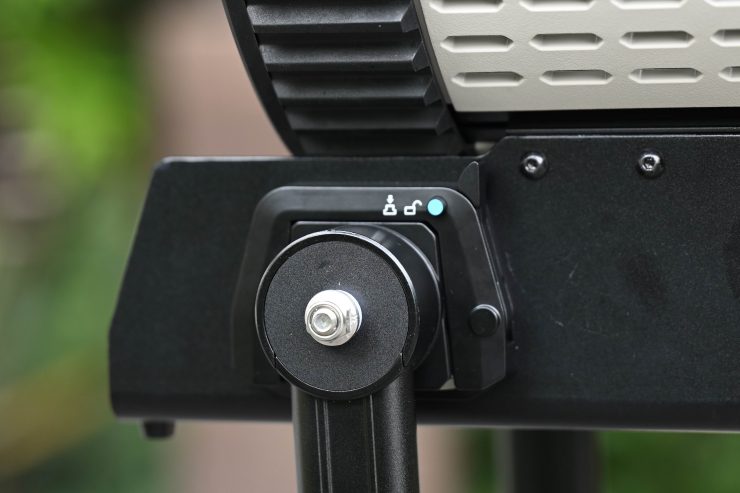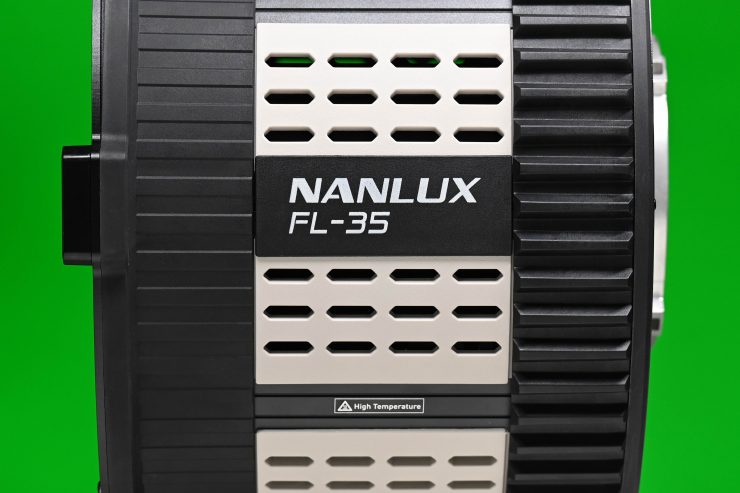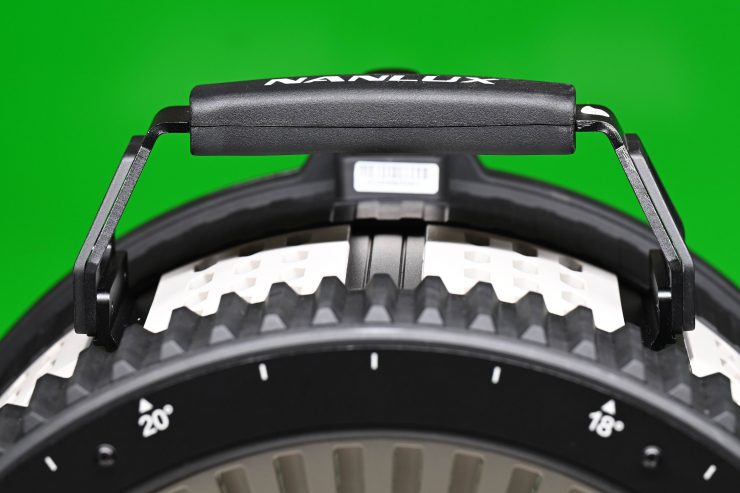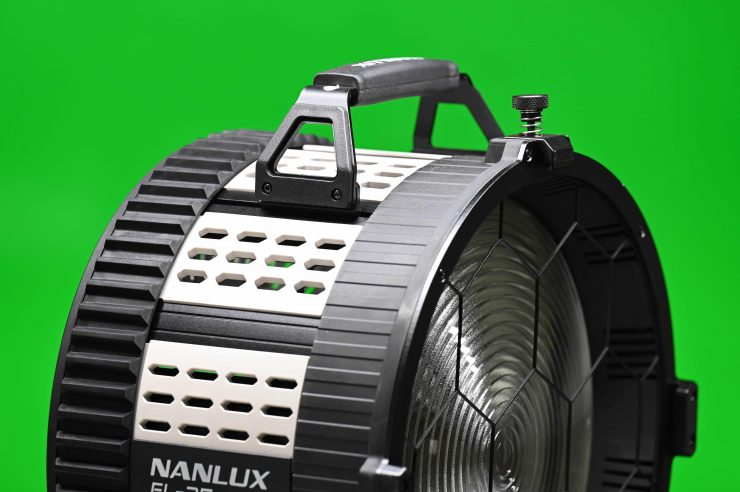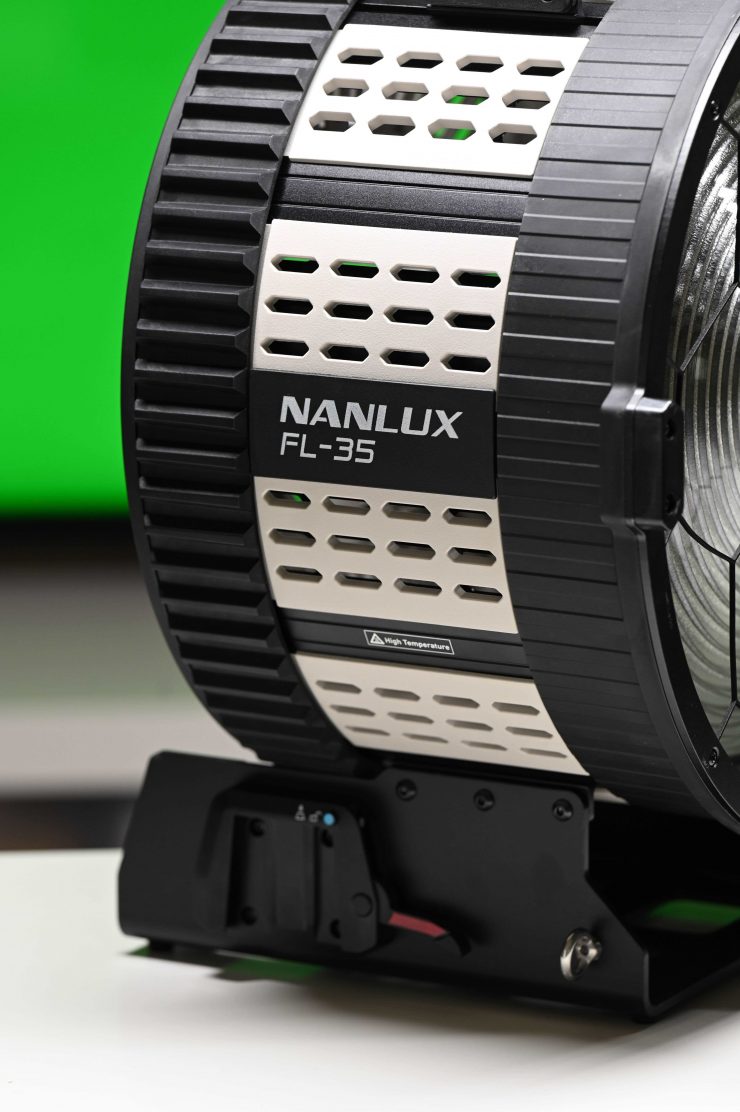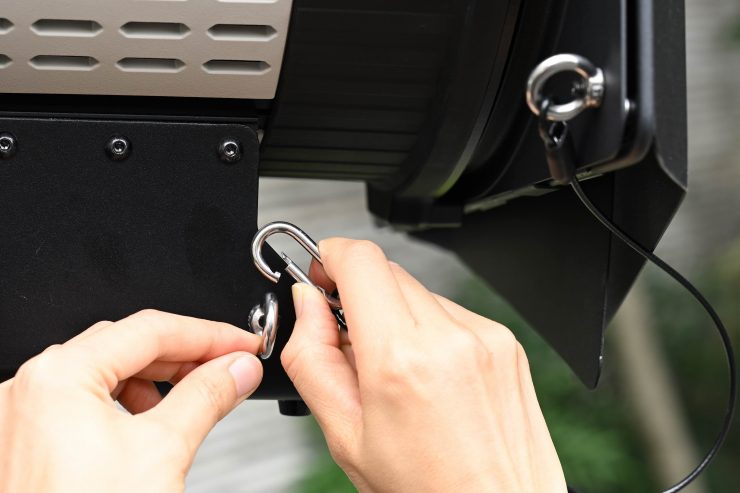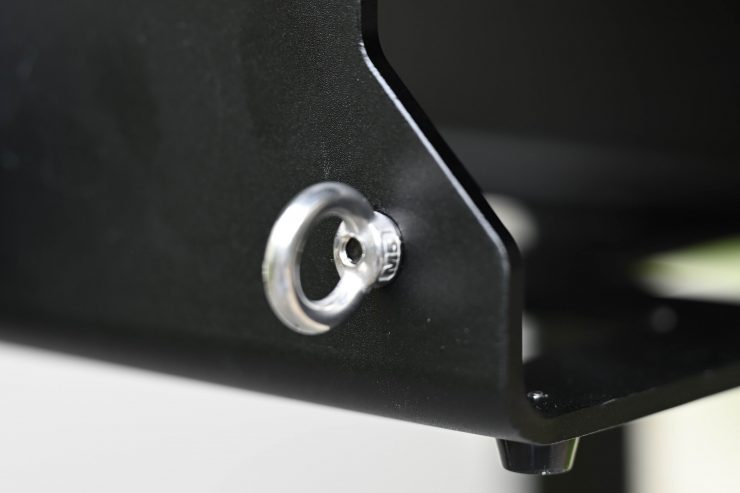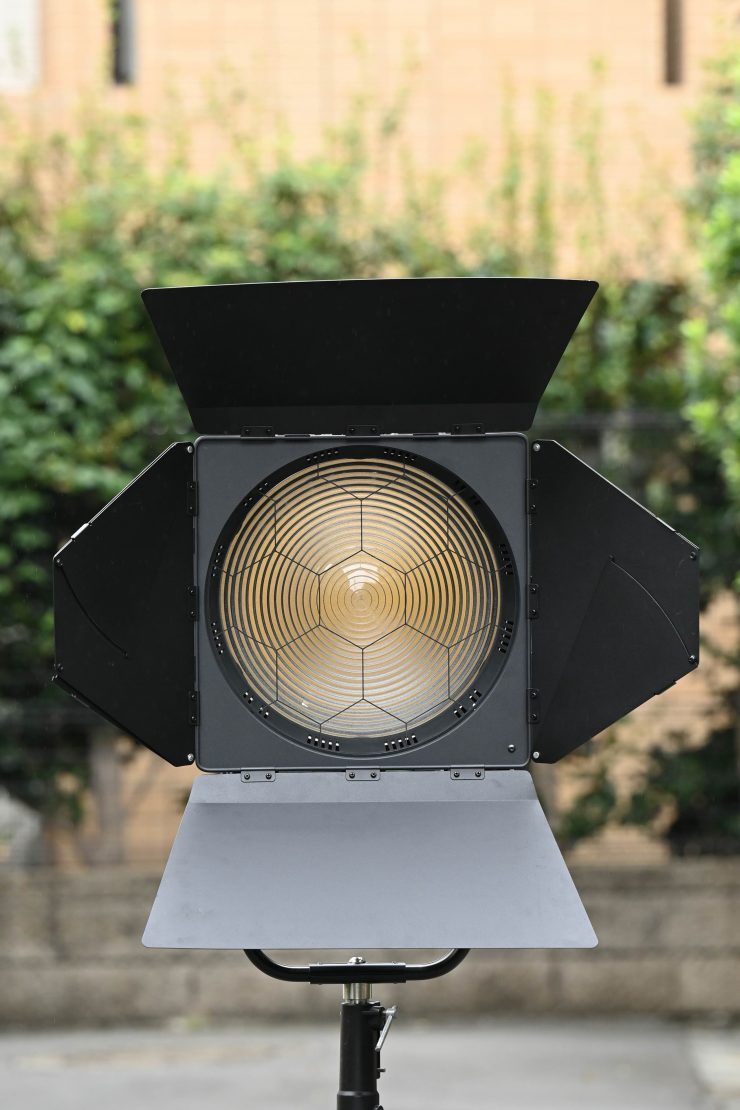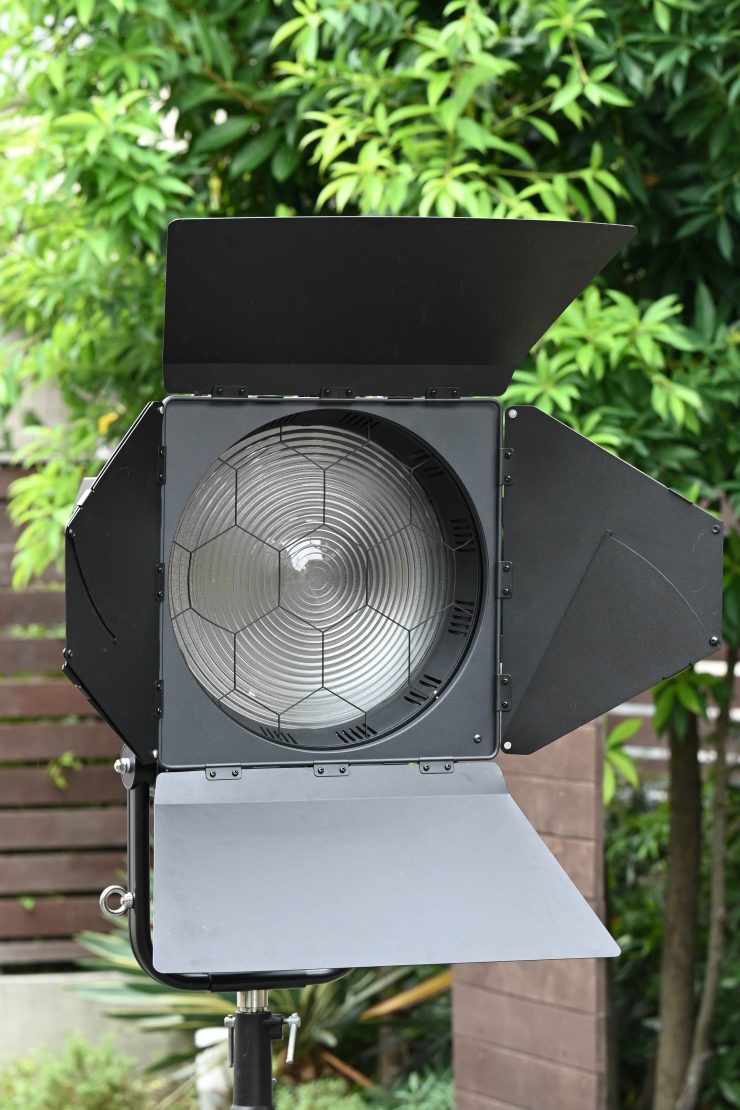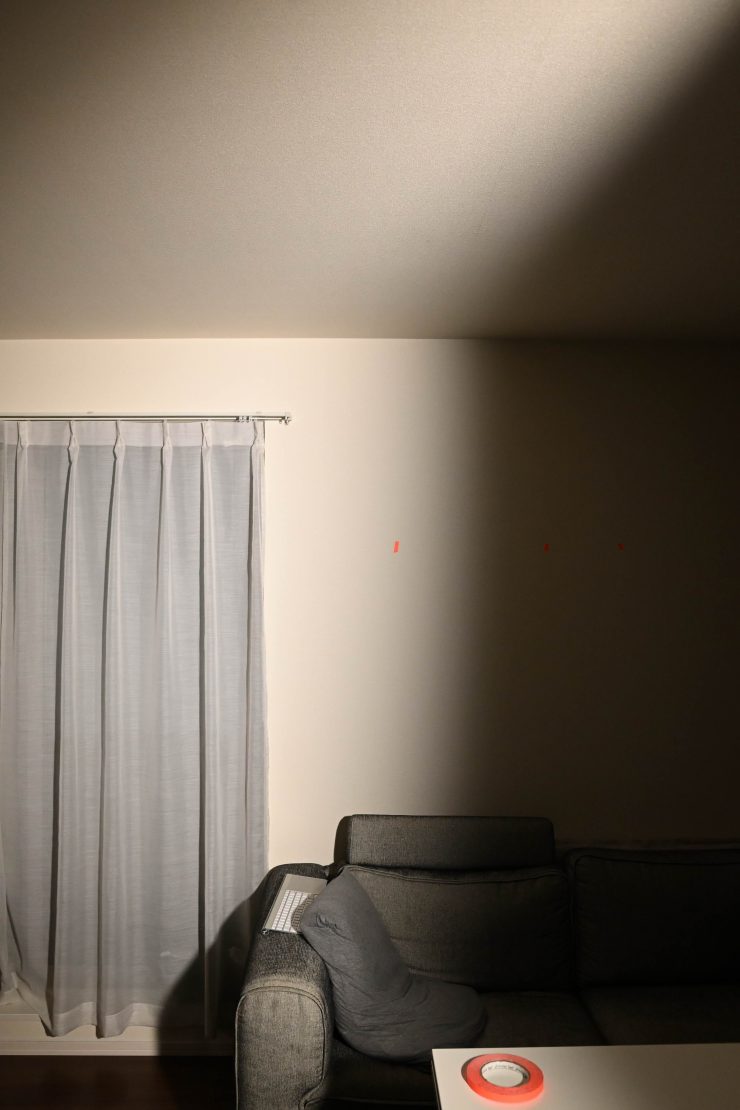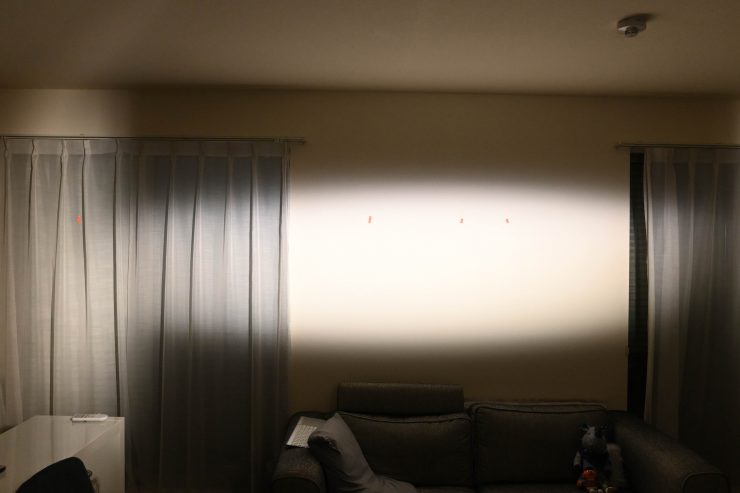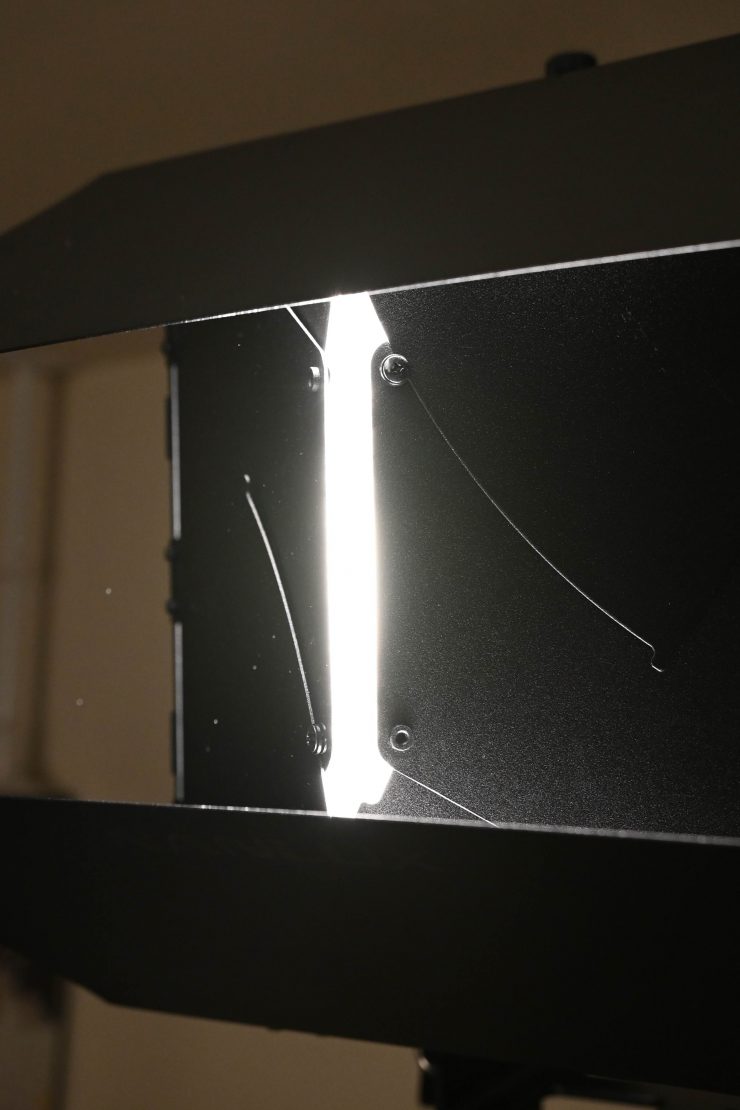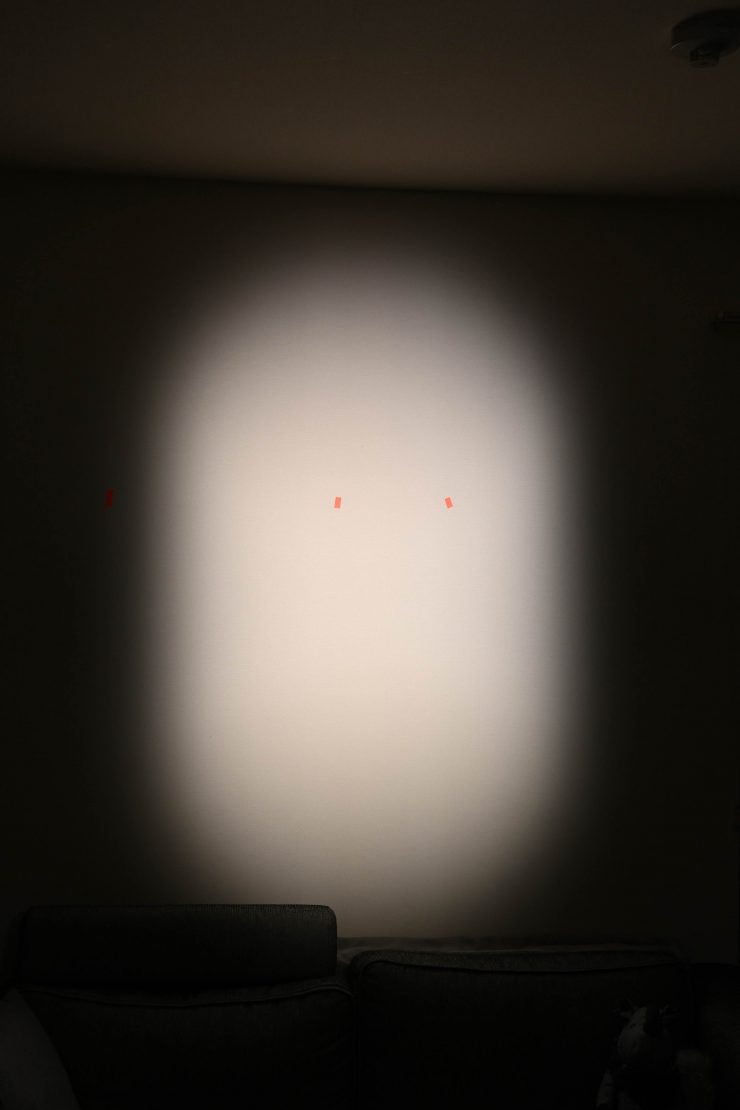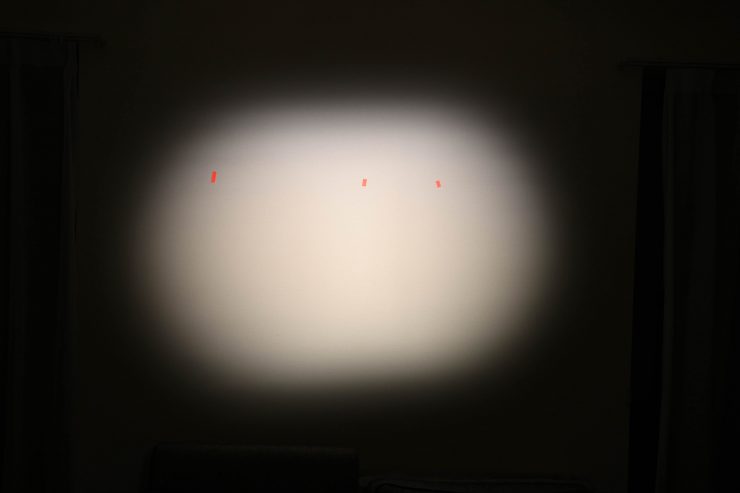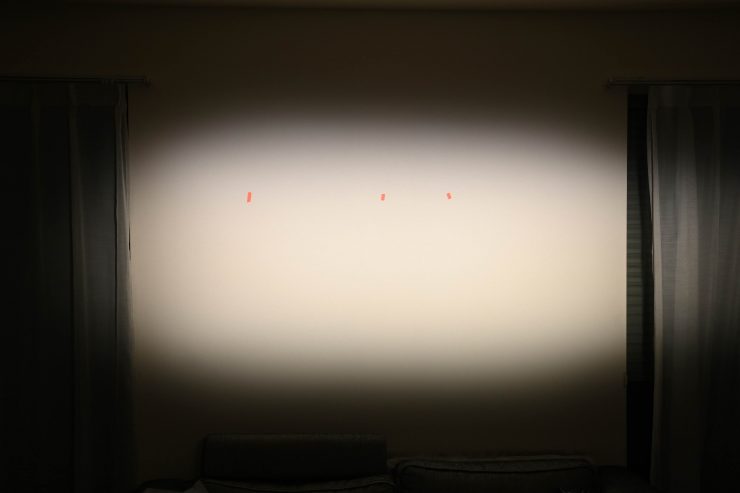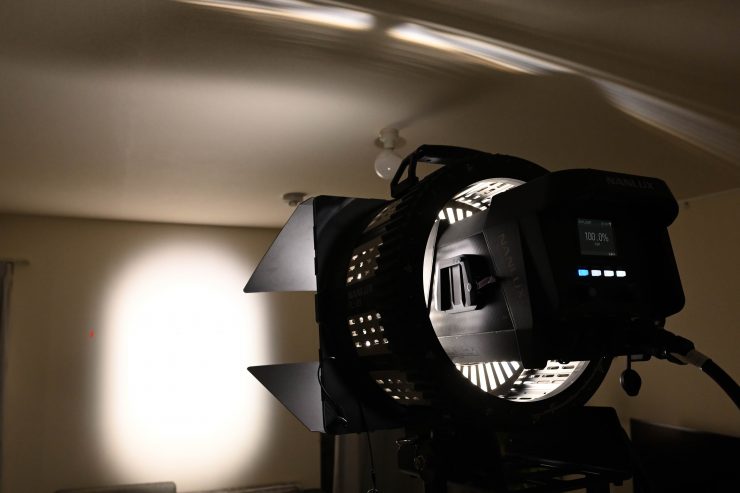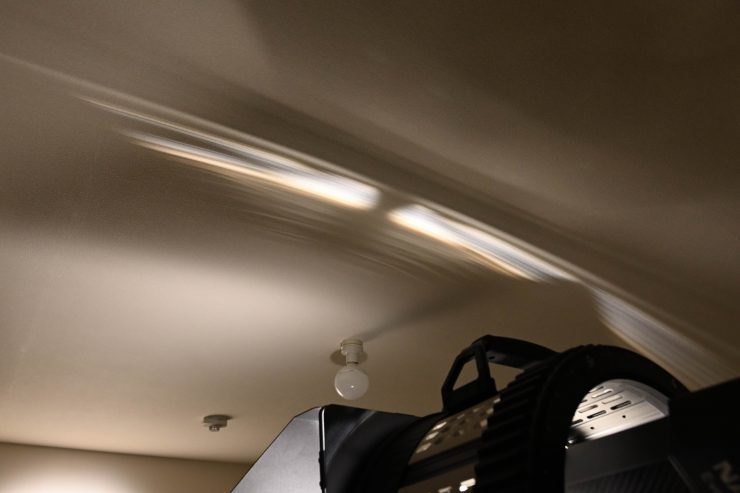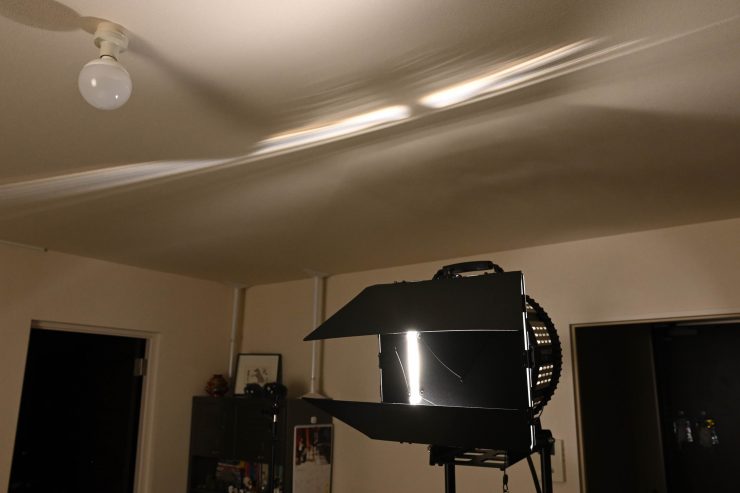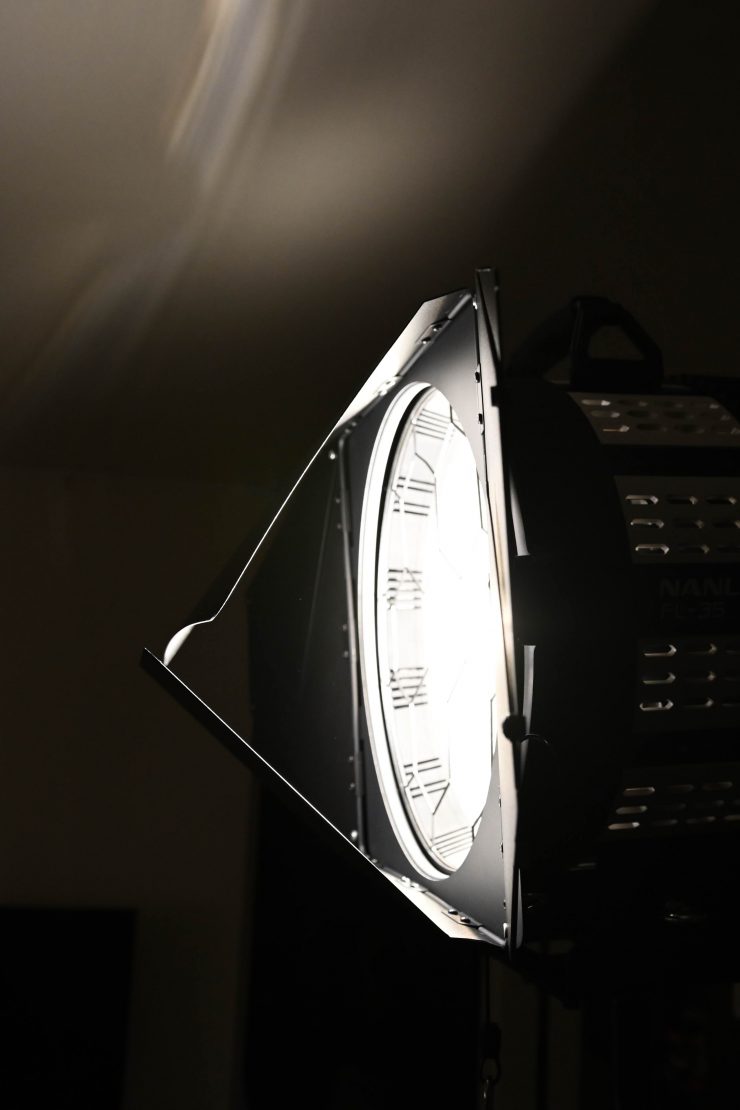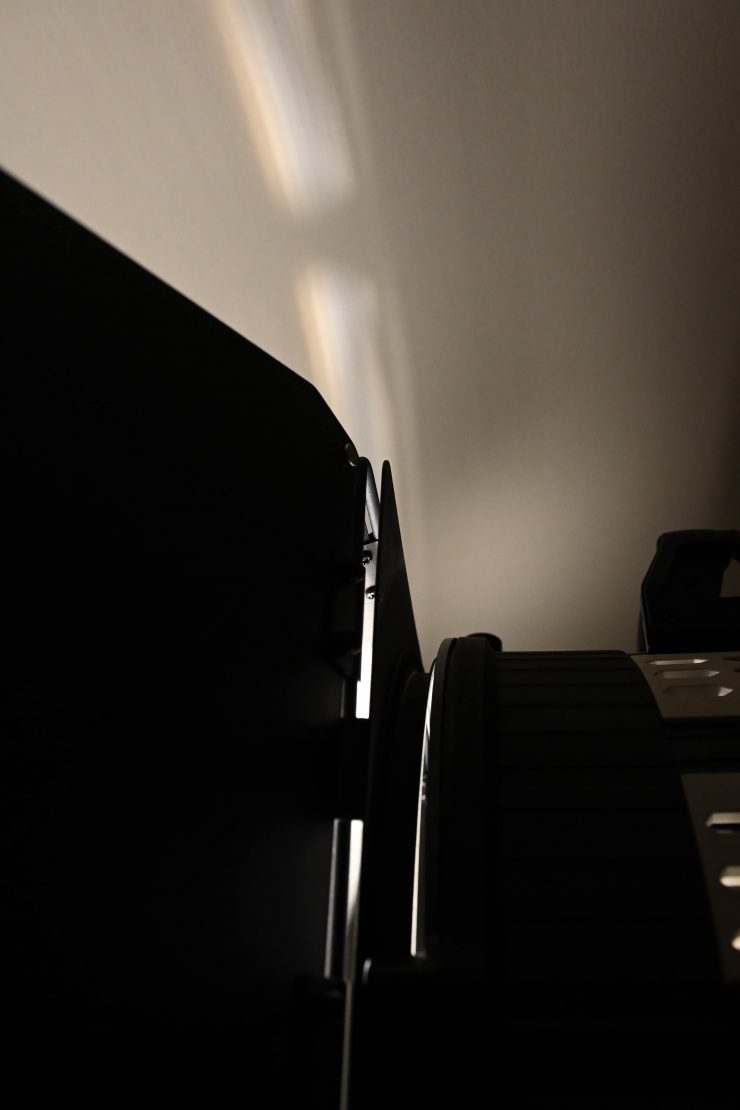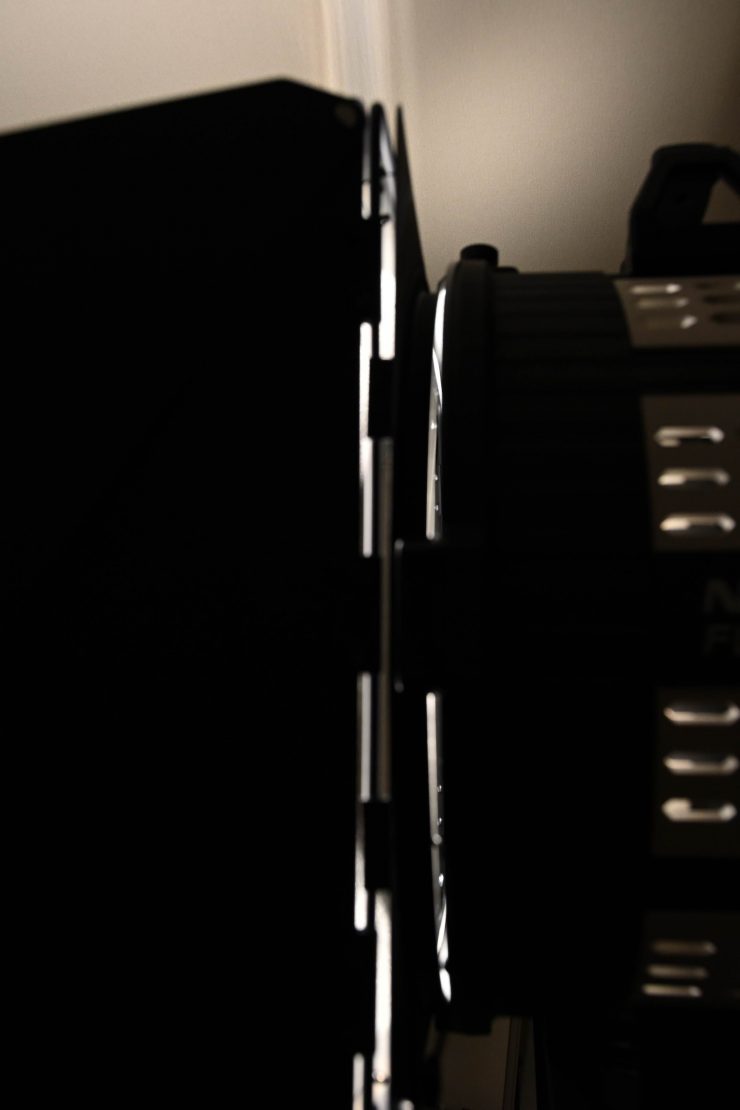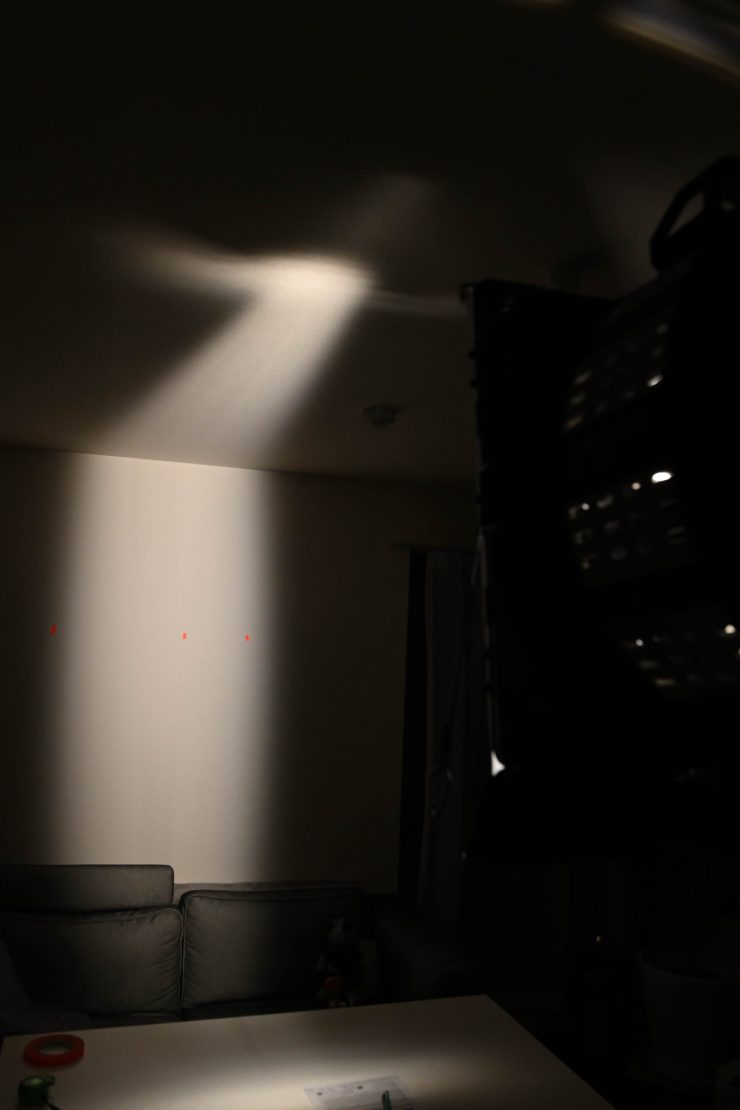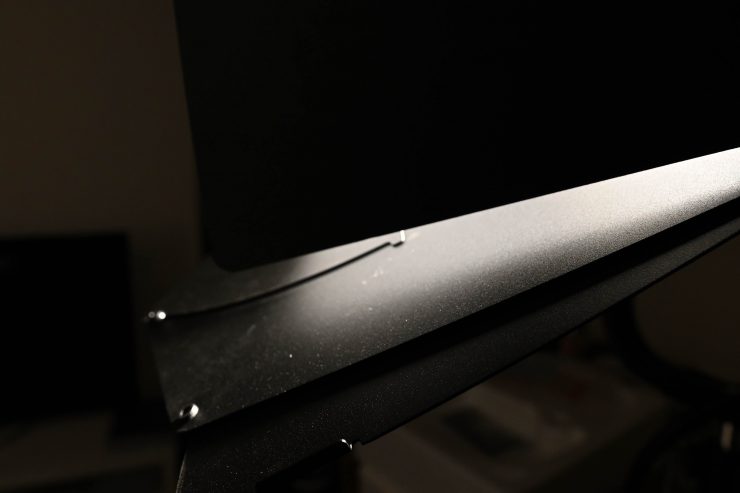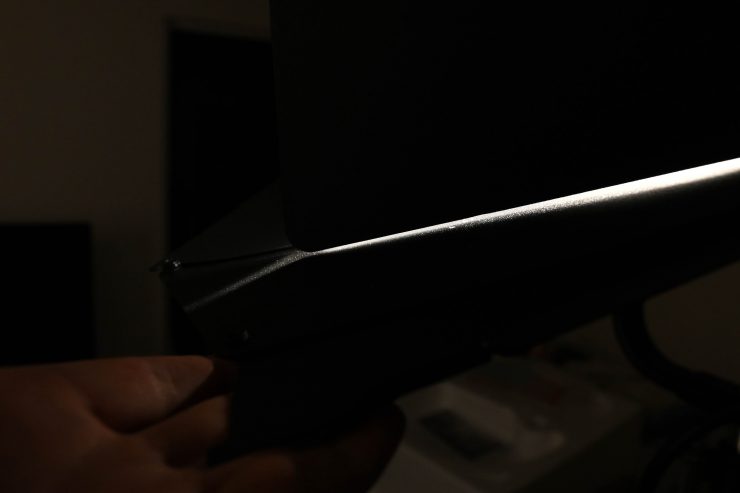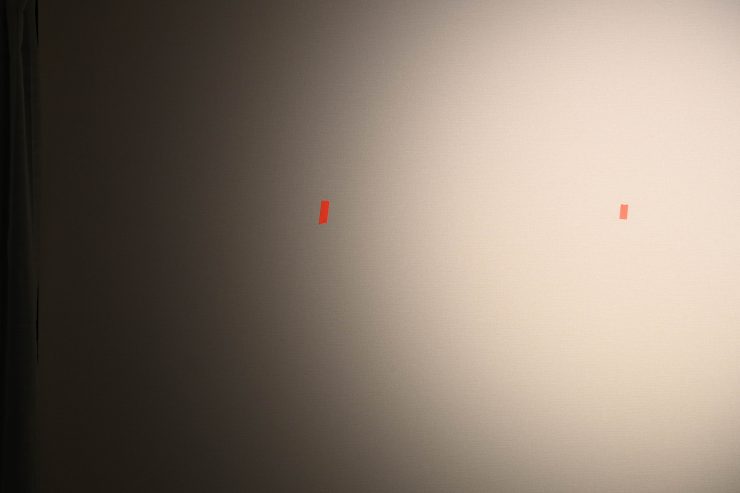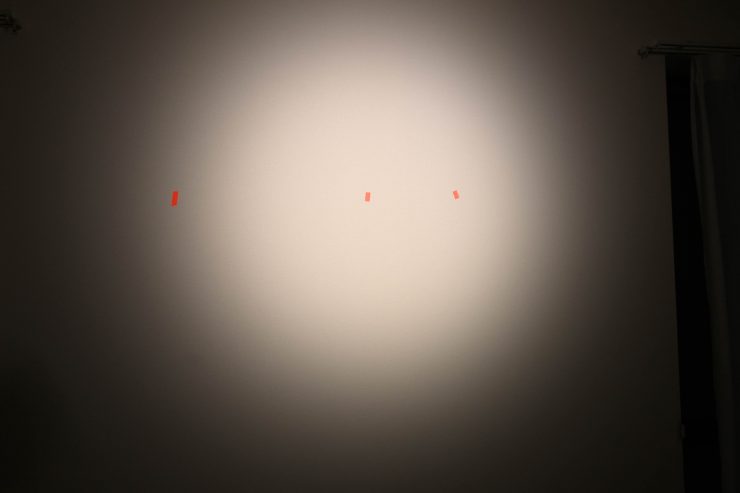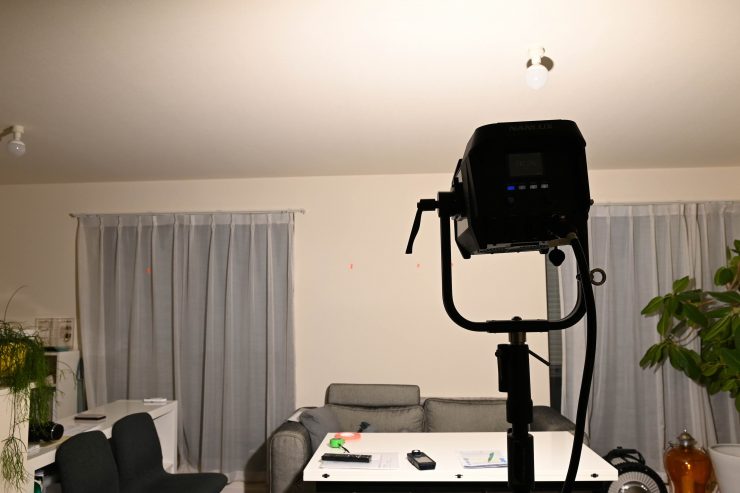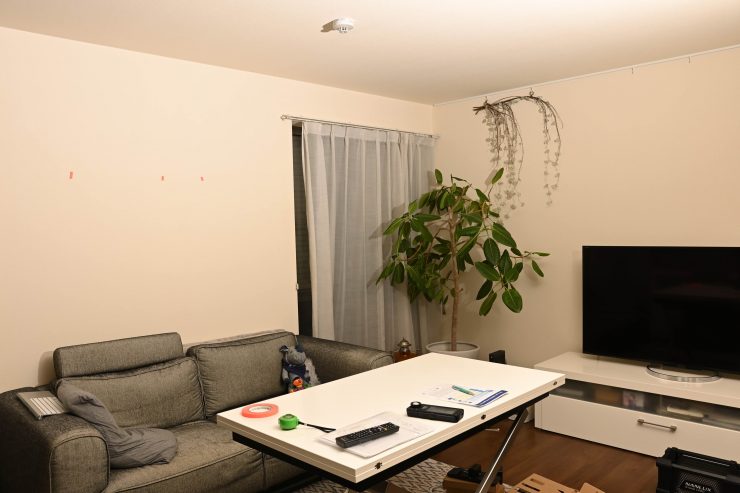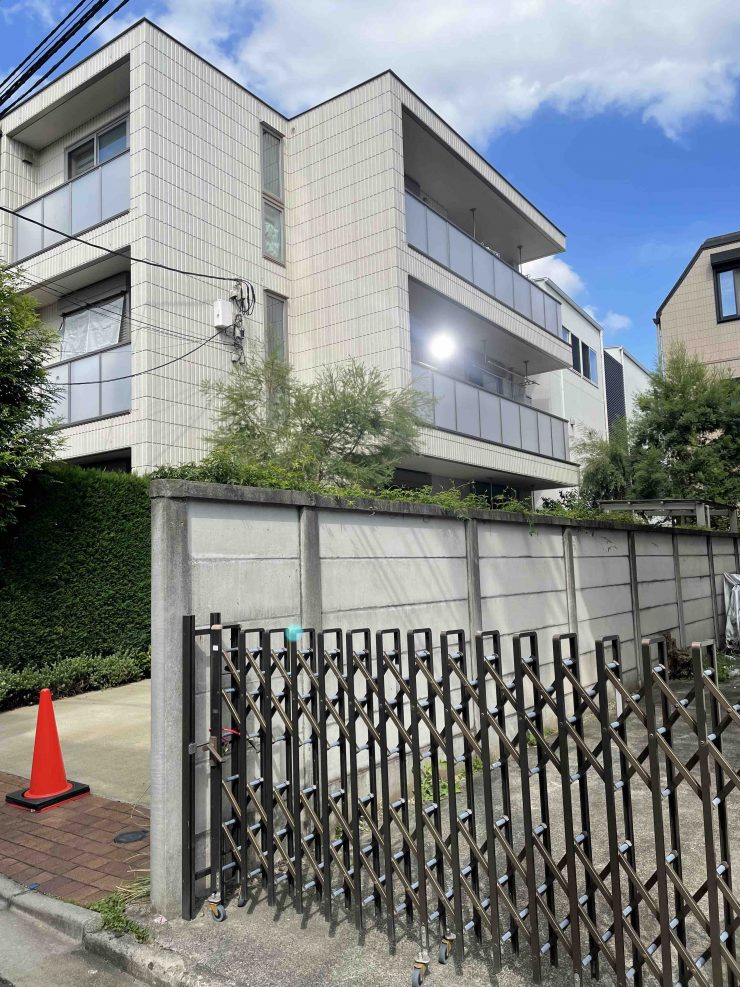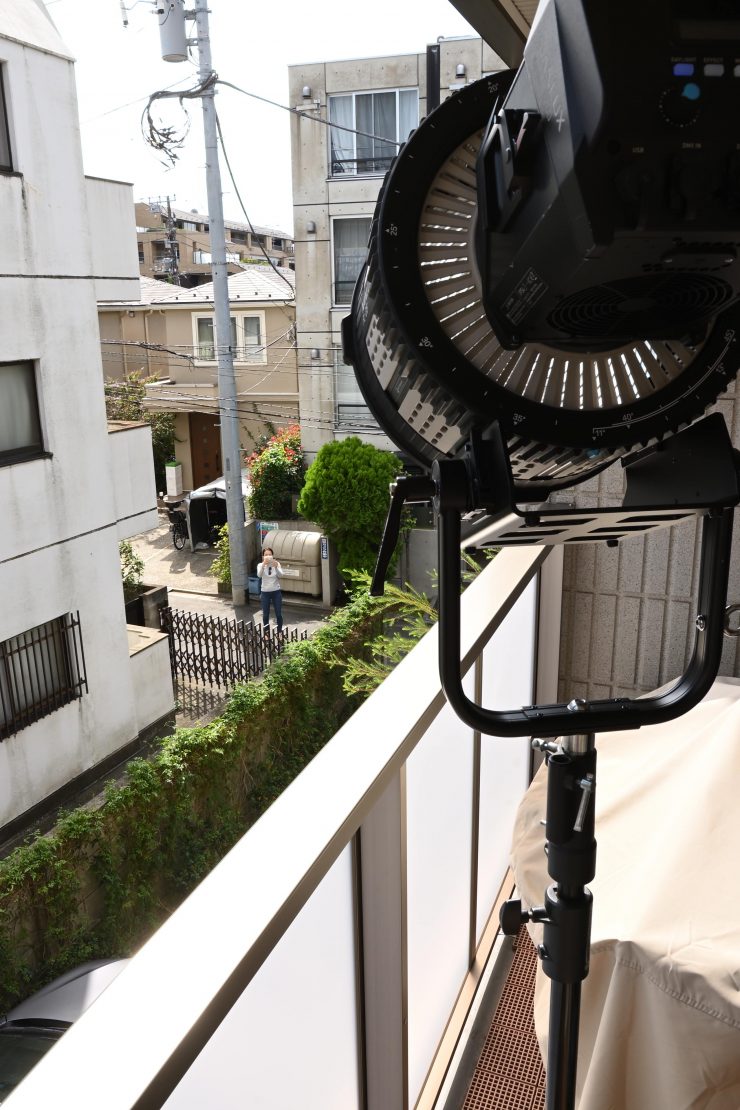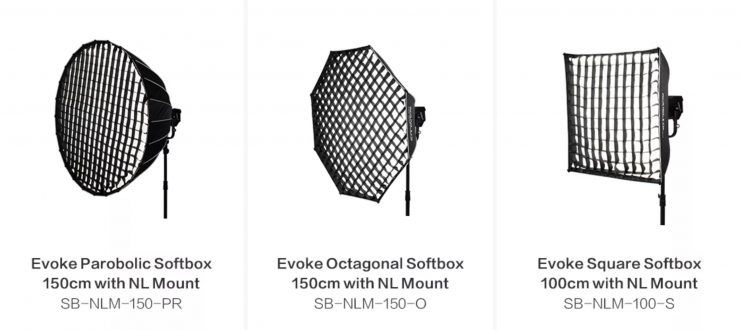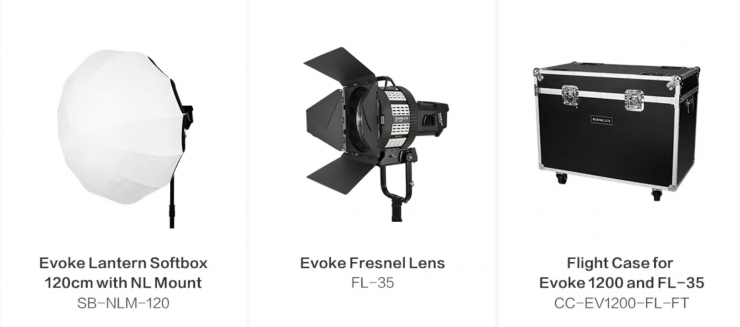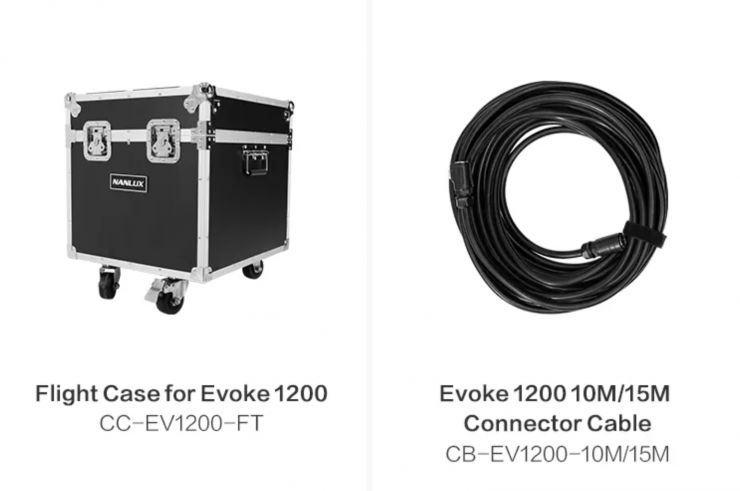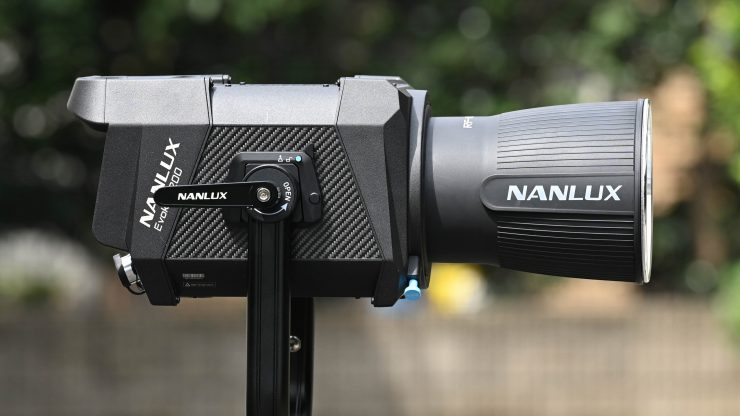
The Nanlux Evoke 1200 LED Spot Light is a high-power draw LED spot light with a 120° beam angle. It is available in either daylight or tungsten versions.
The Evoke 1200 can be used with a wide array of lighting modifiers from a Fresnel, to softboxes, to a reflector. Multi versatile fixtures are becoming increasingly popular and we have seen companies such as ARRI, Aputure, and Godox, etc. making lights that fit this mold. Having one fixture that you can modify to perform a variety of tasks simply by adding light modifiers makes a lot of sense.
Even though there are quite a lot of versatile LED lights on the market, there aren’t many that have high power draws, especially ones that draw over 1000W.
So, let’s get on with the review and see if the Evoke 1200 lives up to the hype.
Concept & Design
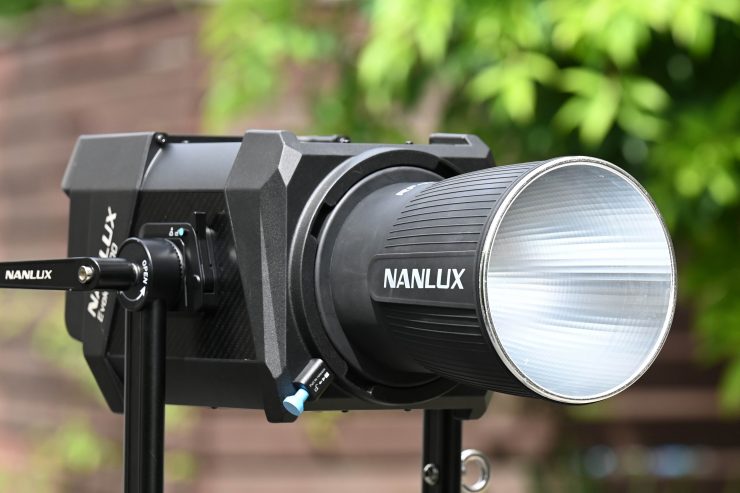
The concept behind the Evoke 1200 was to make a high-quality, affordable, and powerful LED spot light that could be run from a normal household power outlet. There are lots of similar types of lights out there on the market, but most of them aren’t being targeted as replacements for high output HMI fixtures.
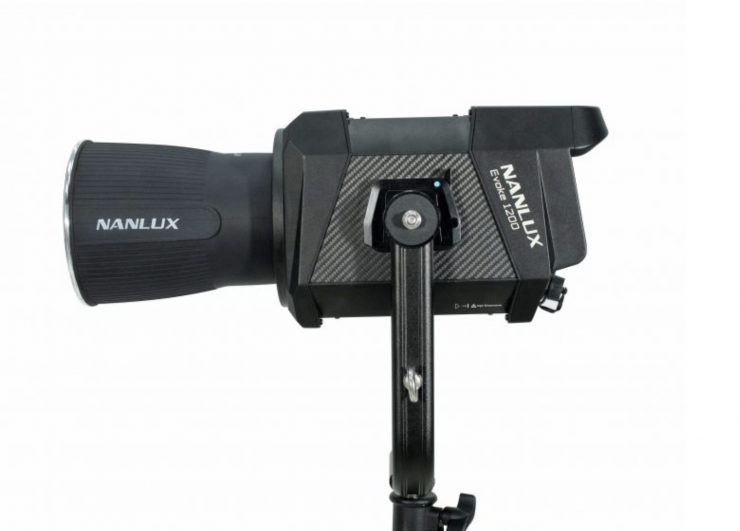
Evoke 1200 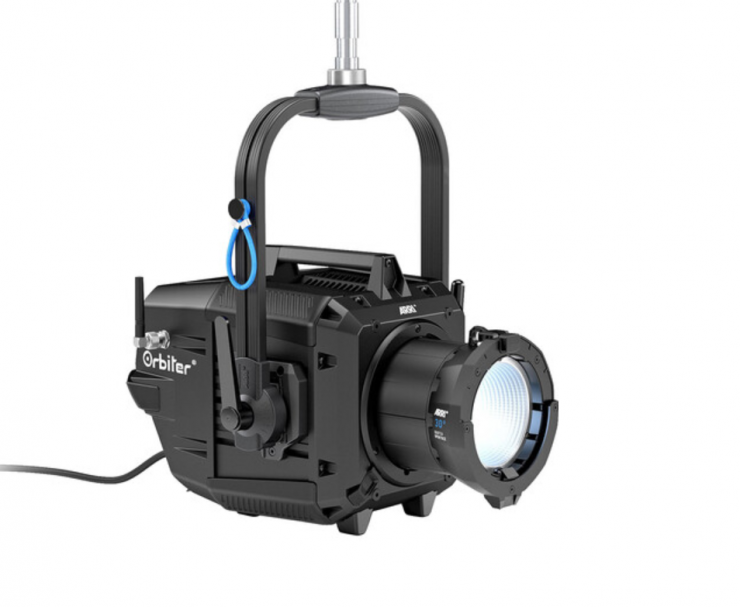
ARRI Orbiter.
In a lot of ways, the Evoke 1200 looks very similar to an ARRI Orbiter. The optical mount, quick release yoke frame, and basic shape have certainly taken their design cues from the Orbiter. Whether this is coincidental or on purpose, I’ll let you decide.
Nanlux claims that the Evoke 1200 out-performs almost any comparable luminaire. The company also claims that Evoke’s output is comparable to that of a 1.8kW PAR or 2.5kW HMI Fresnel. That is a fairly big claim, as most 2.5K HMIs are capable of a ton of output.
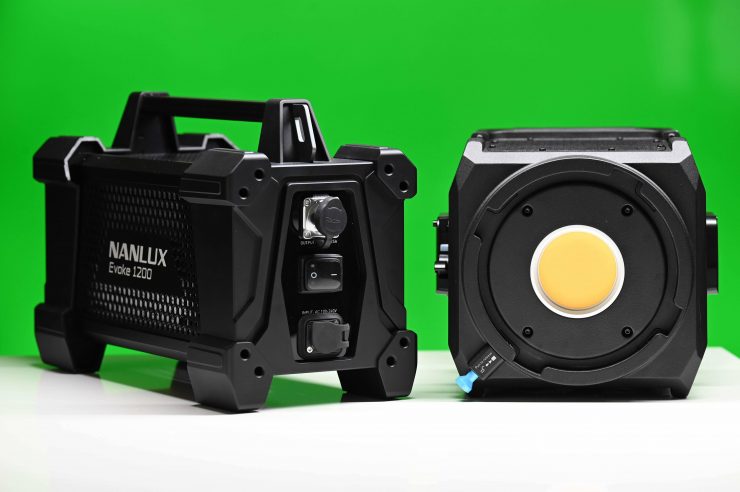
The Evoke 1200 consists of a light head and a rather large power supply unit. This is fairly common with lights such as these.
A lot of today’s modern lights are now a seamless blend of hardware and software. The Evoke 1200, like so many of the new lights coming to market, follows that same path. With software playing such a big role, lighting companies can continue to improve and update fixtures over time via firmware updates. This does give them somewhat of an advantage over older fixtures. Although, in the case of the Evoke 1200, it is a daylight-only fixture so there is not going to be a lot that they can probably change via firmware updates.
Quite a few LED lights on the market, including the Evoke 1200, are using COB technology. COB stands for “Chip On Board” where multiple LED chips are packaged together as one lighting module. The advantage of COB LEDs being multi-chip packaged is that the light-emitting area of a COB LED can contain many times more light sources in the same area that standard LEDs could occupy. This results in a greatly increased lumen output per square inch. The caveat with COB LEDs is that they produce a ton of heat and that heat needs to be effectively dispersed. You also need to diffuse them as they are very bright to look at and unsuitable for directly lighting talent.
What do you get?
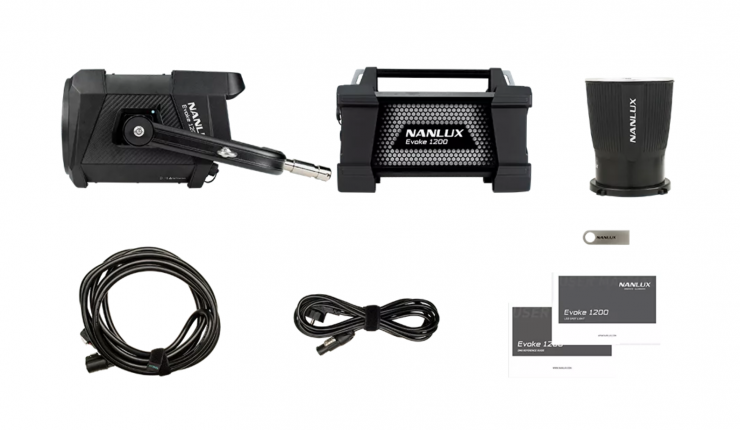
The Evoke 1200 comes with the following items:
- Evoke 1200 × 1
- Yoke × 1
- Power Supply × 1
- Reflector × 1
- DC Cable 5M × 1
- Power Cable 4.5M × 1
- USB Flash Drive × 1
- User Manual × 1
- DMX Reference Guide × 1
- Thank You Card × 1
The light doesn’t come with a case, but Nanlux does make two optional flight cases. They are:
Now, the issue is these flight cases are massive and also heavy. The Flight Case for Evoke 1200 and FL-35 weighs 28kg / 61.73lb and it has physical dimensions of 850 × 470 × 700mm / 33.46 × 18.5 × 27.56″. If you put the Evoke 1200 and its standard accessories, as well as the FL-35 Fresnel, the total weight is going to be around 59kg / 130 lb! This means there is no way you can check this in on a commercial aircraft. If you needed to take it somewhere on a job that was interstate or overseas where you needed to fly then you would have to ship it separately.
The Flight Case for Evoke 1200 tips the scales at 19kg / 41.88 lb. Yes, this is lighter than the case that holds the light and the Fresnel, but even it will still be too heavy to check in on a commercial flight once you put everything needed inside of it.
If you did need to fly, the best way would probably be to find some sort of soft/hard case that doesn’t weigh that much that you could fit the Evoke 1200 and the power supply in. The F-35 Fresnel is going to be a difficult accessory to find any type of third-party case for.
You clearly need to know with large and heavy light such as the Evoke 1200 what you are getting into before purchasing. How you store and transport the light need to be considered carefully.
Build Quality
The overall build quality of the Evoke 1200 light head and power supply is pretty good. In my personal view, it feels like Nanlux has definitely thought about who is likely to use the Evoke 1200 and they have built it accordingly. While it doesn’t have the build quality or finish of an ARRI, it is still solidly made for its price.
This is a light that will presumably find its way into a lot of rental houses, and generally, rental houses only want to stock products that are robust and reliable.
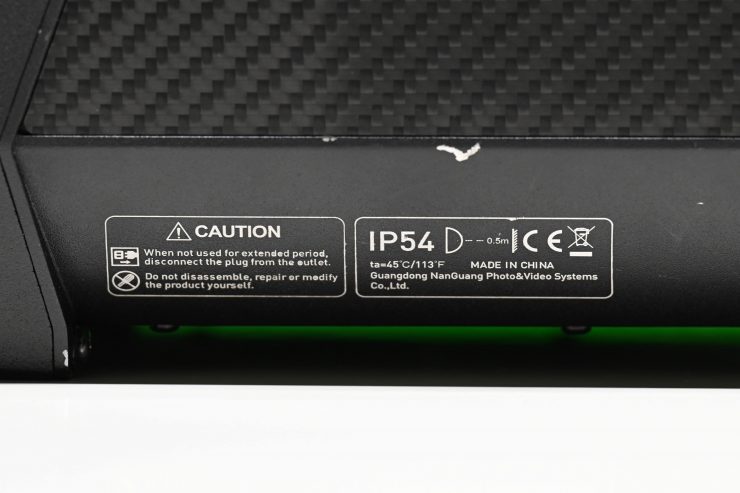
The Evoke 1200 is IP54 rated. IP54 means that the light is protected from limited dust ingress and from water spray from any direction.
The power supply is even more robustly made than the light head. It is certainly one of the most solidly made LED power supplies I have seen.
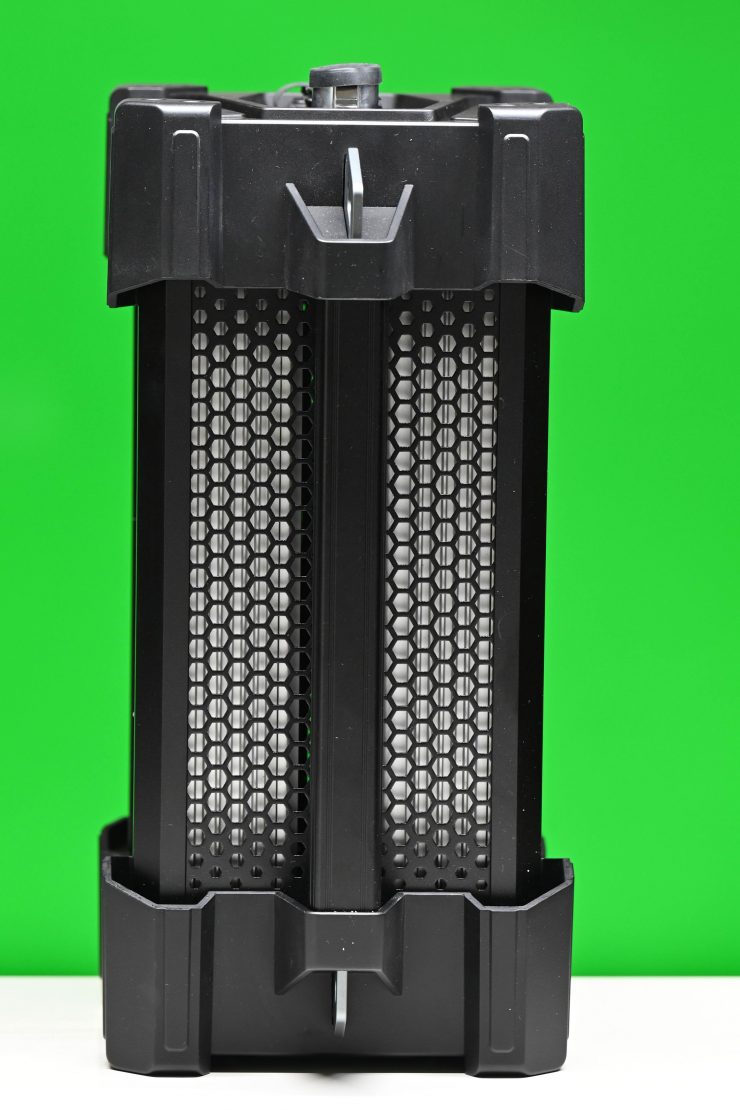
I like that Nanlux has put all of the input and output connectors on one end of the power supply. This allows you to stand it up vertically if need be. They also put eye-bolts on the carrying handle so you could actually use it as ballast and attach it to a light stand or other equipment.
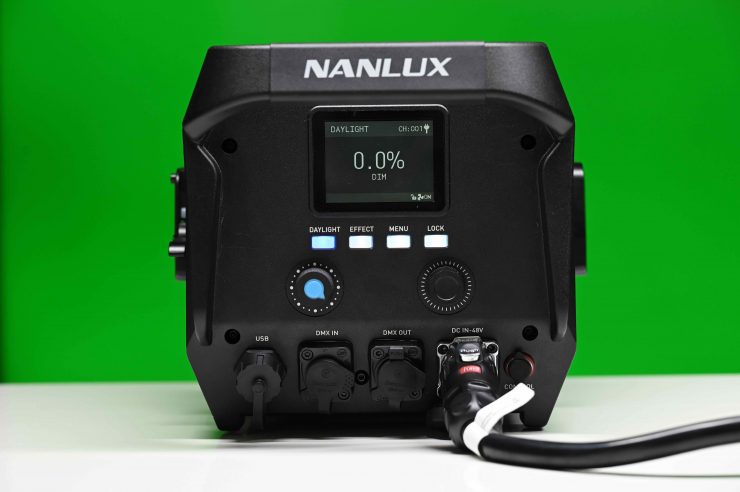
The Evoke 1200 uses really thick power connection cables. The cable that goes from the light head to the controller is nice and long (5m / 16.4′) so you can put the light up very high and the cable still easily reaches the ground.
Weight & Size
The Evoke has physical dimensions of 330 × 241 × 210mm /12.99 × 9.48 × 8.26″ (without the yoke). It tips the scales at (6.94kg / 15.3lb) with the yoke attached.
While the physical size and weight of the Evoke 1200 light head aren’t too bad, once you factor in all of the components that are required, the whole package does start to get very heavy.
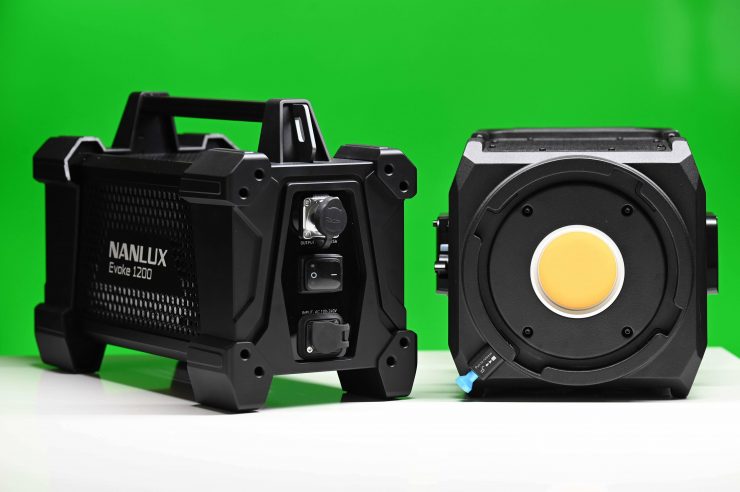
The combined weight of the light, power supply, power supply cable, reflector, and 5m connecting cable was 21.92 kg / 48.35 lb.
What you need to clearly factor in is the power supply alone weighs in at 10.5kg / 23.14lb.
So how does the weight of the Evoke 1200 compare to some 1200W HMI fixtures?
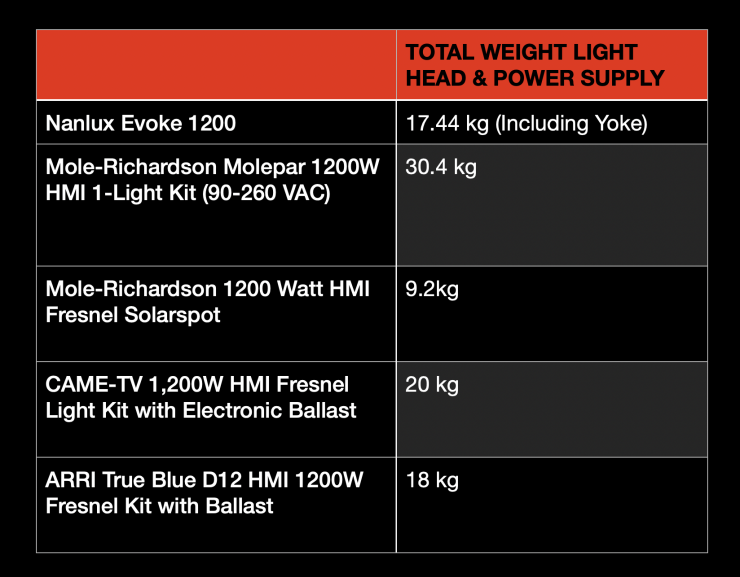
With these weight comparisons, it is important to remember that the Evoke 1200 isn’t an HMI Fresnel. Once you add the optional F-35 Fresnel to the Evoke 1200, then it actually weighs more than all of these other lights, except the Mole-Richardson Molepar.
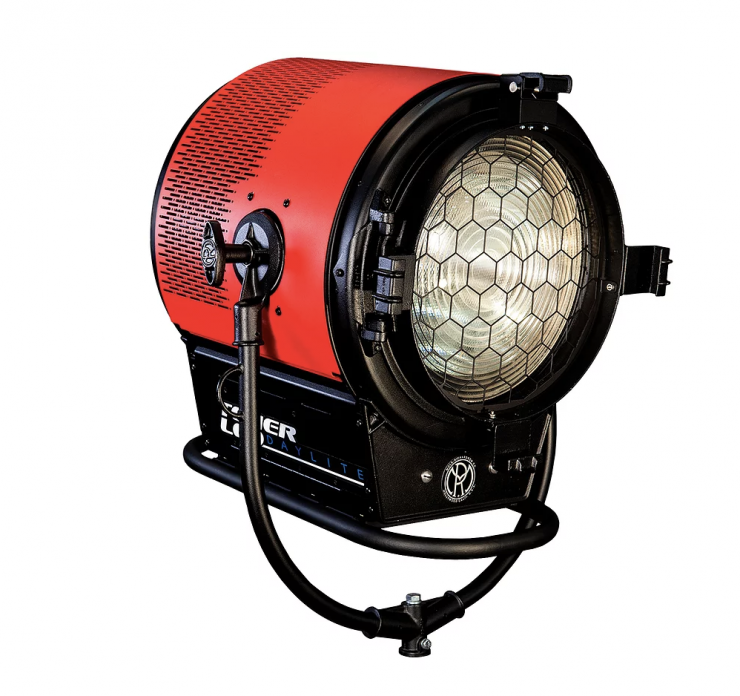
As another comparison, the Mole-Richardson 1600W Tener LED (Daylight) tips the scales at 31.80 kg. Yes, this is a higher power draw (1600W) LED light, but it does provide a good comparison against the Evoke 1200.
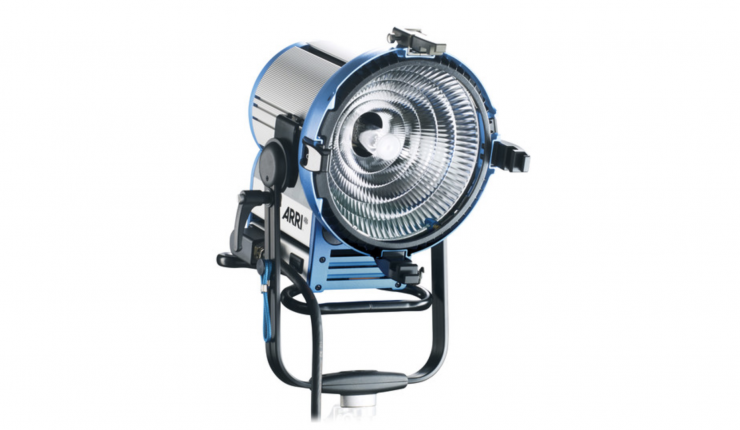
How does the weight compare to a light such as the ARRI M18? Below you can see:
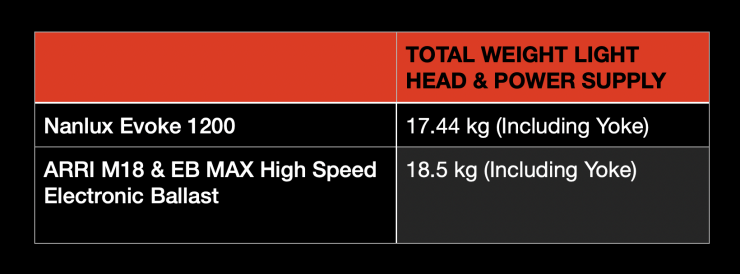
There isn’t much difference in weight if you compare the Evoke 1200W to an M18. However, what you also need to remember is that the M18 is an HMI Fresnel, and the Evoke is not. If you add the optional F-35 Fresnel attachment to the Evoke 1200, then it is going to be way heavier. The F-35 Fresnel weighs 9.05kg / 19.95lb.
Despite all the marketing hype, the Nanlux Evoke 1200 isn’t going to be any lighter than some of the HMI Fresnel fixtures that have a similar output.
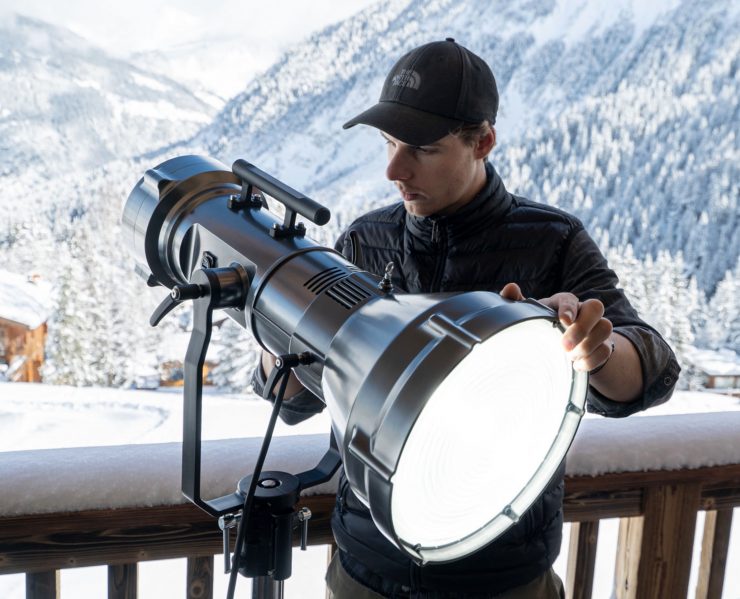
Maxima 7 & Maxima 7 Fresnel Lens 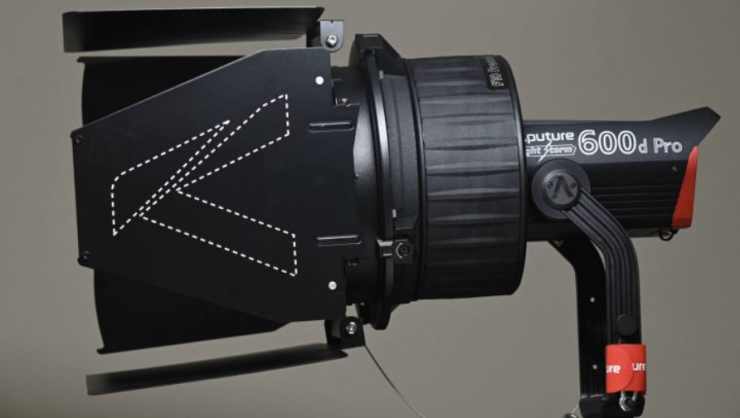
Aputure LS 600d Pro & F10 Fresnel
So how does this weight compare to other similar style LED lights that don’t draw as much power such as the 700W Maxima 7 and the 720W Aputure LS 600d Pro? Below you can see.
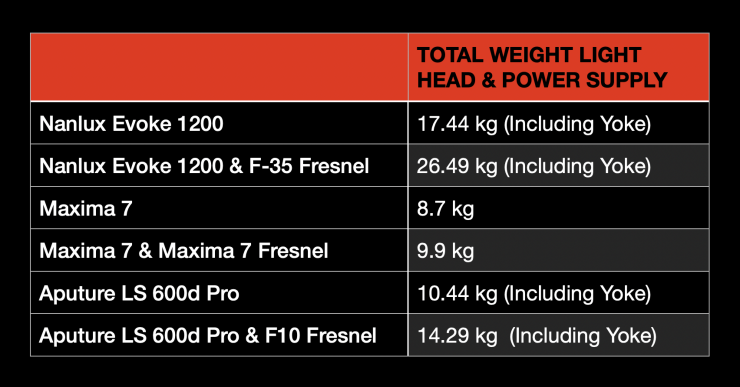
It is no surprise that the Evoke 1200 weighs a lot more than similar LED fixtures with lower power draws.
Mount
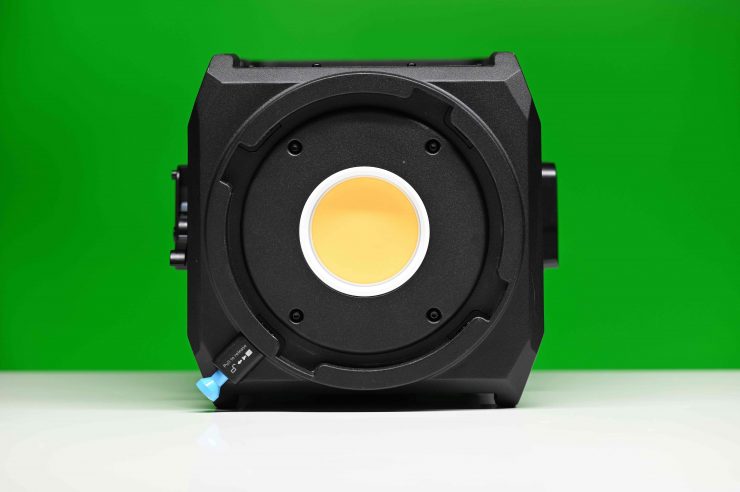
While a lot of versatile spotlights utilize a Bowens-S mount, Nanlux has followed the same path as ARRI and come up with its own proprietary mount. This means you will have to purchase lighting modifiers that have been designed specifically for this fixture.
Why a proprietary mount? Well, that is a simple question to answer. Because of the size and the type of light the Evoke 1200 is, there is no way a Bowens mount would have made any sense. Nanlux needed to use a very strong, robust, mount with a locking mechanism to support the weight of attached accessories.
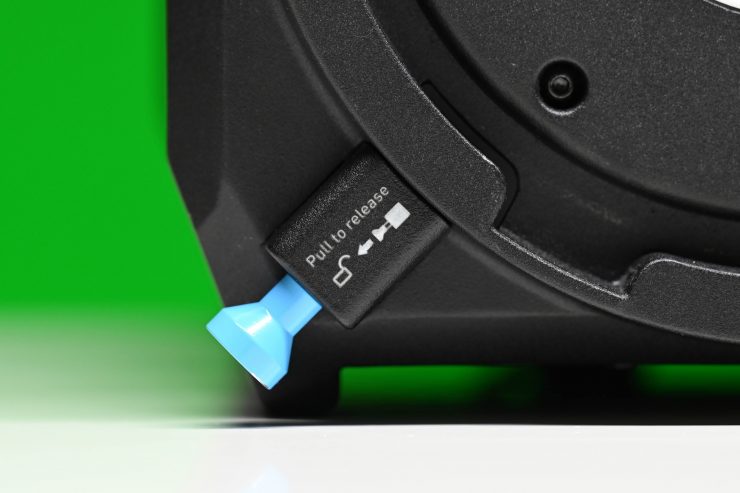
There is a small locking pin that you have to pull out to remove anything that is attached to the Evoke 1200.
Above you can see how the mount system works. In this example, I am removing the Evoke 1200 from the F-35 Fresnel. In a way, it is almost like removing a lens from a camera mount, just on a lot larger scale!

The mount is very robust and nothing you attach to it wobbles around. It has been designed to support a lot of weight.
Yes, a Bowens-S mount would have allowed for a far wider array of affordable light modifiers to be used, but given how the Evoke 1200 works, and the fact it has to support a ton of weight, a proprietary mount was the only real option Nanlux had. Again, as I will continue to emphasize throughout the review, you need to factor this in when deciding on whether this is the right light for you or not.
Quick Release Yoke Frame & Mounting System
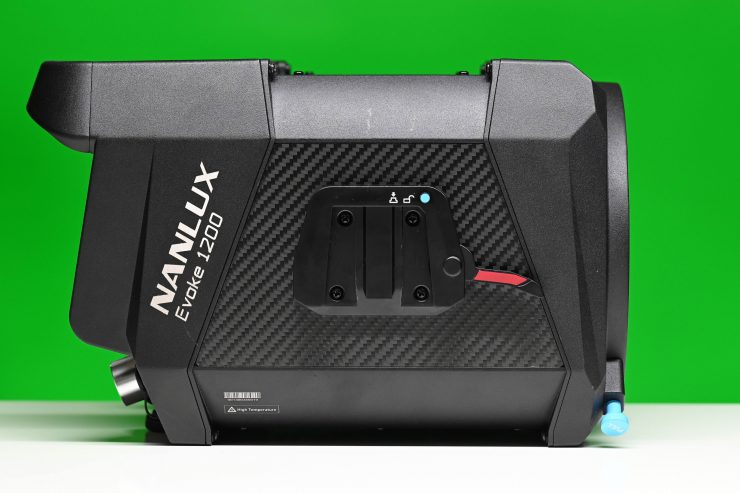
The Evoke 1200, just like the ARRI Orbiter, utilizes a quick-release yoke mounting system.
Essentially there are two quick-release mounting slots on either side of the Evoke 1200. These are sort of similar to V-lock battery mounting plates.
On the yoke frame, there are two mounting points that slide into the quick-release mounts. The problem with this design is that they are never lined up correctly. As the yoke frame only has a single lock-of mechanism, you can’t adjust the mounting plate on the opposite side unless you have a tool. This means that you have to align the mounting plate on the lock-off side to match the other side. Sound confusing? It is! To cut a long story short, if both mounting plates aren’t aligned correctly you can’t mount the light to the yoke frame.
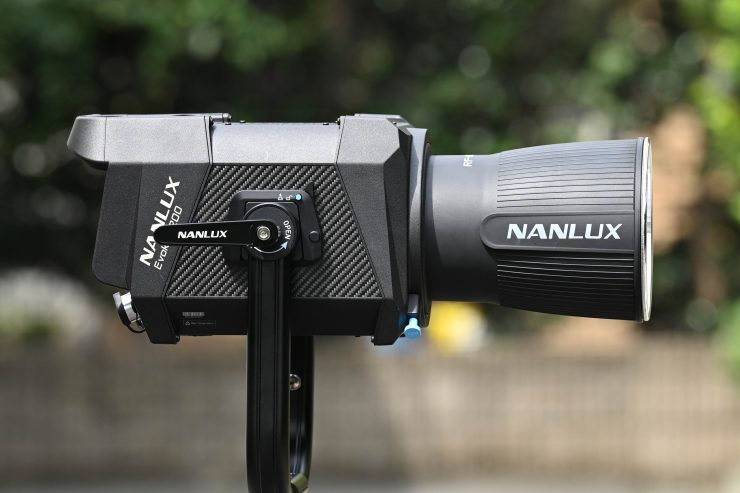
In my opinion, this quick-release mounting system hasn’t been designed as well, nor does it work as well as ARRI’s system on the Orbiter. The first time I tried to mount the light to the yoke frame it took me a good 15 minutes! It is not as straightforward as you may think. After quite a bit of experimenting, I found that the best way was to mount the light was in the side-on position. I also found that it was best to get the side that doesn’t have the yoke lock-off mechanism in first. If you don’t do it correctly you will find that you can’t lock down one side of the mount correctly without using a ton of force.
The Nanlux manual shows two different ways to use the system, but I found that neither of them worked well. You end up pulling or pushing so hard that you think you are going to break something.
Above you can see the process that is involved in securing the light to the yoke frame. Please note that I have made it look a lot easier than it is because I spent a lot of time practicing! It is much easier if you have two people do it than one.
As a comparison, above you can see how easy it is to use ARRI’s system on the Orbiter.
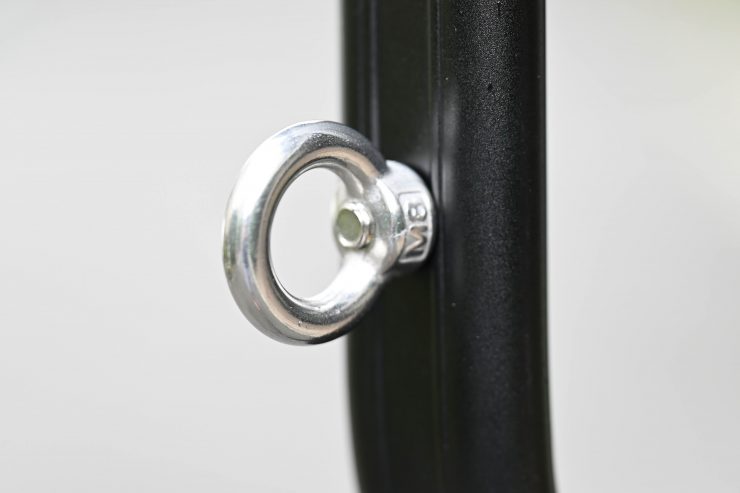
On the Evoke 1200’s yoke frame there is a large eye bolt so you can securely fasten the fixture if need be.
So, is the yoke strong enough? Above you can see a test where I am using the Evoke 1200 and the F-35 Fresnel.
While the yoke frame is strong enough to hold the Evoke 1200 and the F-35 Fresnel, it didn’t offer me what I would call ‘inspired confidence’. Yes, it gets the job done, but I would have preferred to have seen an even stronger yoke frame with dual lock-offs.
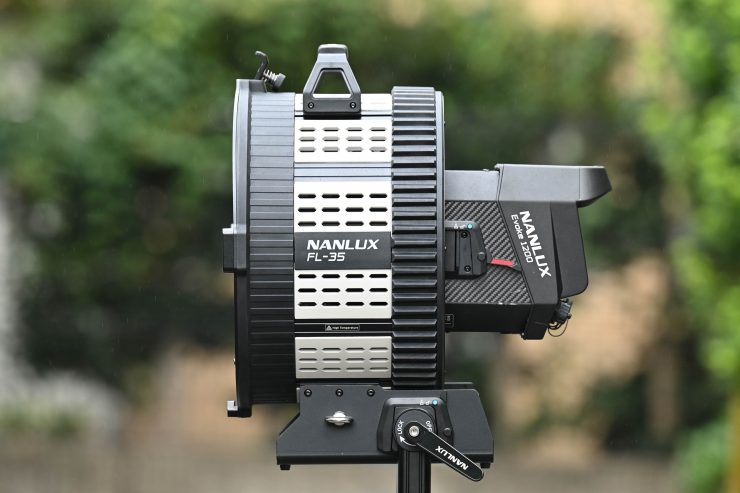
When you attach the Evoke 1200 to the F-35 Fresnel the yoke frame has to support 15.99kg. If you are using this combination in the full flood position, then all the weight is towards the front and it isn’t evenly distributed.
The light I was reviewing did have a loose junior pin on the yoke frame, and although this is hardly a big deal, it does show me that with a light like this you do need to take extra care and you will have to periodically tighten components. I couldn’t tighten the junior pin because it requires a very large Allen key and the light doesn’t come with one.
Power Draw
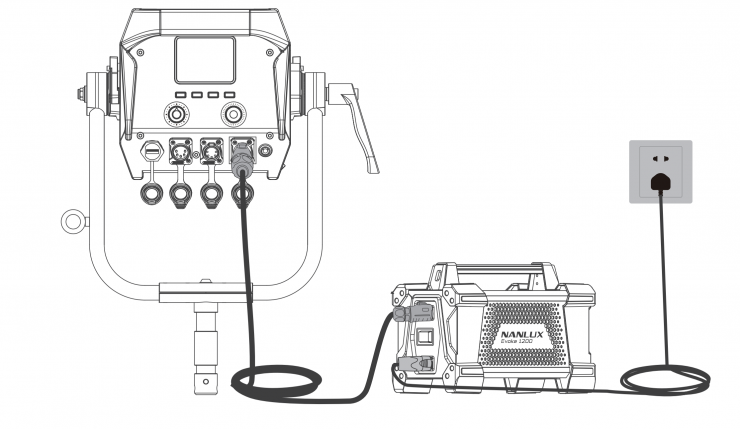
The light draws 1200W which is a lot, however, it can still be run via any household AC outlet. If you wanted to use a traditional HMI that would give you a similar output to the Evoke 1200 you would have to use something like a 1.8K, 2K or 2.5K. Once you get above 1800W you can’t run a light off a household AC outlet. This is one of the biggest advantages a light like the Evoke 1200 has over some older fixtures.
The Evoke 1200 has dual powering options. You can power it through mains power or a DC battery source.
You can run the Evoke 1200 remotely via the 48V (25A max) DC input. However, because of the high power draw, you are going to need something like a Fxlion 1232Wh 15/28/48V Lithium-Ion Mega Battery which will set you back $3,050 USD. Nanlux is also working on its own DC battery solution for remotely powering the Evoke 1200 on location.
Again, and I will keep mentioning this throughout the review, you need to know all of the pros and cons of buying a large light like this.
How does it stay cool?
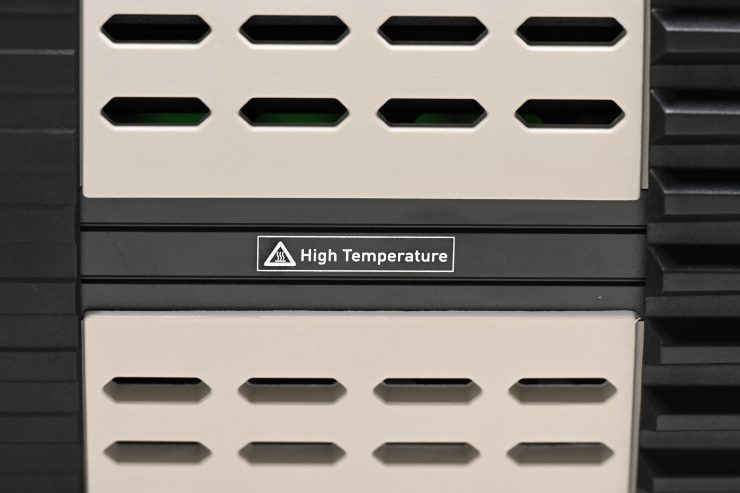
Large, high-powered LED lights get very hot, and keeping them cool is not an easy task. Using fans is the best solution, but the caveat with fans is that they can create noise.
The Evoke 1200 has a very large fan and heatsinks to deal with the heat. In fact, if you look through the top of the Evoke 1200 there is a ton of space just reserved for cooling.
The light only gives you the option of changing the fan speed from On to Off.
This is not a very comprehensive range of fan options! The fan is either on or it is off. You have no way of controlling the speed of the fan.
Nanlux warns that during use you shouldn’t cover, restrict or obstruct ventilation holes, so as not to affect the heat dissipation and cause damage to the fixture. They go on to say, please take care when using the lamp for long periods, as the surface temperature can be high.
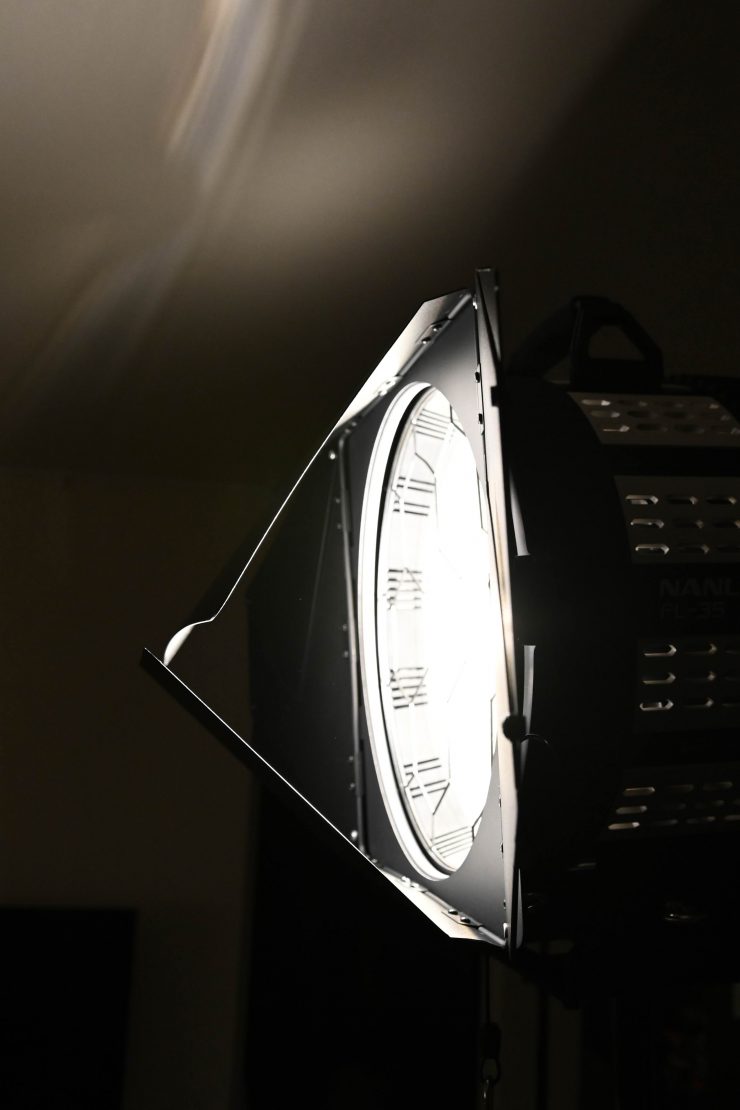
The light does get very hot and I found that when I was using it with the F-35 Fresnel, I couldn’t touch the barn doors after leaving the light on for around 5 minutes. They got so hot that they would burn your fingers.
If you stand in front of the light it feels like you are getting hit by the strong sun on a hot summer’s day.
So what about fan noise?
The fan in the Evoke 1200 does make a fair bit of noise, however, with a light like this it is usually going to be located a fair way away from where critical audio needs to be recorded. In saying that, if you were going to use this light as a key light for an interview I can envision the fan noise being a problem. Even from a cold start, if you set the Evoke 1200 at 0.1% output the fan noise is there straight away.
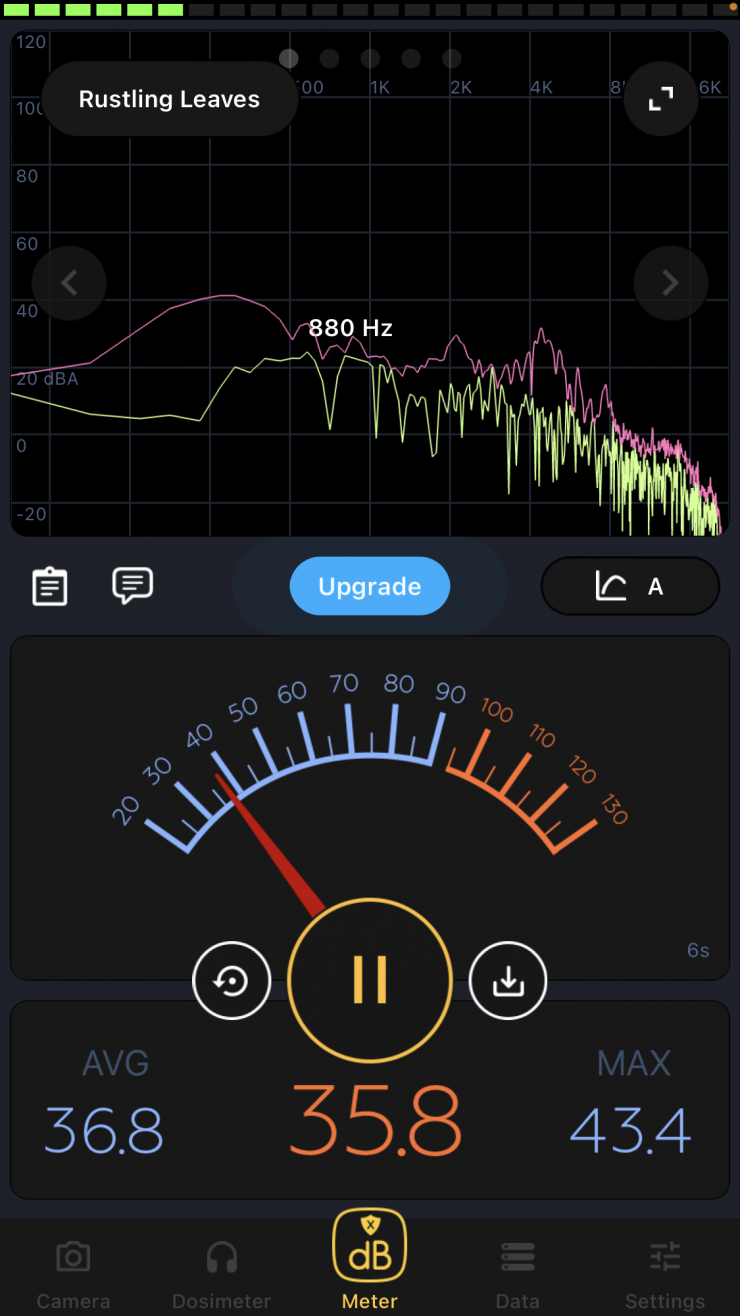
1m 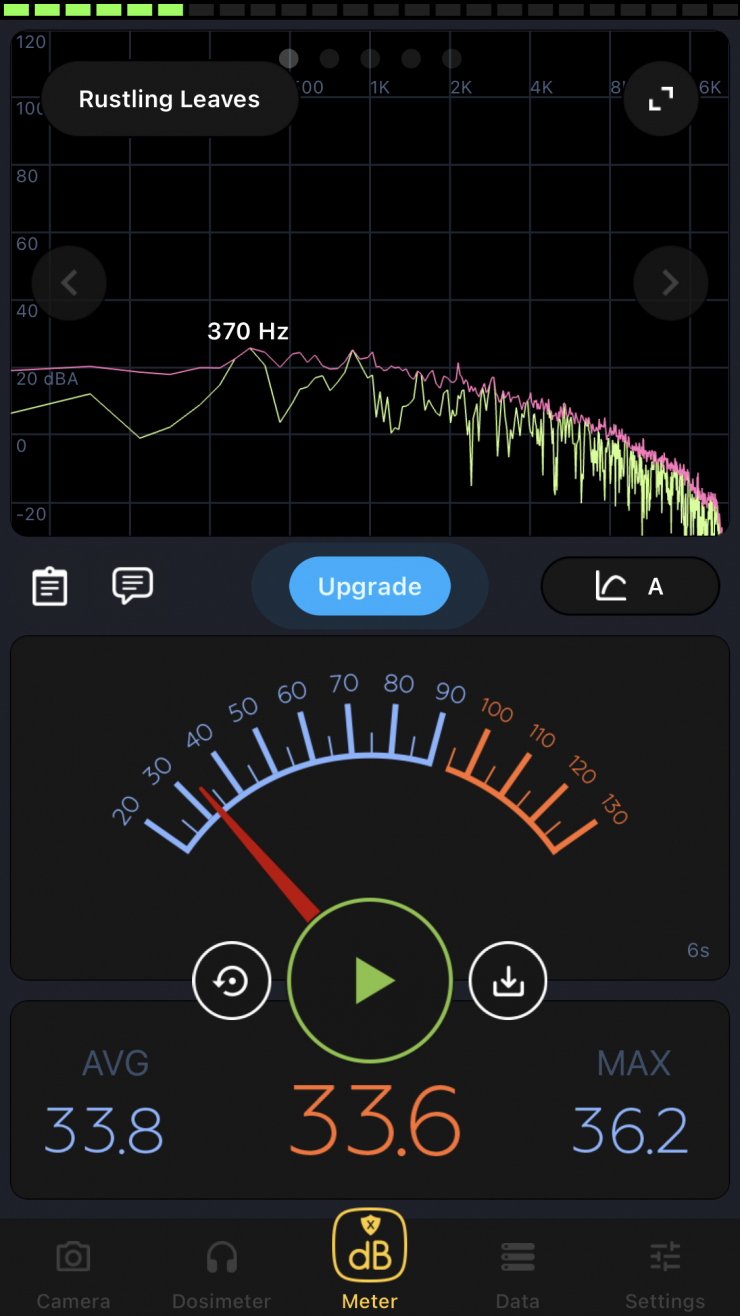
2m 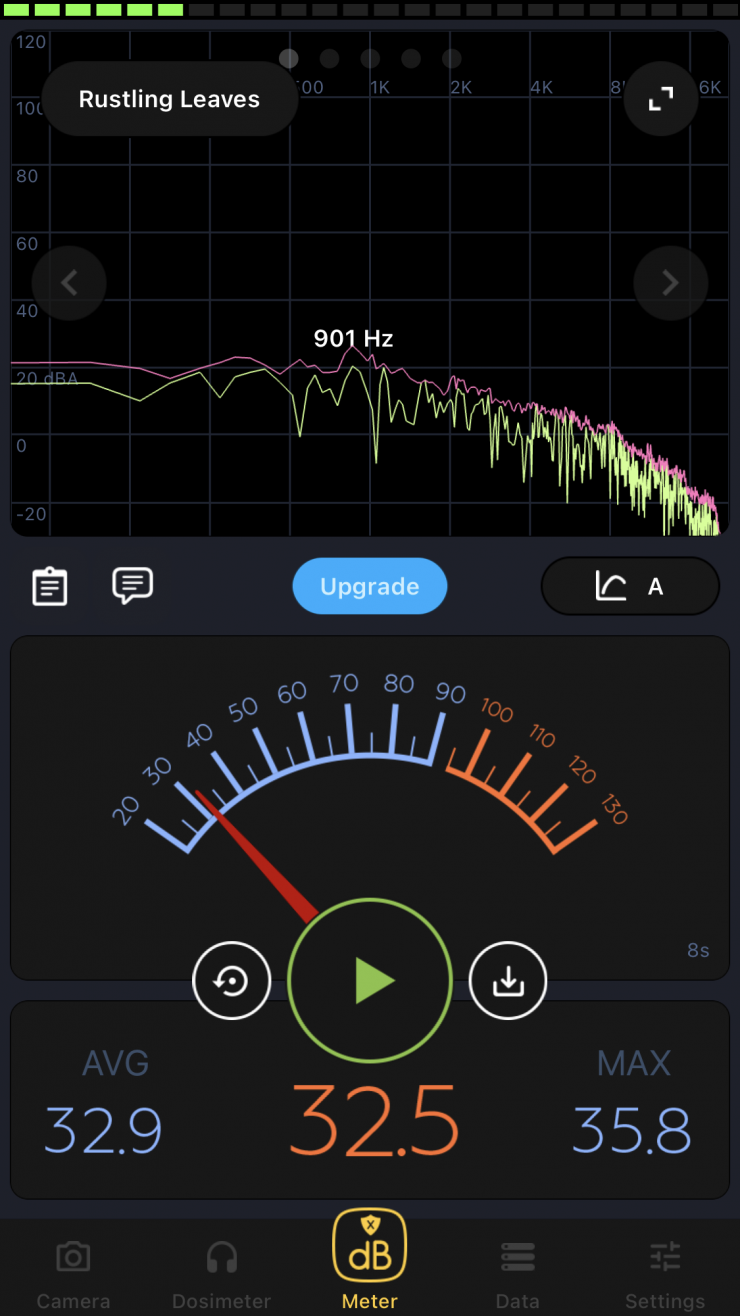
3m
Above you can see a measurement I took that shows how loud the fan was at a distance of 1m, 2m, and 3m. This fan noise doesn’t change no matter whether you have the output set at 0.1% or 100%.
In a normal-sized room, I personally found the fan noise to be too loud.
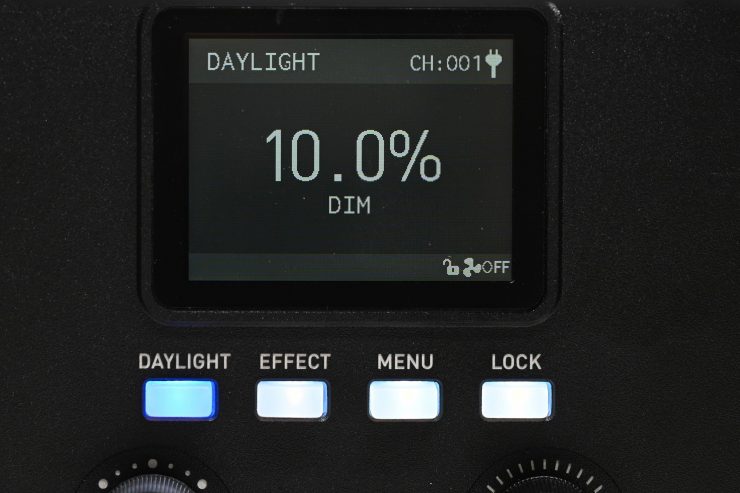
If you set the fan to Off it is completely silent, however, the caveat is that the output is limited to 10%!
Output
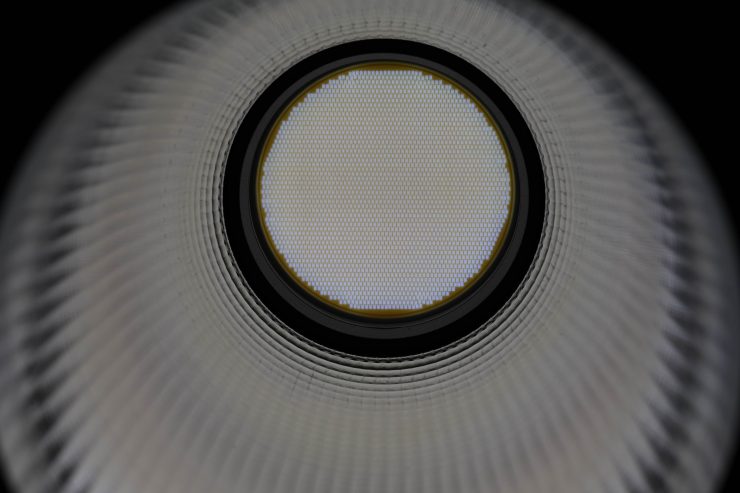
Nanlux claims that the Evoke 1200 has the following amount of output:
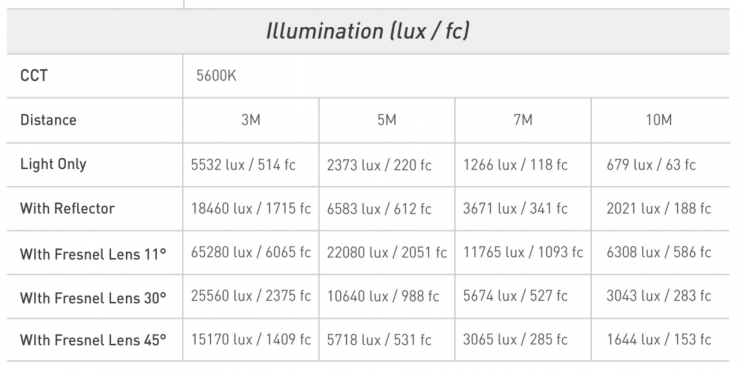
As you can see, the claimed output from the Evoke 1200 when using the optional F-35 Fresnel in the full spot position is pretty impressive.
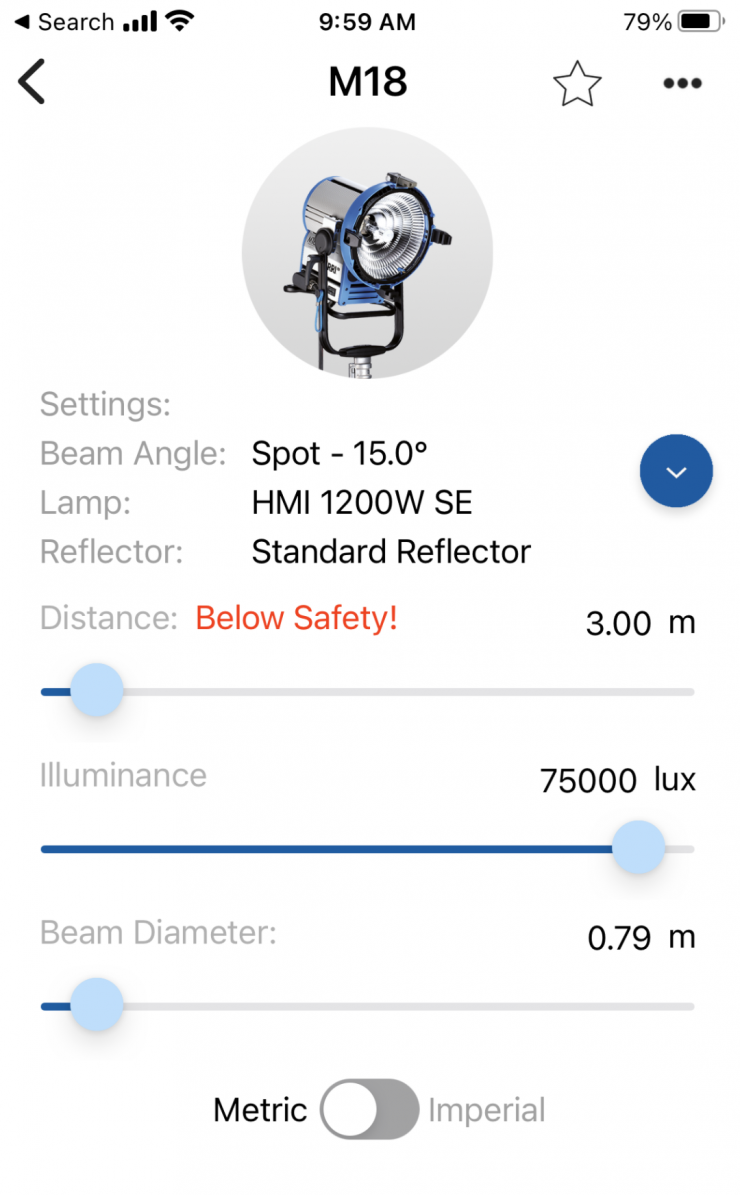
As a comparison, an ARRI M18 and HMI 1200W SE when used at 15 degrees puts out around 75,000 lx at 3m.
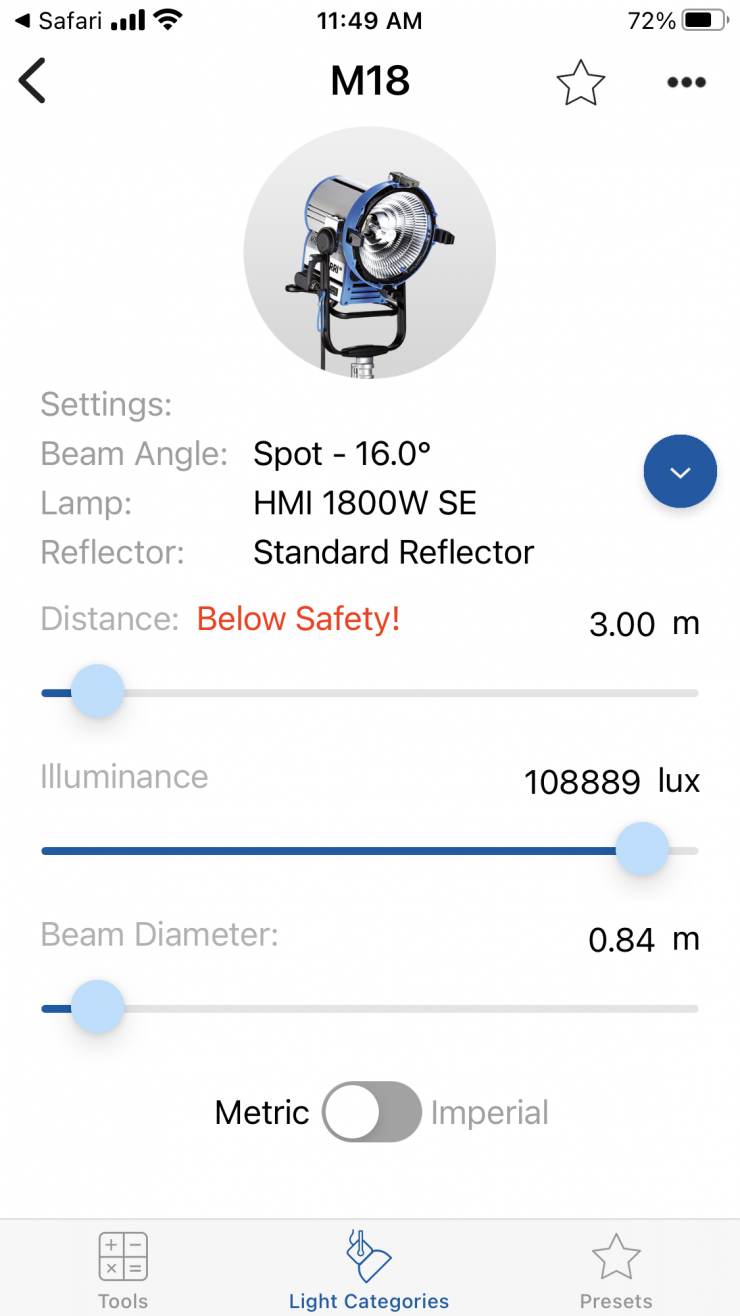
Ok, so what about if we use a 1800W lamp bulb in the ARRI M18? Well, as you can see, the output at 3m when used at 16 degrees is 108,889 lx.
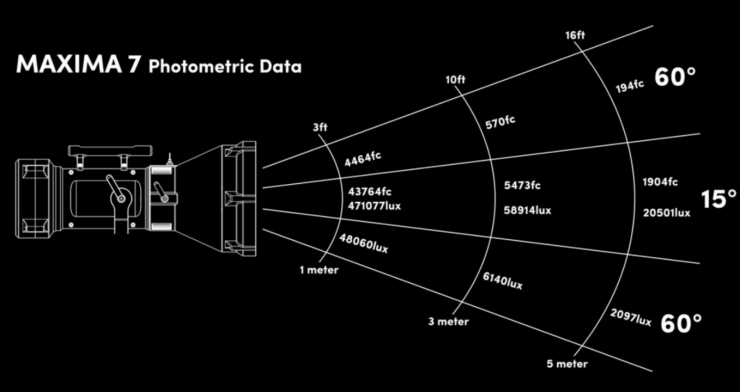
The Maxima 7 and Maxima 7 Fresnel Lens when set at 15° has a claimed output of 58,914 lx at 3m.
If you want to compare a more affordable light, the Aputure LS 600d Pro and F10 Fresnel when set at 15° put out 31,700 lx at a distance of 3 meters. At 11°, Nanlux claims that the Evoke 1200 and F-35 Fresnel is going to have almost twice the output of the Aputure, but with a slightly narrower beam angle.
I will do my own independent testing of the output later in the review.
Controls & Menu System
The Evoke has onboard controls and a 2.8″ display. It can also be controlled via Bluetooth, WiFi, DMX, RDM, and a wireless Lumen radio. An optional wired remote control will also be available at some stage.
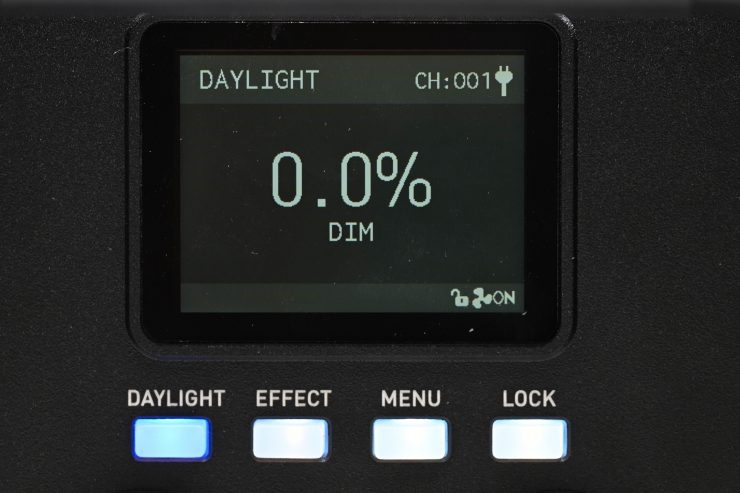
The Evoke is fully dimmable from 0-100% in intervals of 0.1%. I like that the light has this much finite control. Not many lights dim in increments of 0.1%. The screen is very basic, but it gets the job done. You can navigate to the various sections with the simple touch of a button.
The light features a selection of onboard creative effects, including INT loop, flash, pulse, storm, TV, paparazzi, candle/fire, bad bulb, firework, explosion, and welding. User settings and custom looks can be stored in the fixture
With a good light, you shouldn’t have to read a manual to work out how to operate it. You should be able to turn it on and use it straight away. You won’t find any deep sub-menus or complicated way of making changes on the Evoke 1200. It is very straightforward and easy to operate.
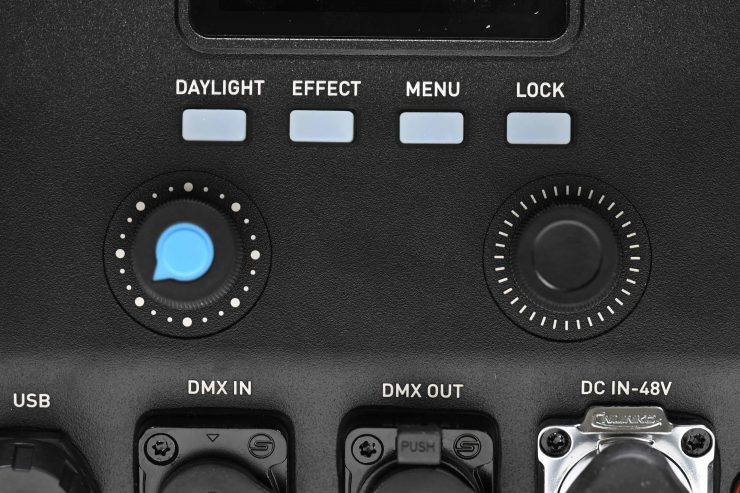
The physical dials and buttons you use to control the light don’t feel overly tactile, but they still work well and enable you to make finite adjustments easily and quickly. The dials don’t have any hard stops so you will find yourself endlessly turning them around. If you can’t see the display because the light is up high then this can be an issue because you just have to keep turning the intensity dial until the light doesn’t appear to get any brighter to know it has reached 100% output.
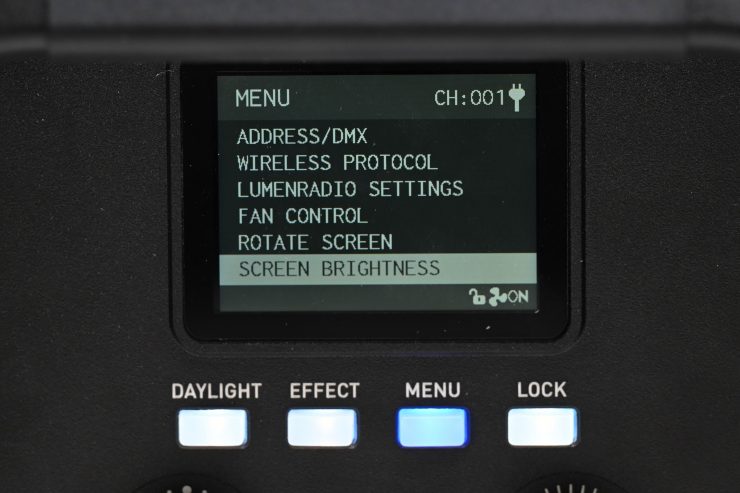
When you press the MENU button it brings up various parameters that can be adjusted. If you rotate the Right knob to select the setting item and press the Right knob you then enter the corresponding secondary menu. You can then rotate the Right knob again to select corresponding options and press, you guessed it, the Right knob to set. If you press the MENU key you will return to the previous menu.
The Menu is very basic and easy to navigate. To be honest there isn’t a ton of options to change and that is primarily because the Evoke 1200 is a daylight (5600K) only fixture.
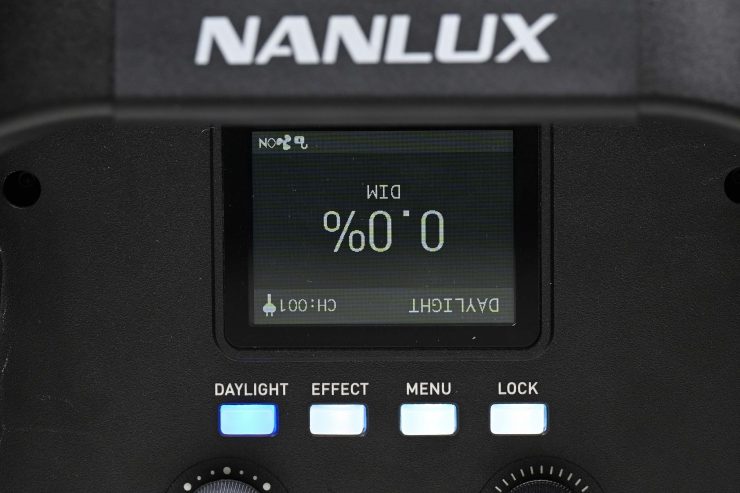
You can rotate the screen if need be which is always a handy feature to have. You can also dim the brightness of the screen if you want to.
Evoke 1200 supports remote control via DMX, 2.4G, RDM, and LUMENRADIO, and it has built-in Bluetooth.
The Evoke 1200’s built-in CRMX TIMO TWO module enables it to receive CRMX wireless DMX signals.
The Evoke 1200 can be remotely controlled by a 2.4Ghz remote controller or
by an APP via the transmitter box. Both the 2.4Ghz remote controller and transmitter box are sold separately.
App?
The light is supposed to have an App available so you can control it remotely. When I say supposed to, I mean it isn’t actually available yet.
One of my pet peeves with any type of equipment is when a company shows something in its marketing material that isn’t actually even available. It isn’t as if this light came out 2 days ago, it was launched way back in early May.
The other problem is you will need to buy an optional transmitter box to use the App once it eventually comes.
UPDATE:
The NANLITE LINK APP will be released in October/November and according to Nanlux, no additional transmitting device will be required, so you will be able to use Bluetooth to control the light directly.
Operating Modes
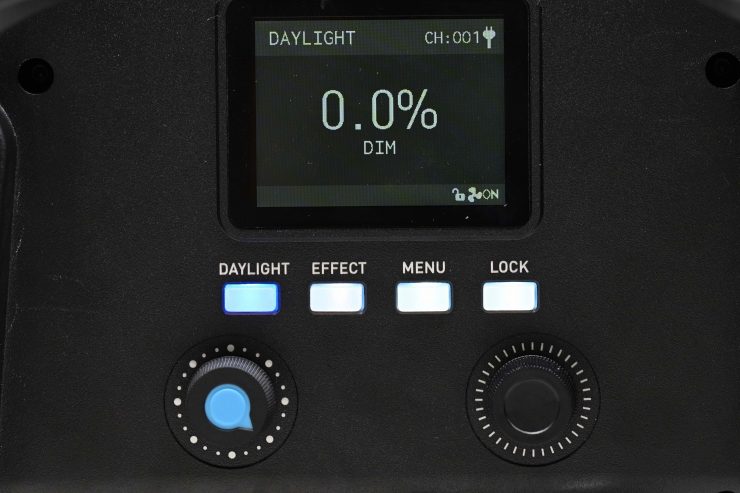
The light has two key lighting modes:
- DAYLIGHT
- EFFECT
DAYLIGHT
This is the mode most people are going to use the light in. In this mode, you can make intensity adjustments in 0.1% increments. The light doesn’t feature any +/- GM adjustment capabilities.
EFFECT
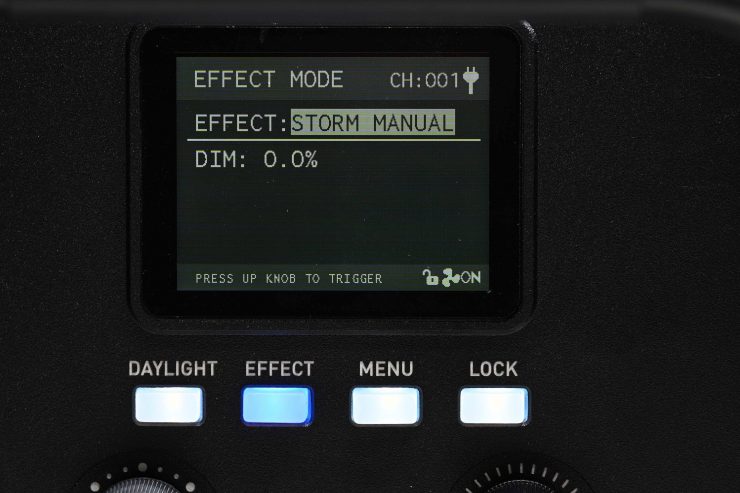
The Evoke 1200 has built-in effects that include:
- INT LOOP
- FLASH
- PULSE
- STORM AUTO
- STORM MANUAL
- TV
- PAPARAZZl
- CANDLE/FIRE
- BAD BULB
- FIREWORK
- EXPLOSION AUTO
- EXPLOSION MANUAL
- WELDING
You can adjust various aspects of these effects depending on which one you are using.
What does the Evoke 1200 offer that its competition doesn’t?
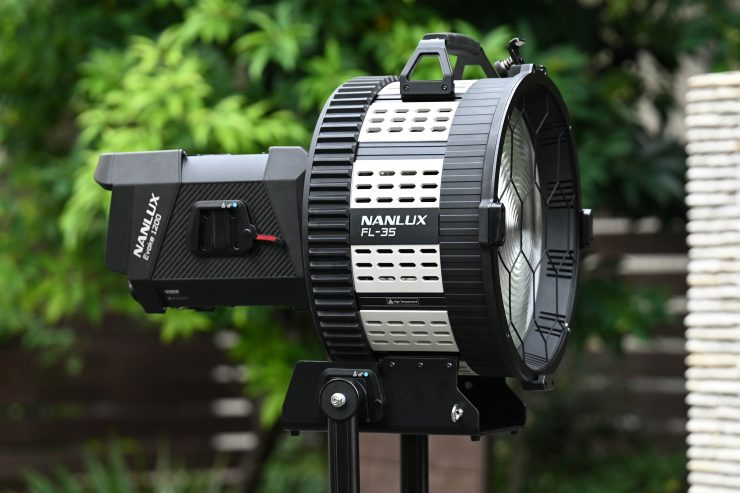
The Evoke 1200 is fairly rare as far as high-powered LED spotlights are concerned. To the best of my knowledge, the only other similar style LED light on the market that draws over 1000W is the Mole-Richardson 1600W Tener LED (Daylight). Most other high-power draw LED spotlights currently on the market top out around 750W. The Maxima 7 draws 750W (max), the Aputure LS 600d Pro draws 720W (max) and the HIVE LIGHTING Super Hornet 575-C PAR Spot Omni-Color LED Light draws 550W.
Nanlux presumably saw a gap in the market that needed to be filled and that is why they decided to make the Evoke 1200. There isn’t a similar LED light on the market that has the claimed output of the Evoke 1200 at anywhere near its price.
Let’s compare it directly against four lights, the ARRI M18, Mole-Richardson 1600W Tener LED (Daylight), Maxima 7, and Aputure LS 600d Pro. One is a traditional HMI and the other three are LED.
| Nanlux Evoke 1200 | ARRI M18 | |
| Mount | Proprietary Mount | no mount |
| Power Draw | 1200W | 1200W |
| Beam Angle | 120° Open Face 45° Reflector 11°-45° with F-35 Fresnel | 15° to 58° |
| App Control | not yet | no |
| Weight | 6.94kg (lamp head)* 10.5kg (power supply) | 10.5kg (lamp head) 8kg (power supply) |
| Price | $3,380 USD $935 USD (F-35 Fresnel) | $13,825 USD |
| Nanlux Evoke 1200 | Mole-Richardson 1600W Tener LED (Daylight) | |
| Mount | Proprietary Mount | no mount |
| Power Draw | 1200W | 1600W |
| Beam Angle | 120° Open Face 45° Reflector 11°-45° with F-35 Fresnel | 10° to 55° |
| App Control | not yet | no |
| Weight | 6.94kg (lamp head)* 10.5kg (power supply) | 31.80 kg** |
| Price | $3,380 USD $935 USD (F-35 Fresnel) | $13,120.63 USD |
| Nanlux Evoke 1200 | Maxima 7 | |
| Mount | Proprietary Mount | S-Type mount |
| Power Draw | 1200W | 750W |
| Beam Angle | 120° Open Face 45° Reflector 11°-45° with F-35 Fresnel | 120° Open Face 15° to 60° Fresnel |
| App Control | not yet | Yes |
| Weight | 6.94kg (lamp head)* 10.5kg (power supply) | 9.9kg** |
| Price | $3,380 USD $935 USD (F-35 Fresnel) | Metal 4.990,00€ Carbon-Kevlar 3.990,00€ |
| Nanlux Evoke 1200 | Aputure LS 600d Pro | |
| Mount | Proprietary Mount | Bowens Mount |
| Power Draw | 1200W | 720W |
| Beam Angle | 120° Open Face 45° Reflector 11°-45° with F-35 Fresnel | 120° Open Face 55° Reflector 15°-45° with F10 Fresnel |
| App Control | not yet | Yes |
| Weight | 6.94kg (lamp head)* 10.5kg (power supply) | 5.8kg (lamp head)* 4.64kg (power supply) |
| Price | $3,380 USD $935 USD (F-35 Fresnel) | $1,890 USD $358 USD (F10 Fresnel & Barndoors) |
* Doesn’t include the weight of the Fresnel
** Power supply is built-in
FL-35 Fresnel Attachment

The Nanlux F-35 10° Fresnel Attachment for Evoke 1200 LED Light is a $935 USD optional accessory. B&H lists it as a 10° Fresnel, but it is actually 11°.
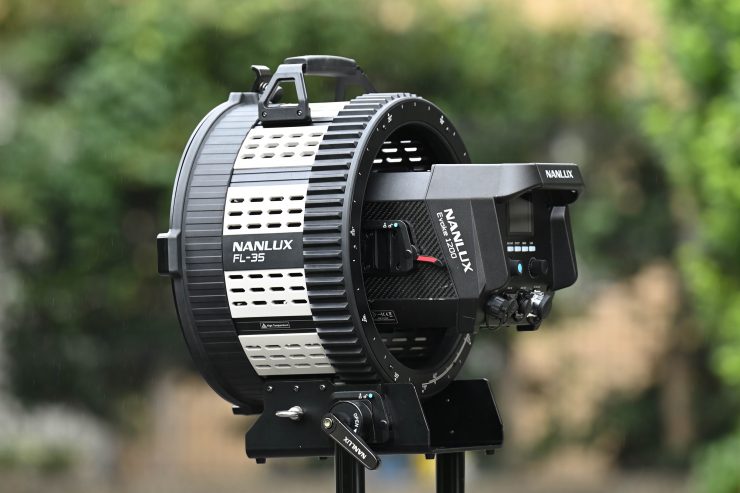
The F-35 Fresnel allows you to change the beam spread from 11° to 45°.
The Fresnel itself doesn’t move, instead, it is the light that moves closer or further away from the Fresnel lens.
The light gets pulled closer or pushed further away from the Fresnel via long moving bolt mechanism.
Above you can see how it works. It is quite easy to make the adjustments, but it does also take quite a bit of time to move it from full flood to full spot.
I like how Nanlux has put very clear degree marking all around the Fresnel.
A blue marker tells you exactly what degree the Fresnel is being set at.
The F-35 Fresnel utilizes a proper glass Fresnel lens, it isn’t made out of acrylic.
The F-35 certainly isn’t lightweight, nor small. It tips the scales at 9.05kg / 19.95 lb and it is 120cm / 47.24″ in circumference and 34.97cm / 13.77” long.
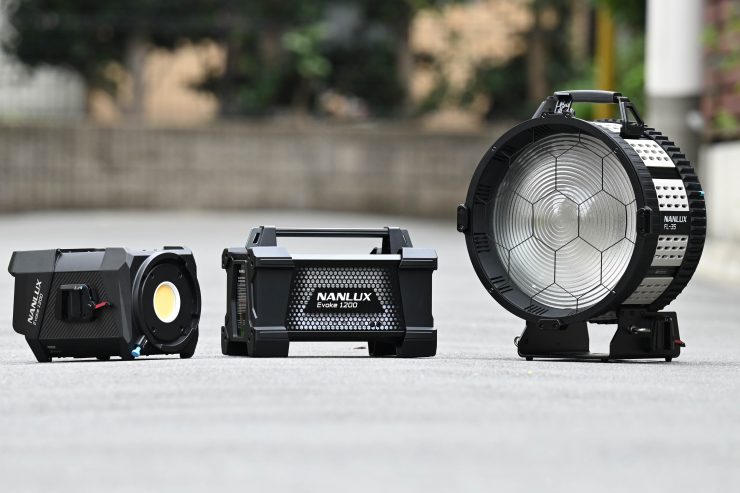
If you want a reference to just how large it is. You can see it next to the Evoke 1200 and the power supply above.
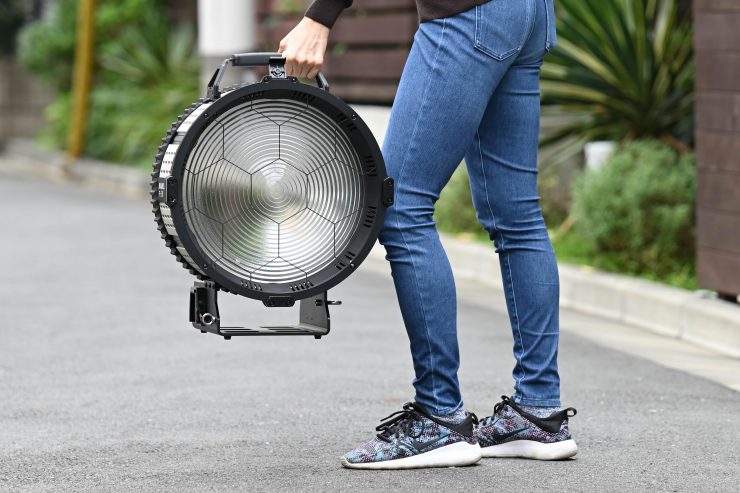
And above you can see someone holding it.
When using the F-35 Fresnel you have to first attach it directly to the yoke frame using the quick release system.
Above you can see how the F-35 Fresnel attaches to the yoke frame.
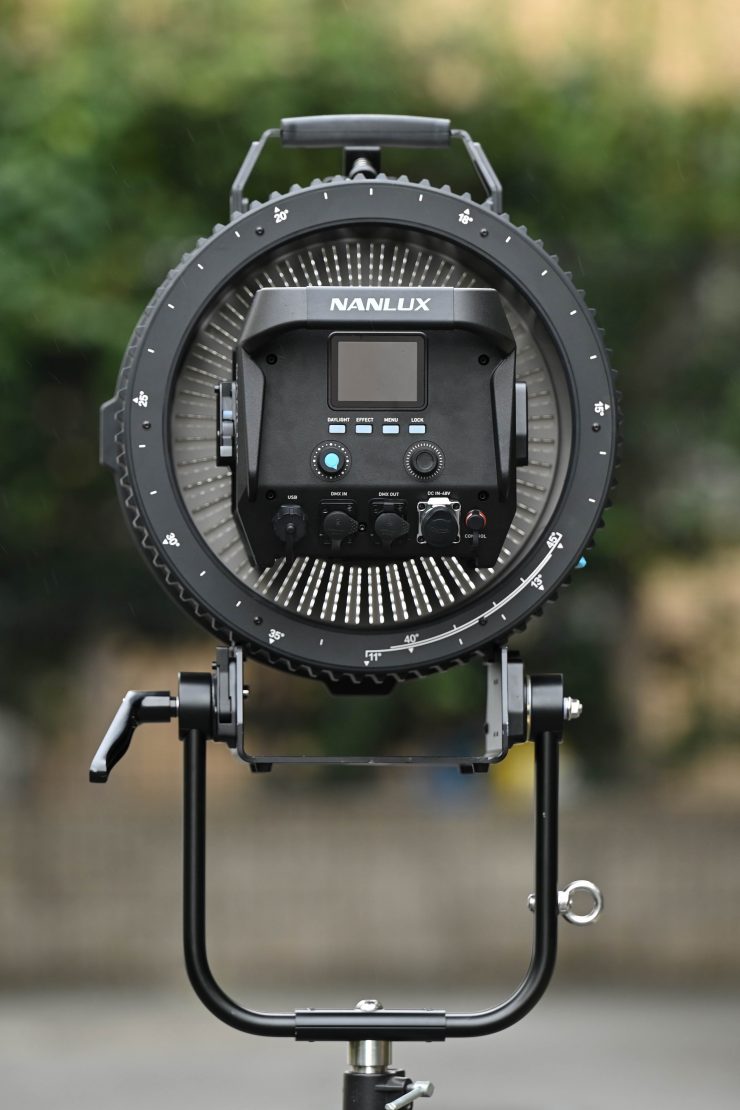
So how do you attach the Evoke 1200 to the F-35 Fresnel? Well, it just attaches directly to the proprietary mount, but instead of the Fresnel getting mounted to the light, the light gets mounted to the Fresnel.
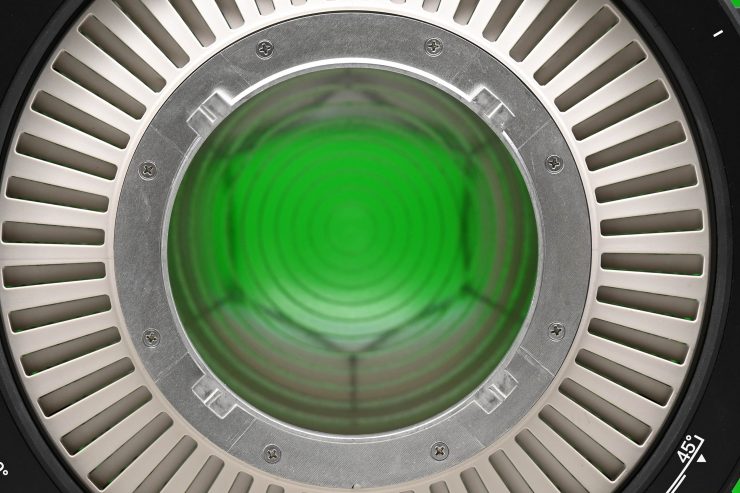
The actual Fresnel features the same mount that you will find on the reflector or any of the other lighting modifiers Nanlux sells for the Evoke 1200.
Above you can see how the Evoke 1200 gets attached to the F-35 Fresnel. It can be a little tricky to do this by yourself. You also need to have the Fresnel back in its full spot position to be able to attach the Evoke 1200.
I did find that the carrying handle was loose on the F-35 Fresnel. Again, not anything major, but just something that I took notice of. I think the reason that this is loose is that you are constantly holding onto it and pulling or pushing when you are placing it on or removing it from the yoke frame.
The overall build quality of the F-35 Fresnel is very good. It is certainly solidly made and well constructed. The adjustment mechanism is smooth and easy to operate, and as I previously mentioned, Nanlux has placed easy-to-read markings all the way around the Fresnel.
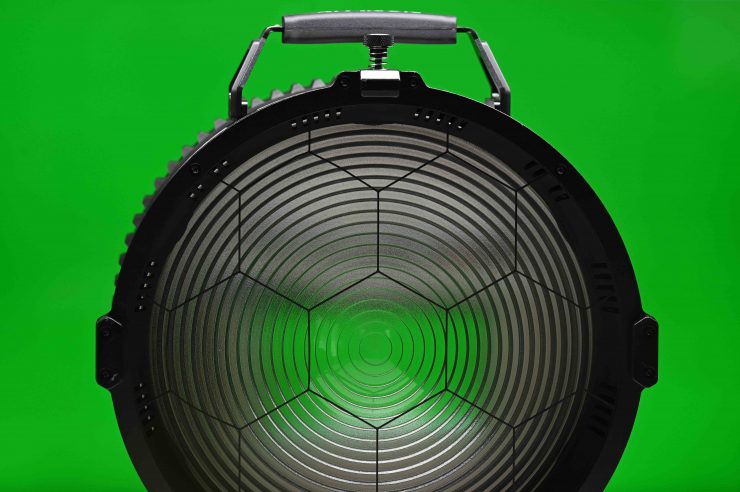
I also like how Nanlux has included a protective wire grid in front of the Fresnel.
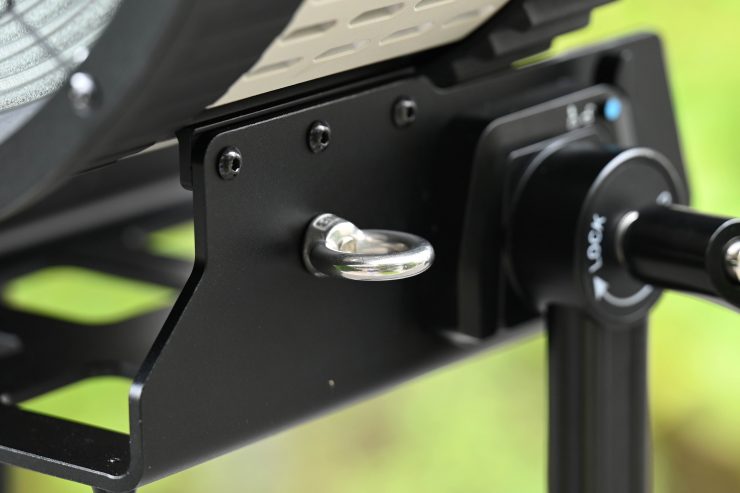
On the base of the Fresnel, there is a large eye-bolt on one side for securing it to overhead lighting grids or other mounting points.
On the opposite side of the base of the Fresnel, there is also a smaller-sized eye-bolt for attaching the barn doors.
Speaking on barn doors, the F-35 Fresnel comes with a set of four-way, 6-leaf barn doors. These barn doors are well made.
Above you can see how the barn doors fit onto the F-35 Fresnel.
Above you can see how the barn doors work on the F-35 Fresnel. I did find that one of the leaves on the barn doors was a little loose and it did occasionally fall down in certain positions.
So, does it cut well? With the barn doors, you can’t cut the light in a similar way to how you would if you were utilizing an HMI. This is something a lot of LED Fresnel’s struggle with. Above you can see some quick examples with the light set at 45°. With the beam angle of the Fresnel set to 45°, you are able to obtain a good cut.
Now, there are a couple of issues I came across while using the F-35 Fresnel and the barn doors. The first is the light spill. A ton of light spills out through the gap that is present between the barn doors and the Fresnel.
There is also another gap between the barn door frame and the actual barn doors that also spills out light. With a powerful fixture such as the Evoke 1200, this creates a lot of light spill, especially if you are using the light at high output intensities.
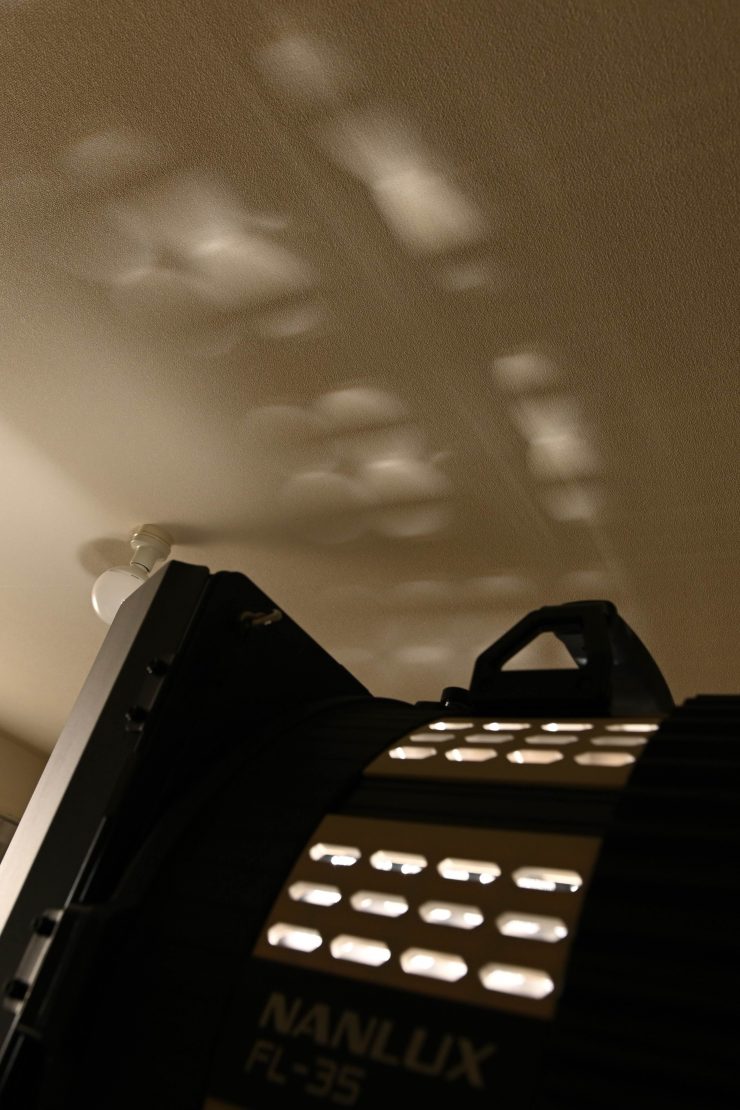
You can also get spill directly out of the top and back of the Fresnel because of the way it has been designed. This light spill may or may not be an issue depending on how and where you are using the light.
You can also get light spill because the barn doors don’t close up tightly against each other. In saying that, this is fairly common on most barn doors.
Is there any color fringing? I was impressed with the lack of color fringing I was seeing when using the F-35 Fresnel.
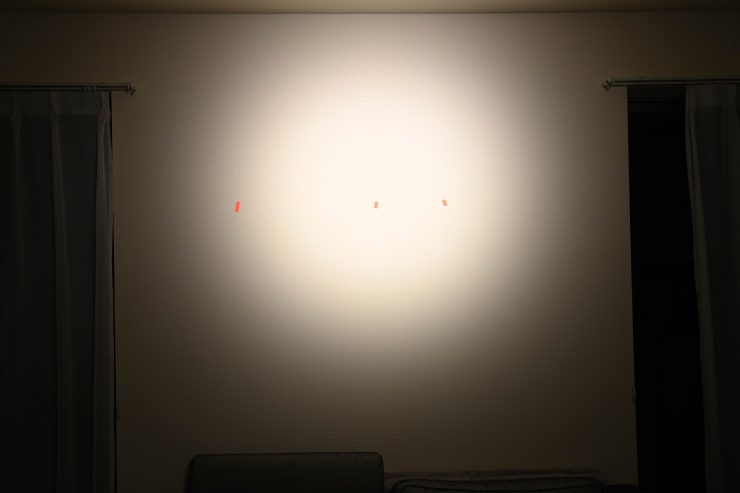
How is the fall off? I took a series of measurements at distances away from the center of the beam when using the F-35 Fresnel at 11° and 45° to see how linear the fall-off was and if there were any hotspots.
The F-35 Fresnel definitely creates a hot spot in the middle, especially at 11°.
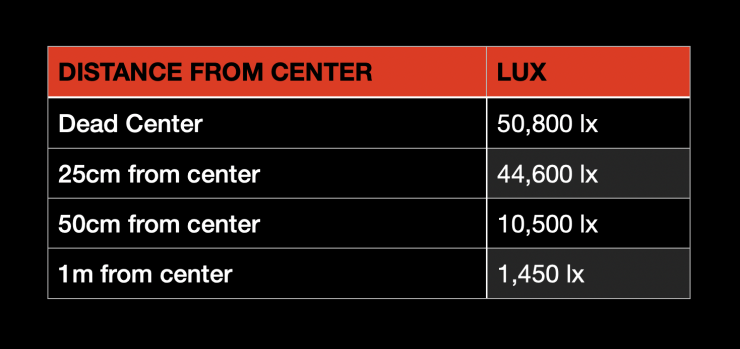
Above you can see lux readings taken at the corresponding distances from the center of the beam at a distance of 3m when the Fresnel was used at 11°. You can see that the hotspot in the middle is 12.2% brighter than if you take a reading 25cm to the left or right.
The intensity of the light then starts to drop away quite dramatically once you move out towards 50cm away from the center of the beam. At 50cm from the center of the beam, the output was 79.3% less.
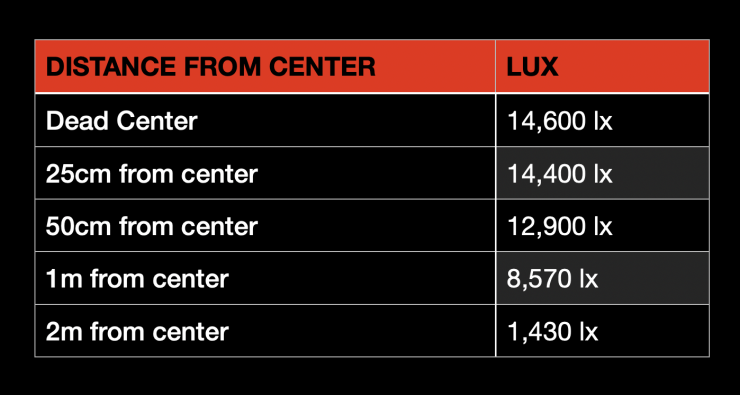
Above you can see lux readings taken at the corresponding distances from the center of the beam at a distance of 3m when the Fresnel was set at 45°.
At a distance of 3m when using the F-35 Fresnel at 45°, the center of the beam is only 1.3% higher than it is 25cm from the center. Once you start moving outwards from 50cm, the illumination levels start to drop off. However, at 1m from the center of the beam, the light only had 41.3% less output. The disadvantage the F-35 Fresnel has when compared to a lot of HMI fixtures is that they can usually go out to around 65°. That does allow you to create a much wider light source which is handy if you are in smaller spaces.
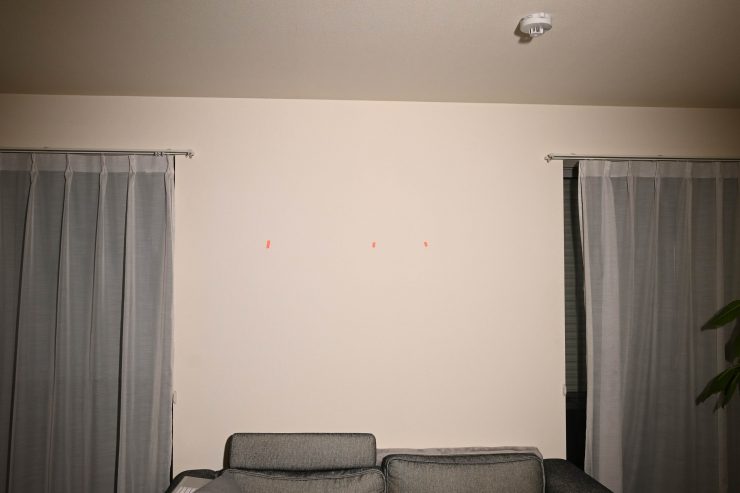
45° 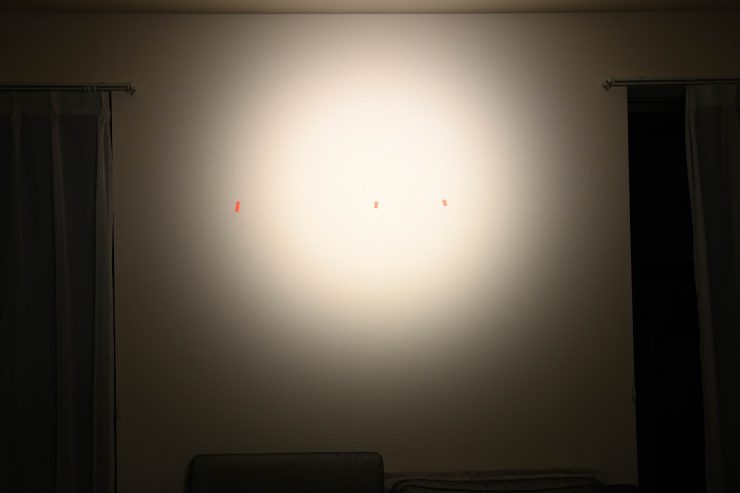
11°
Above you can the difference between when the F-35 Fresnel is set at 11° and 45°.
You need to remember that you can remove the Fresnel and use the Evoke 1200 open face to create a 120° beam angle. This allows you to light up quite large spaces with a single source.
Photometrics
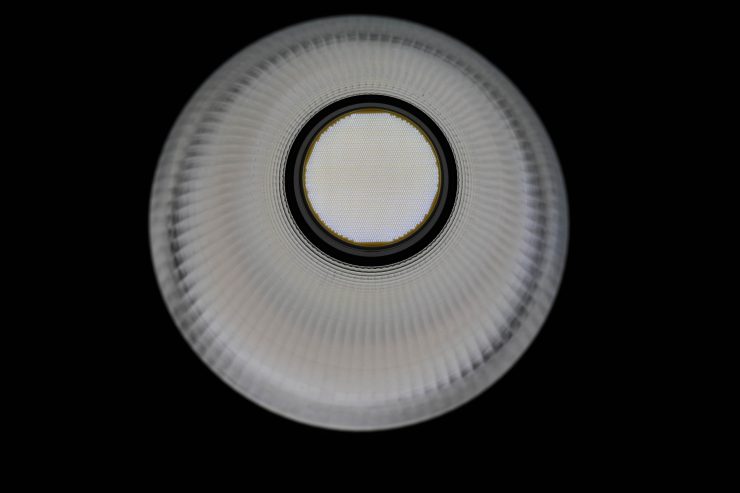
So now let’s get to the photometric results. I always test lights in this way so that I get a reference to how they compare to other fixtures. Results only tell part of the story and should never be used alone to judge a light. I have found from extensive testing over the years that certain lights that have good photometric results don’t always look good, and lights that have worse photometric scores can sometimes look better than their results indicate.
You can’t judge a light from one set of photometric results. You have to look at all of the different results to be able to come to a conclusion.
Different lights can also look different depending on what camera you happen to be using.
Output & Color Temperature Accuracy
I tested the Evoke 1200 with a Sekonic C-800 Spectrometer to find out how much output the light had and how accurate the Kelvin color temperature reproduction was. Most readings are taken at a distance of 1m /3.28ft)(unless otherwise noted) in a controlled environment. The readings were also taken directly from the lighting source. In the case of using the light with the Reflector and Fresnel, they were taken from the edge of those attachments.
5600K (open face 120° beam angle)
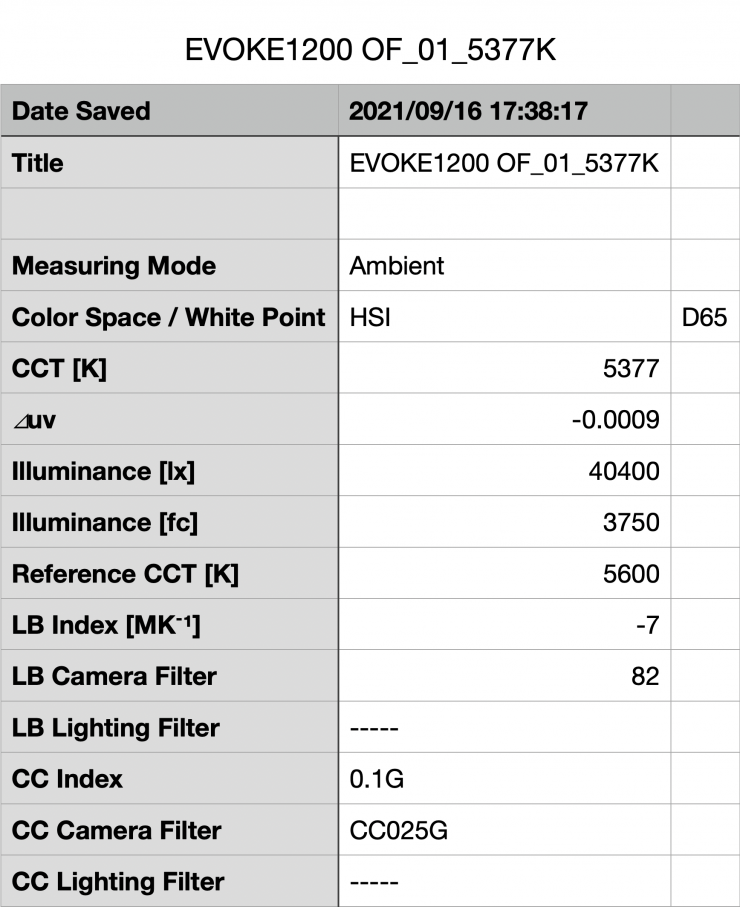
Above you can see the Evoke 1200 recorded an output of 40,400 lx (3750 fc) when used open face. This is a lot of output for a light with a 120° beam angle.
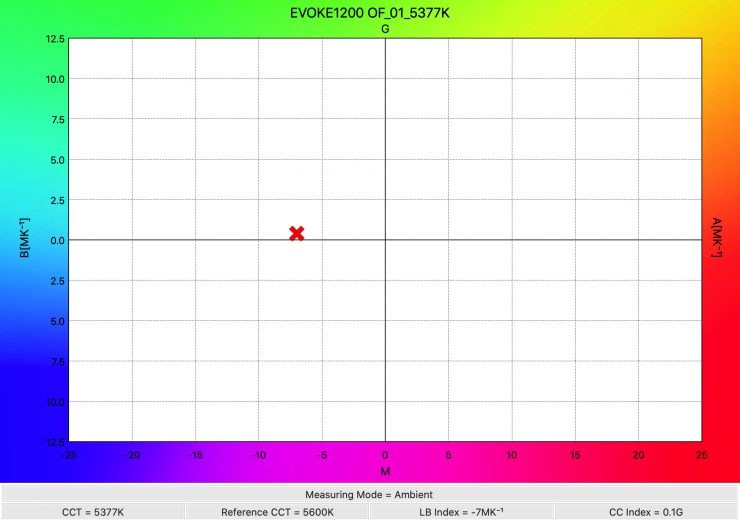
The light recorded a Kelvin color temperature reading of 5377K which was not overly accurate, but in saying that, it is still an acceptable result.
I reached out to Nanlux, about this Kelvin color temperature score and they told me the following: “Regarding the color temperature, the one used in your review was the first batch of trial production sample. The color temperature of the individual COB is very accurate, very close to 5600K, but if using it with a reflector and lens, the overall color temperature will drop by about 200K.”
5600K (Reflector 45° beam angle @1m)
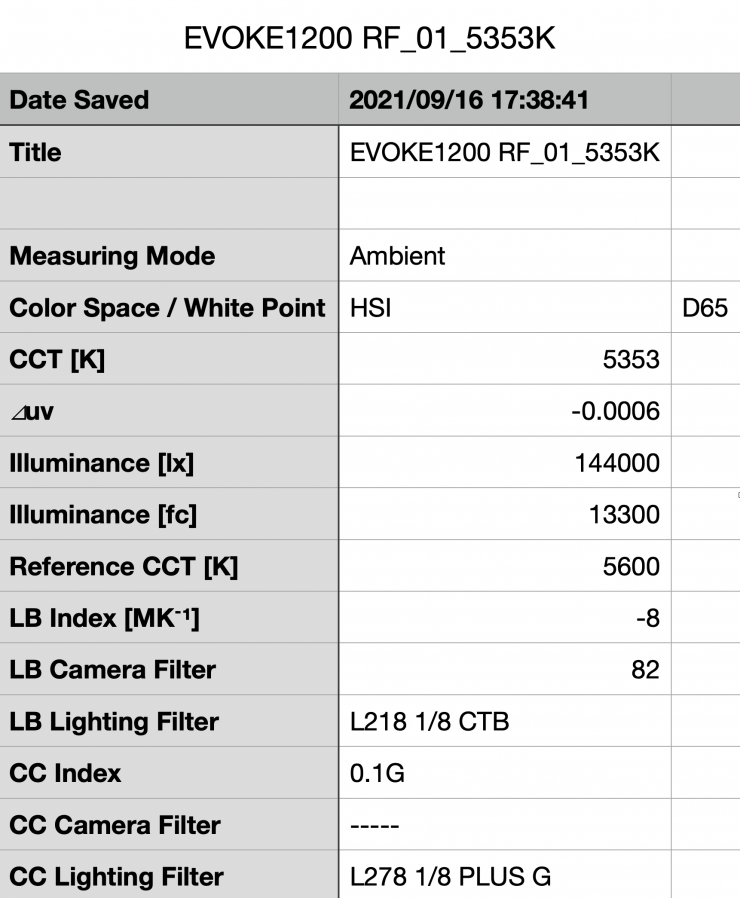
Above you can see the Evoke 1200 recorded an output of 144,000 lx (13,300 fc) when used with its 45° Reflector at a distance of 1m / 3.28′. Again, this is a considerable amount of output. The 144,000 lx when using the reflector was an increase in output of 71.9% when compared to using it open face.
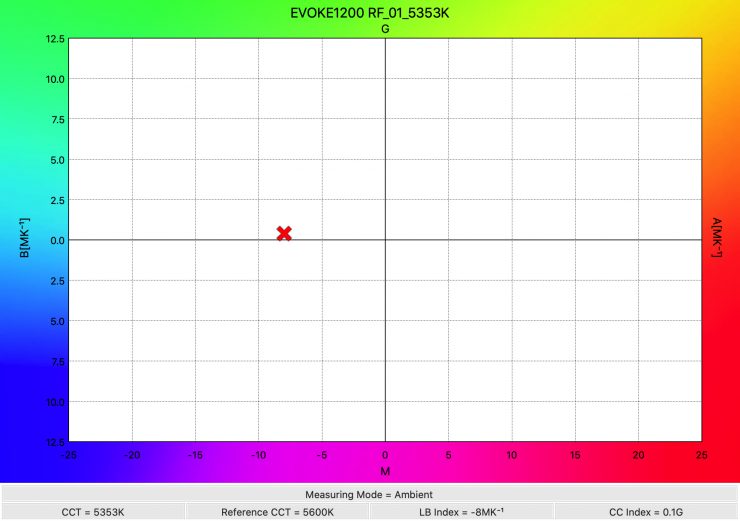
The light recorded a Kelvin color temperature reading of 5353K which tells me that the Reflector is not altering the Kelvin color temperature. This reading was only 24K different from when using the light Open face.
5600K (F-35 fresnel 11° @3m)
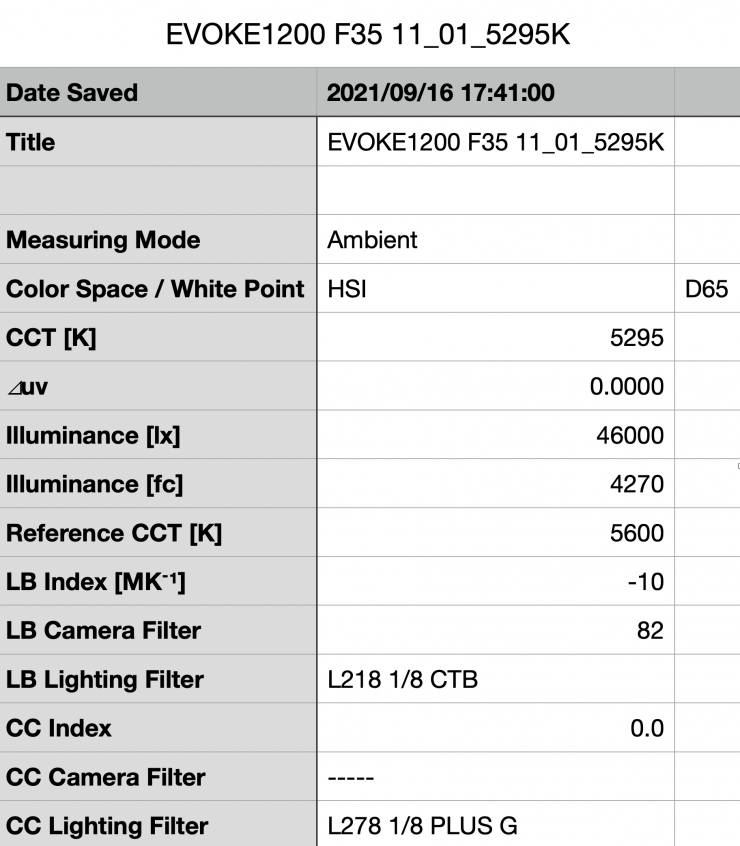
Above you can see that the lights output when it was used with the optional F-35 Fresnel at 11° at a distance of 3m / 9.84′ was 46,000 lx (4270 fc). What you need to clearly know is that the F-35 Fresnel at 11° does have a hotspot of around 10cm in the middle. I purposely didn’t measure it dead center for this very reason. A hot spot measurement is misleading.
This light is seriously bright when used with the F-35 Fresnel, although this figure of 46,000 lx was well below Nanlux’s claim of 65,280 lx. This is where marketing material can be very misleading. The figure I recorded was a whopping 29.5% less than the claimed output.
From my testing, the light doesn’t have anywhere near 65,280 lx at a distance of 3m when used with the F-35 fresnel at 11°. When I measured the light’s output dead center at 3m the most I got out of it was 50,800 lx.
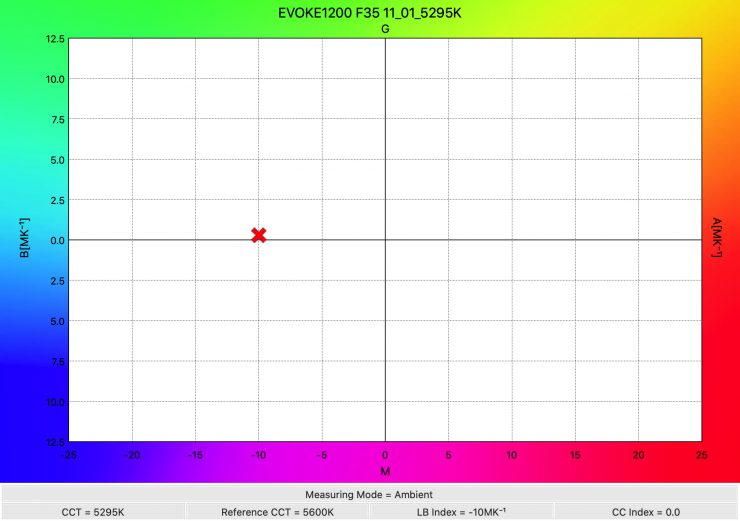
As far as Kelvin color temperature accuracy goes, it recorded a reading of 5295K. This tells me that the F-35 Fresnel is only slightly altering the Kelvin color temperature, but only by around 40K. This is nothing to be concerned about.
5600K (F-35 Fresnel 45° @3m)
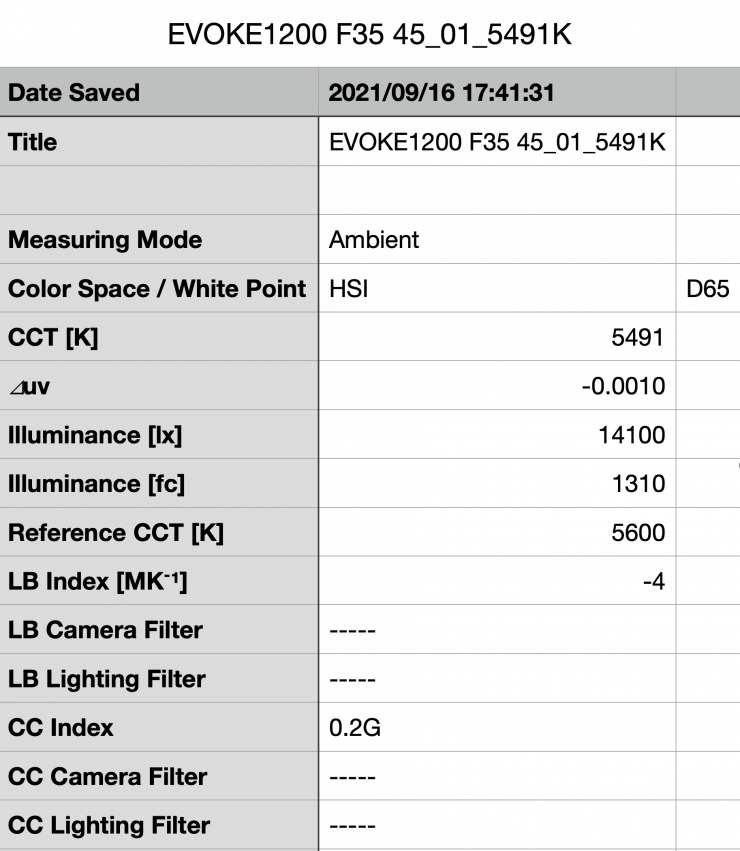
Above you can see that the lights output when it was used with the optional F-35 Fresnel at 45° at a distance of 3m was 14,100 lx (1310 fc). This was 99.99% less than the 46,000 lx it produced at 11°.
Nanlux claims that in this configuration that the light should have an output of 15,170 lx. My testing showed that it produced only 7% less than the claimed output.
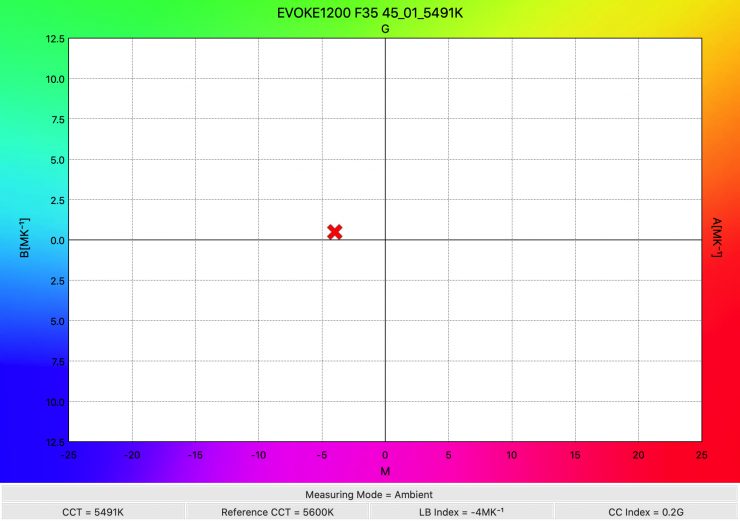
As far as Kelvin color temperature accuracy goes, it recorded a reading of 5491K. This was almost 200K higher than what was recorded when using the light and Fresnel at 11°.
5600K (F-35 fresnel 11° @5m)
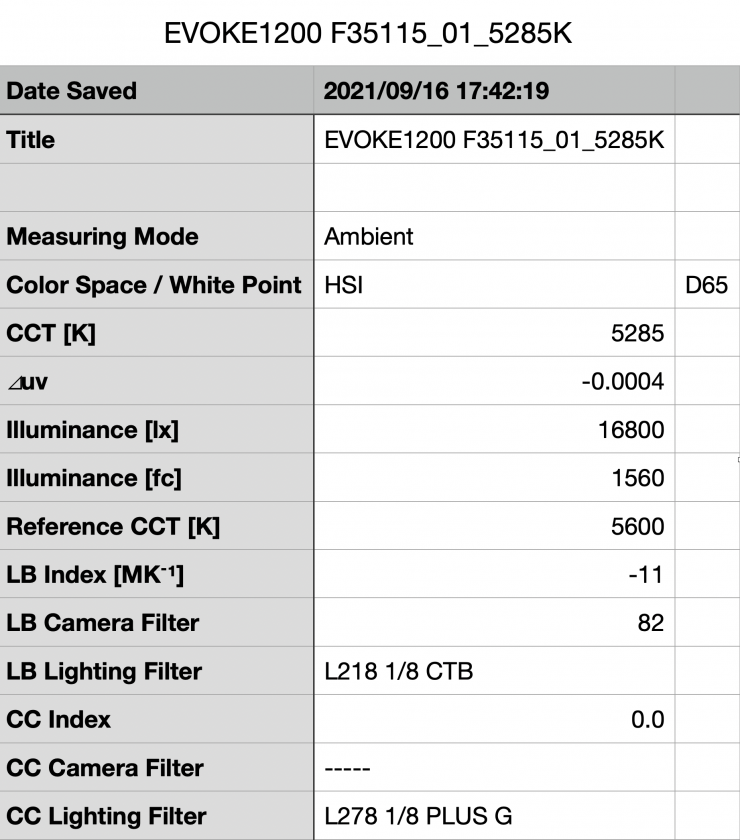
Above you can see that the lights output when it was used with the optional F-35 Fresnel at 11° at a distance of 5m / 16.4′ was 16,800 lx (1560 fc). This light is still very bright even at distances of 5m.
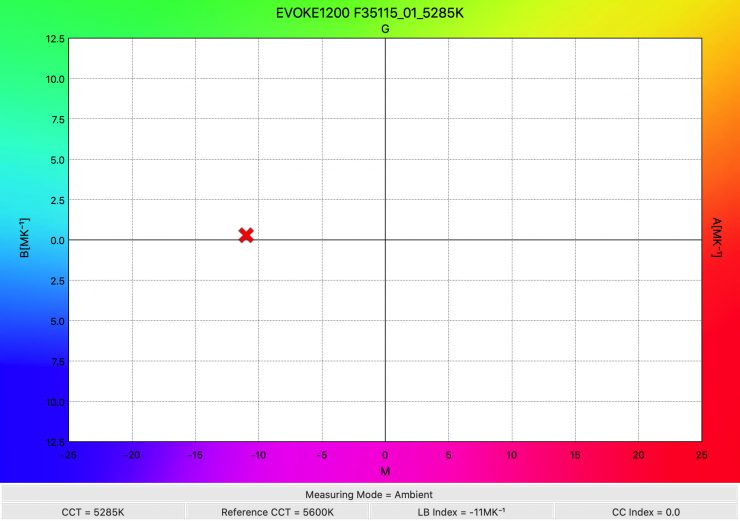
As far as Kelvin color temperature accuracy goes, it recorded a reading of 5285K.
| Output at 5600K (15°) @3m | |
| Nanlux Evoke 1200 & F-35 Fresnel | 46,400 lx (dead center 50,800 lx) |
| ARRI M18 | 75,000 lx |
| Maxima7 | 58,914 lx |
| Aputure LS 600d Pro & F10 Fresnel | 31,700 lx |
So what about if we compare the output of the Evoke 1200 with the F-35 Fresnel against say an ARRI M18 and the smaller sized Aputure LS 600d Pro with its optional F10 Fresnel at using the exact same beam angle? Above you can see that the Evoke 1200 basically sits between the ARRI M18 and the Aputure LS 600d Pro when it comes to output. The Maxima7 has a higher claimed output, but I haven’t tested that light so I cannot confirm those figures.
What you need to clearly remember is that the size of the source coming from the Evoke 1200 and ARI M18 is way bigger than that of the Aputure or Maxima7. The size of a 15° beam spread from the Aputure LDS 600d Pro and F10 Fresnel and Maxima7 is smaller, compared to the other two lights. Unless you are comparing LED lights that have the exact same power draw and exact same sized Fresnel there will always be variables that you need to take into account.
Kelvin color consistency when dimming the light
Now, what you should always do when testing lights is to see if the Kelvin color temperature remains consistent when dimming the light. Just because a light is 5600K, that doesn’t mean that the Kelvin color temperature will remain stable as you start dimming the fixture down.
I decided to do a series of tests at 100%/75%/50%/25%, and 10% to see if the Kelvin color temperature being recorded changed. This was done at a distance of 1m using a Sekonic C-800 with the Evoke’s Reflector.
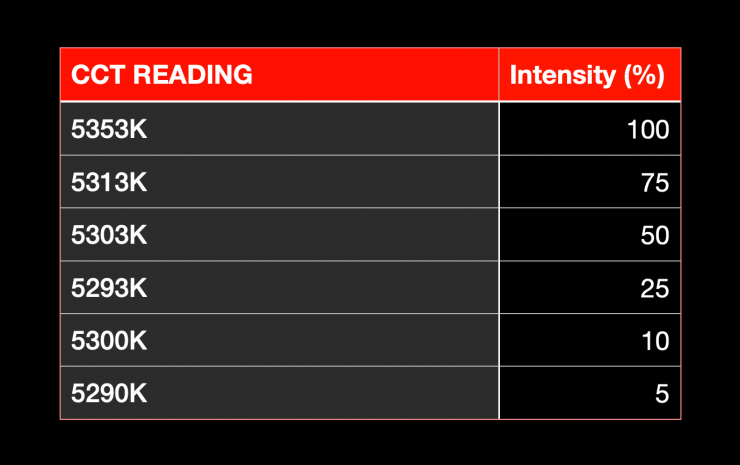
The Evoke 1200 maintains very good Kelvin color consistency once you start dimming the fixture. My testing showed that the Kelvin color temperature only drops by 63K by the time you hit 5% output.
These were excellent results.
How linear is the output?
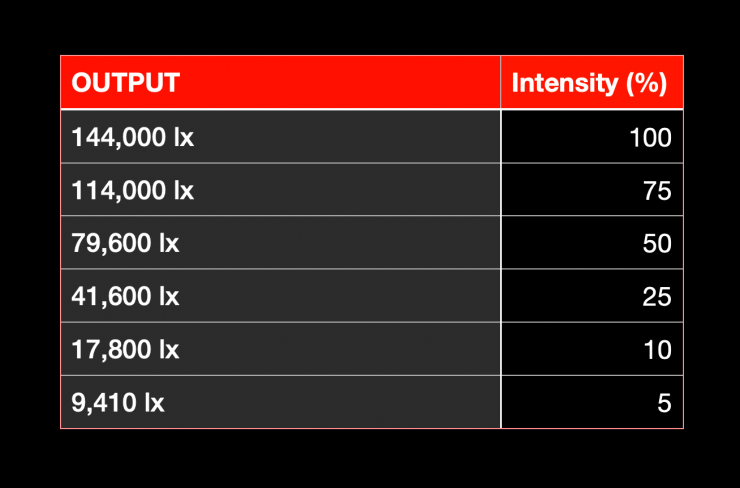
It is always a good idea to see how linear the output of a light is by comparing results recorded at various output levels. I decided to do a series of tests at 100%/75%/50%/25%, and 10% to see if the output remained linear as you start dimming the light down. These tests were done at a distance of 1m using a Sekonic C-800 with the Evoke’s Reflector.
At 50% output, the light had 44.7% less output than when used at 100%. At 25% output, the light had 71.1% less output than when used at 100%. At 10% output, the light had 87.6% less output than when used at 100%.
These results tell me that the light’s output remains pretty linear once you start dimming it down.
Color Rendering
5600K (Open Face)
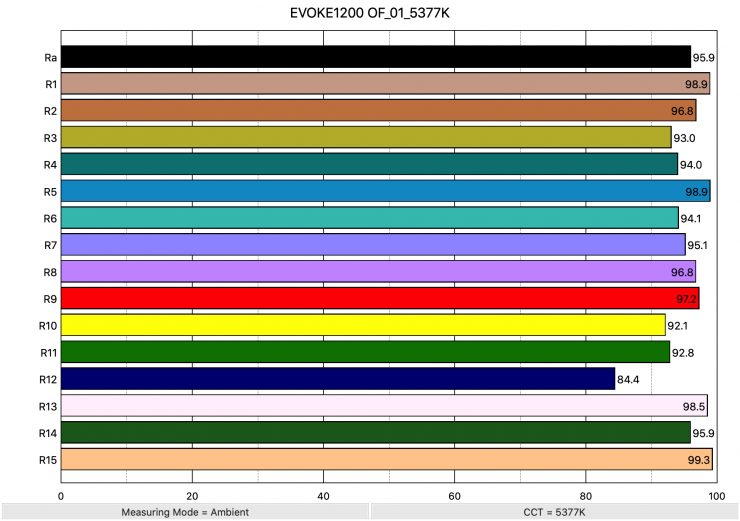
So now that we have seen how much output the Evoke 1200 produces, how does it perform when it comes to replicating accurate colors. Above you can see that when the light was used open face it recorded an average CRI (R1-R8) of 95.9 and an extended CRI (R1-R15) of 95.18. For replicating accurate skin tones it recorded for R9 97.2 (red), 98.5 for R13 (closest to caucasian skin tones), and 99.3 for R15 (closest to Asian skin tones). These are excellent results, and only R12 was below 90.
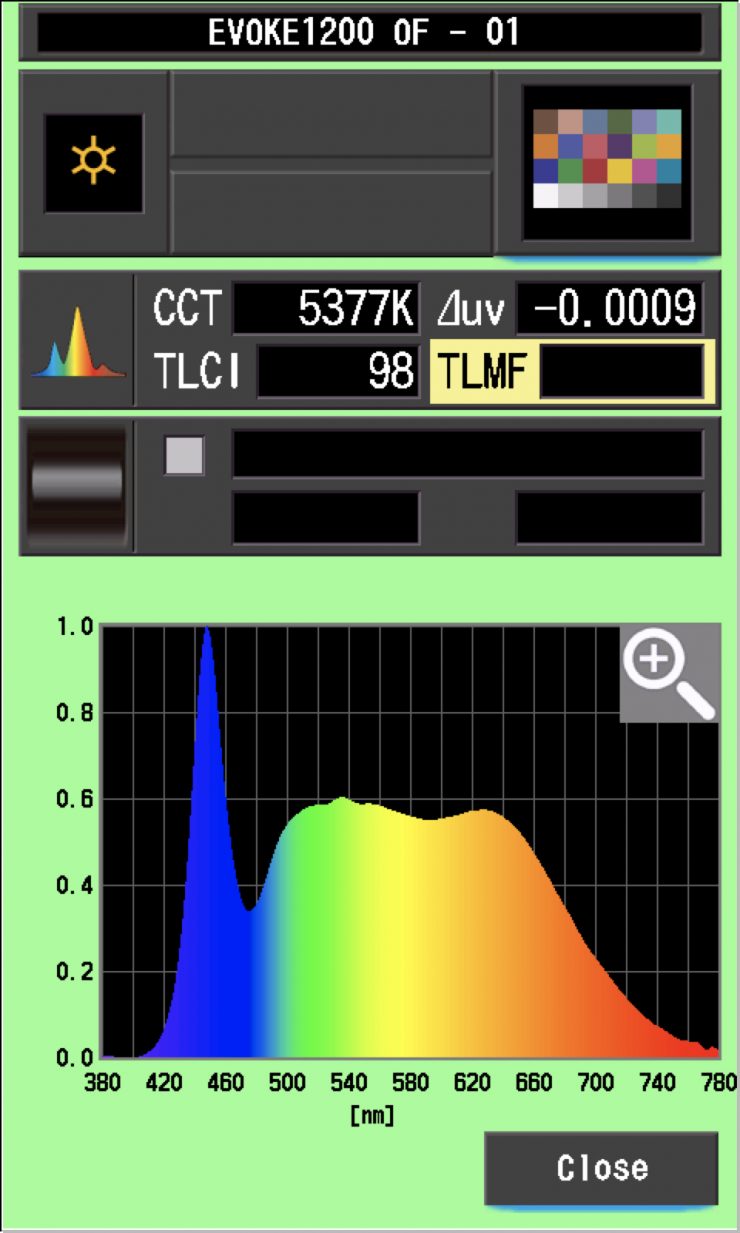
The light when used open face recorded a TLCI score of 98.
5600K (standard reflector)
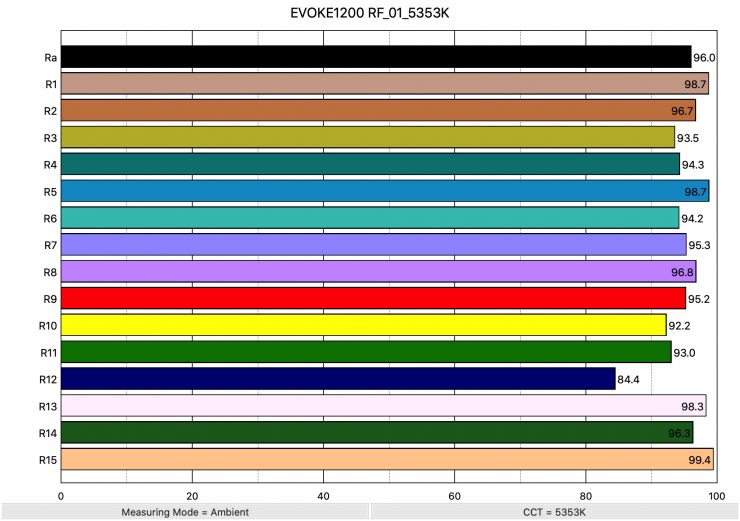
Above you can see that when the light was USD with its standard reflector it recorded an average CRI (R1-R8) of 96.0 and an extended CRI (R1-R15) of 95.13. For replicating accurate skin tones it recorded for R9 95.2 (red), 98.3 for R13 (closest to caucasian skin tones), and 99.4 for R15 (closest to Asian skin tones). These are excellent results and only R12 (Blue) was below 90.
As a comparison, the Aputure LS 600d Pro when used with its Hpyer Refelector recorded an average CRI (R1-R8) of 96.5 and an extended CRI (R1-R15) of 94.68. For replicating accurate skin tones it recorded for R9 93.9 (red), 98.9 for R13 (closest to caucasian skin tones), and 96.2 for R15 (closest to Asian skin tones).
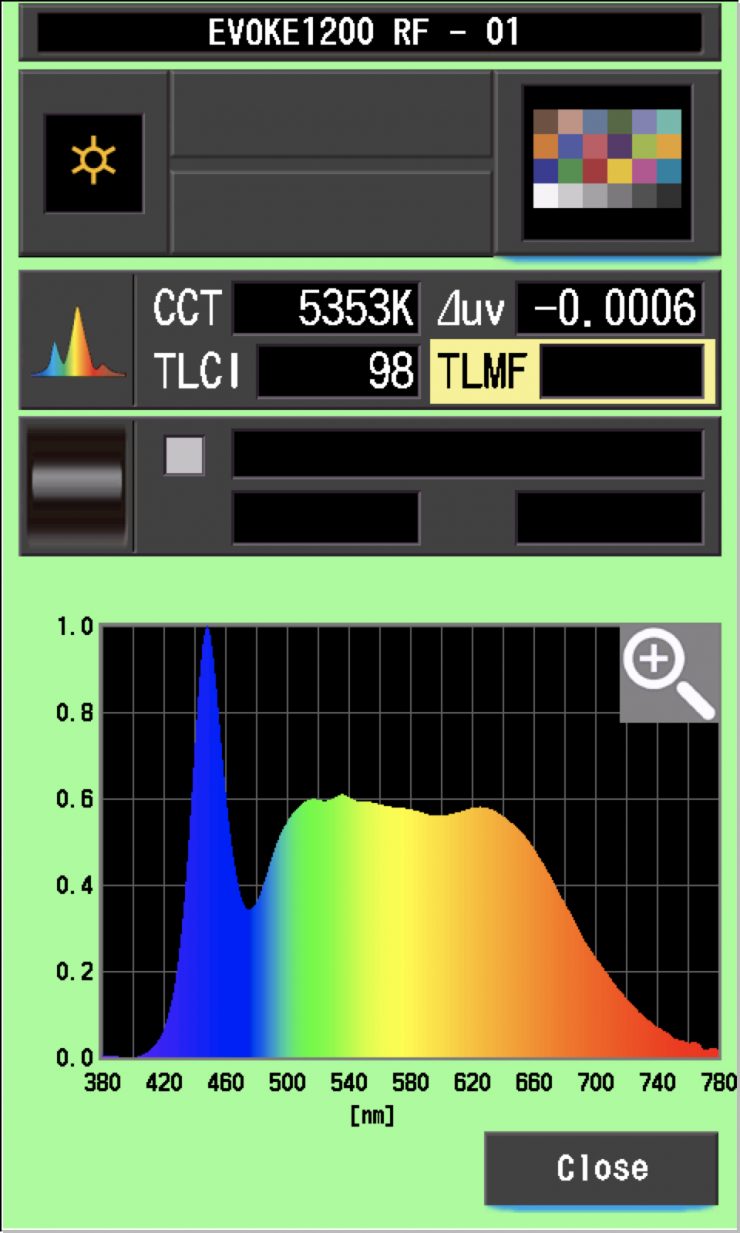
The light when used with its reflector recorded a TLCI score of 98.
5600K (F-35 Fresnel 11°)
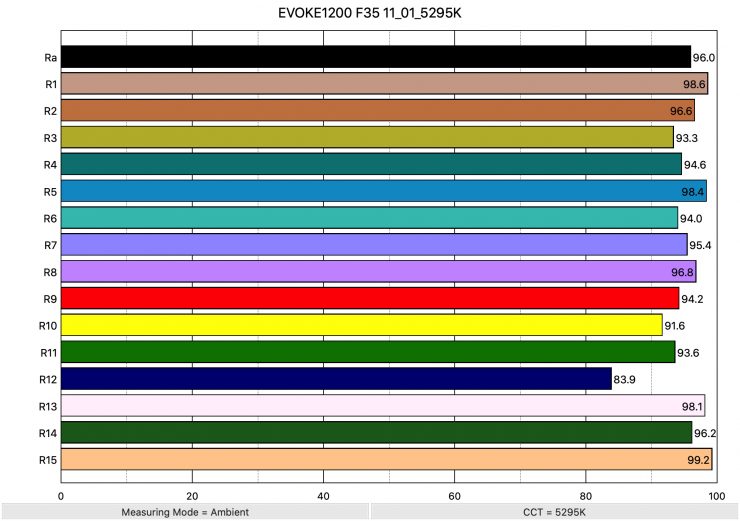
Above you can see the scores for when the light was used with the F-35 Fresnel and set to 11°. It recorded an average CRI (R1-R8) of 96.0 and an extended CRI (R1-R15) of 94.96. For replicating accurate skin tones it recorded 94.2 for R9 (red), 98.1 for R13 (closest to caucasian skin tones), and 99.2 for R15 (closest to Asian skin tones).
These results were almost identical to when the light is used open face or with its reflector.
As a comparison, the Aputure LS 600d Pro when used with its optional F10 Fresnel recorded an average CRI (R1-R8) of 97.1 and an extended CRI (R1-R15) of 95.32. For replicating accurate skin tones it recorded 94 for R9 (red), 98.5 for R13 (closest to caucasian skin tones), and 95.7 for R15 (closest to Asian skin tones).
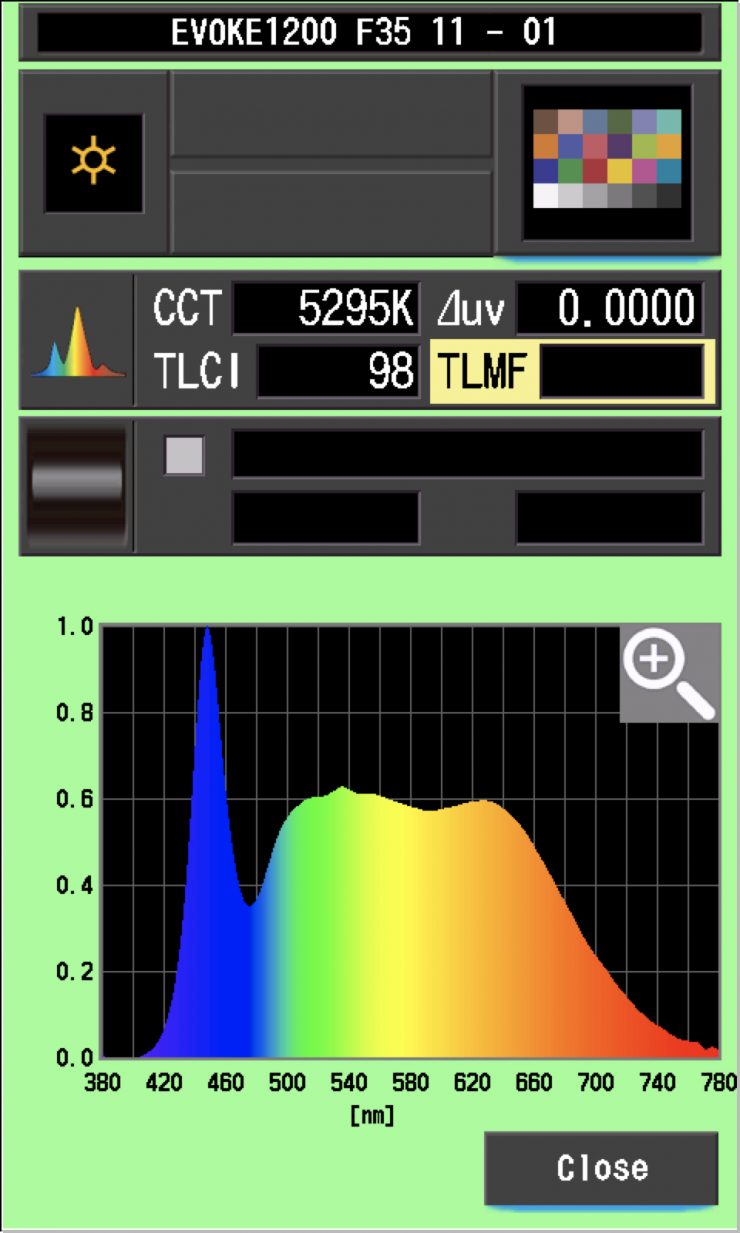
The Evoke 1200 when used with its optional F-35 Fresnel recorded a TLCI score of 98.
CC Index & ⊿uv
The CC Index displays the CC correction value and whether any magenta or green need to be added or subtracted. 1 CC corresponds to 035 Kodak CC values or 1/8 Rosco filter values. Any reading less than +1.00 or -1.00 and you’re probably not going to need to make any kind of adjustment. The ⊿uv is the value to show how much this light is away from being an ideal light source (black body radiation = incandescent lamp). As with the CC Index you want this number to theoretically be zero. Kelvin is not a linear value, so we need to convert from Kelvin to MK-1 to compare the values of color temperature. To calculate from Kelvin to Mired is MK-1= 1*1000000/Kelvin. While this may sound confusing, it is the only way of measuring if the Kelvin shift is significant enough to warrant having to use a filter for correction. Below are the results for the Evoke 1200:
Kelvin Vs MK-1 (Open face)
| Kelvin | Difference in K | MK-1 | Difference in MK-1 | |
| SET VALUE | 5600K | 0 | 178.57 | 0 |
| ACTUAL READING | 5377K | 223 | 185.97 | -7.40 MK-1 |
Kelvin Vs MK-1 (Reflector)
| Kelvin | Difference in K | MK-1 | Difference in MK-1 | |
| SET VALUE | 5600K | 0 | 178.57 | 0 |
| ACTUAL READING | 5353K | 247 | 186.81 | -8.24 MK-1 |
Kelvin Vs MK-1 (F-35 Fresnel)
| Kelvin | Difference in K | MK-1 | Difference in MK-1 | |
| SET VALUE | 5600K | 0 | 178.57 | 0 |
| ACTUAL READING | 5295K | 305 | 188.85 | -10.28 MK-1 |
These figures might look confusing, but what it tells me is that the light could be more Kelvin color accurate. Any MK-1 score that is under -9/9 means you wouldn’t have to use any color correction gels. The MK-1 scores for this light were fairly average. Any MK-1 score of -/+6 or under is considered to be very good.
CC INDEX & ⊿uv (Open Face)
| CC INDEX | ⊿uv | |
| 5600K | 0.1G | -0.0009 |
CC INDEX & ⊿uv (Reflector)
| CC INDEX | ⊿uv | |
| 5600K | 0.1G | -0.0006 |
CC INDEX & ⊿uv (F-35 Fresnel)
| CC INDEX | ⊿uv | |
| 5600K | 0 | 0.0000 |
The ⊿uv scores were very good for this light and some of the best I have seen from any LED light. The Creamsource Vortex 8, Rotolight Titan X2, Luxli Fiddle Pocket are the only lights I have tested that have ever recorded a perfect ⊿uv at any Kelvin color temperature.
TM-30
TM-30 is a relatively new color rendering standard that was developed to deal with the limitations of CRI. TM-30 looks at 99 individual colors. These 99 colors are categorized into seven groups: nature, skin color, textiles, paints, plastics, printed material, and color systems.
TM-30 scores go from 0 – 100. The higher the score, the more accurate a light is at producing colors. Any TM-30 Rf score in the ’90s is considered to be good. What is interesting and something that you need to be very aware of is that two separate light sources with the exact same CRI scores can render colors very differently. A light with a high CRI rating could have a low TM-30 score. Conversely, a light with a good TM-30 score could have a bad CRI score.
Now, there are two measurements associated with TM-30, Rf and Rg.
Rf (Color Fidelity)
Rg (Color Gamut)
With Rf value, ideally, you want a score in the 90’s.
With Rg value, a score below 100 indicates that the light source renders colors with less saturation than the reference source. So ideally you want this score to be above 100.
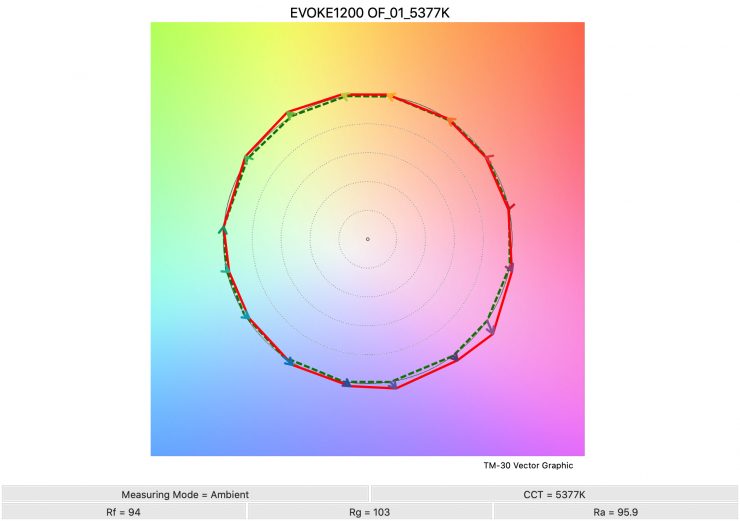
Open face 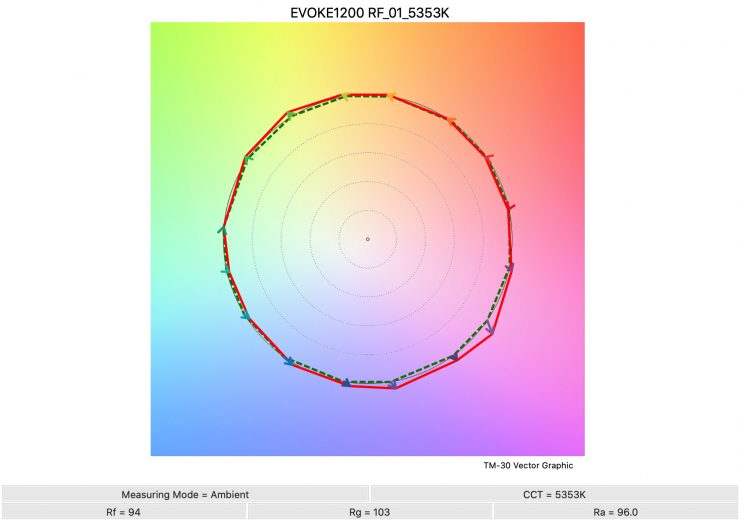
Reflector 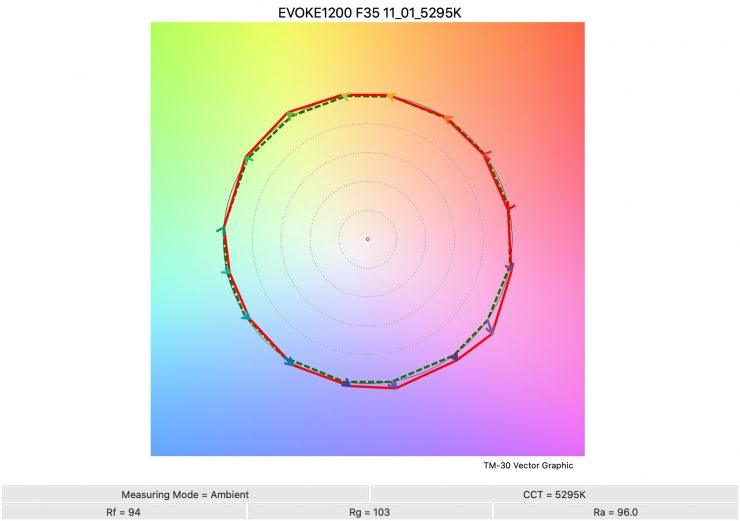
F-35 Fresnel
Above you can see the scores for the Evoke 1200 when used open face, with the reflector, and with the F-35 Fresnel. Below I have listed the figures as well.
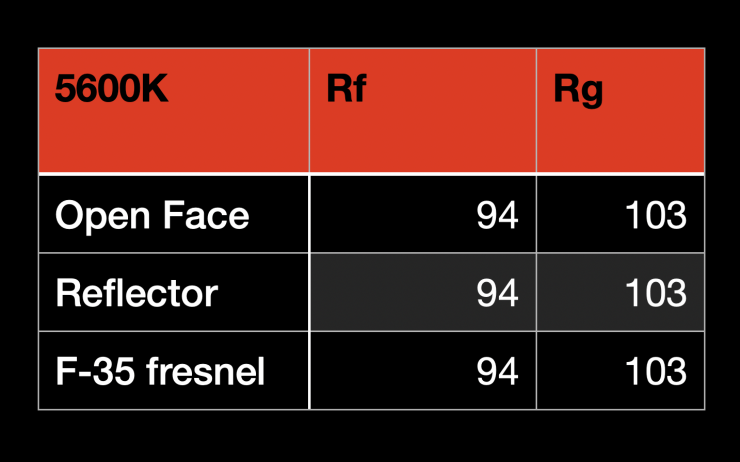
The TM-30 scores are all very good. It is no real surprise that the readings were identical no matter how you used the light.
SSI
SSI (Spectral Similarity Index) was developed by the Sci-Tech Council of the Academy. SSI gives me the ability to set any light as a standard, or use predefined standards (such as CIE D55), and then give other lights an SSI score based upon how well they will match standards such as CIE D55. This way I can measure spectral response and compare it directly against an ideal light source. This is actually a much better test than recording CRI scores.
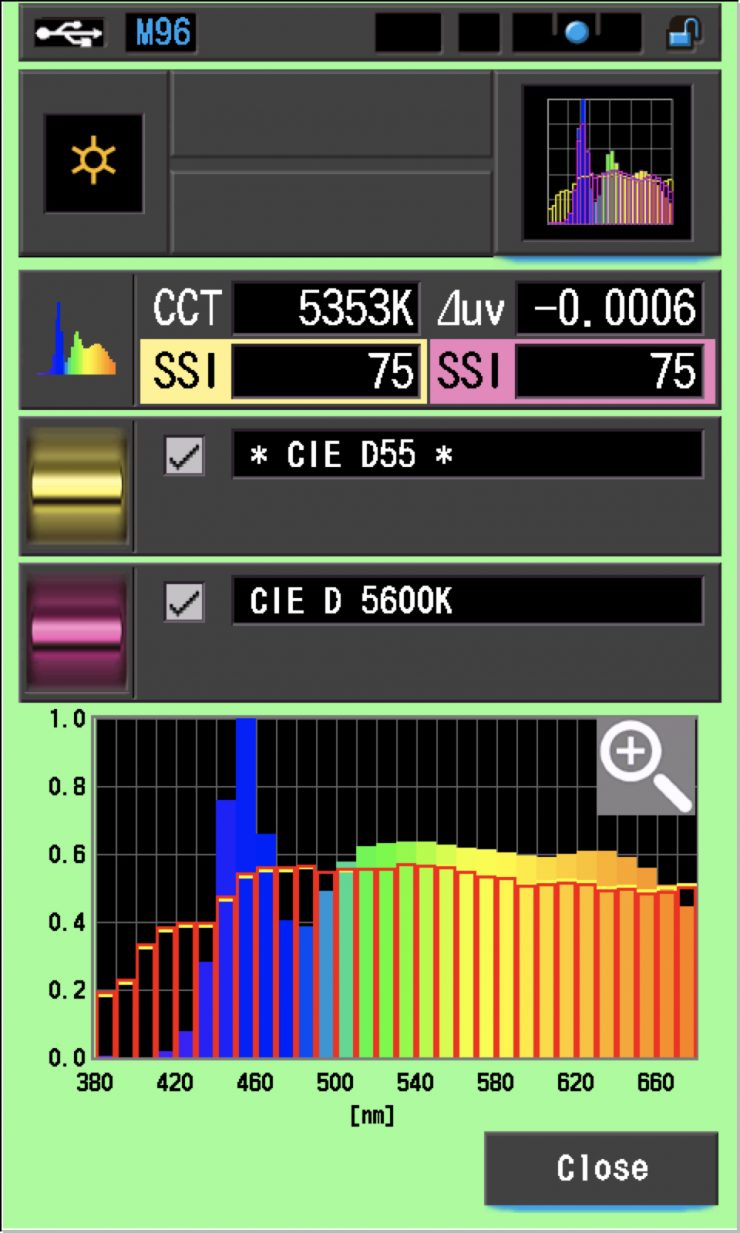
In the graph above the gold bars indicate a perfect CIE D55 source. The red bars indicate a perfect CIE D 5600K source. This lets us compare how close to a perfect 5600K lighting source the Evoke 1200 is. A score in the low 70’s is typical for a 5600K LED source. A score of 75 is very good.
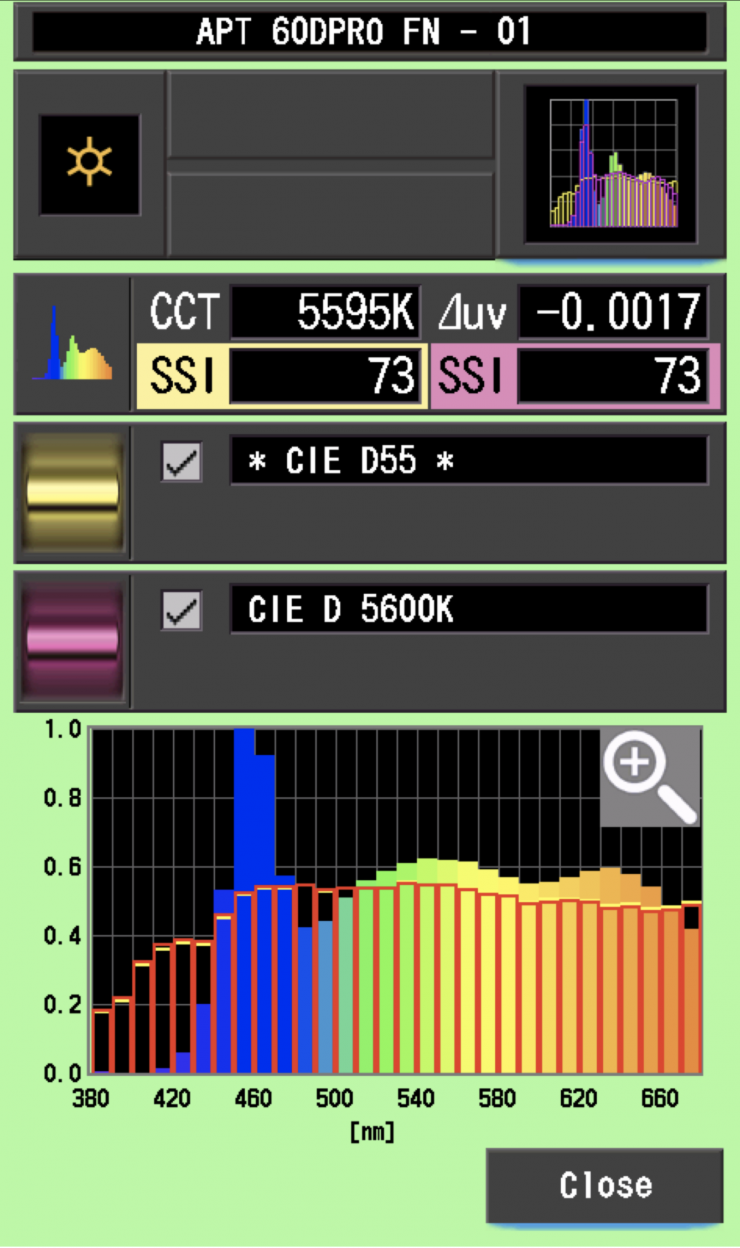
As a comparison, above is the results for the Aputure LS 600d Pro and F10 Fresnel.
The main reason we want to record SSI scores is so we can see how well they match with other lights. As an example, I wanted to see how well the Nanlux Evoke 1200 matched the ARRI Orbiter and Lupo Dayled 2000 Dual Color Pro. Below you can see the results.
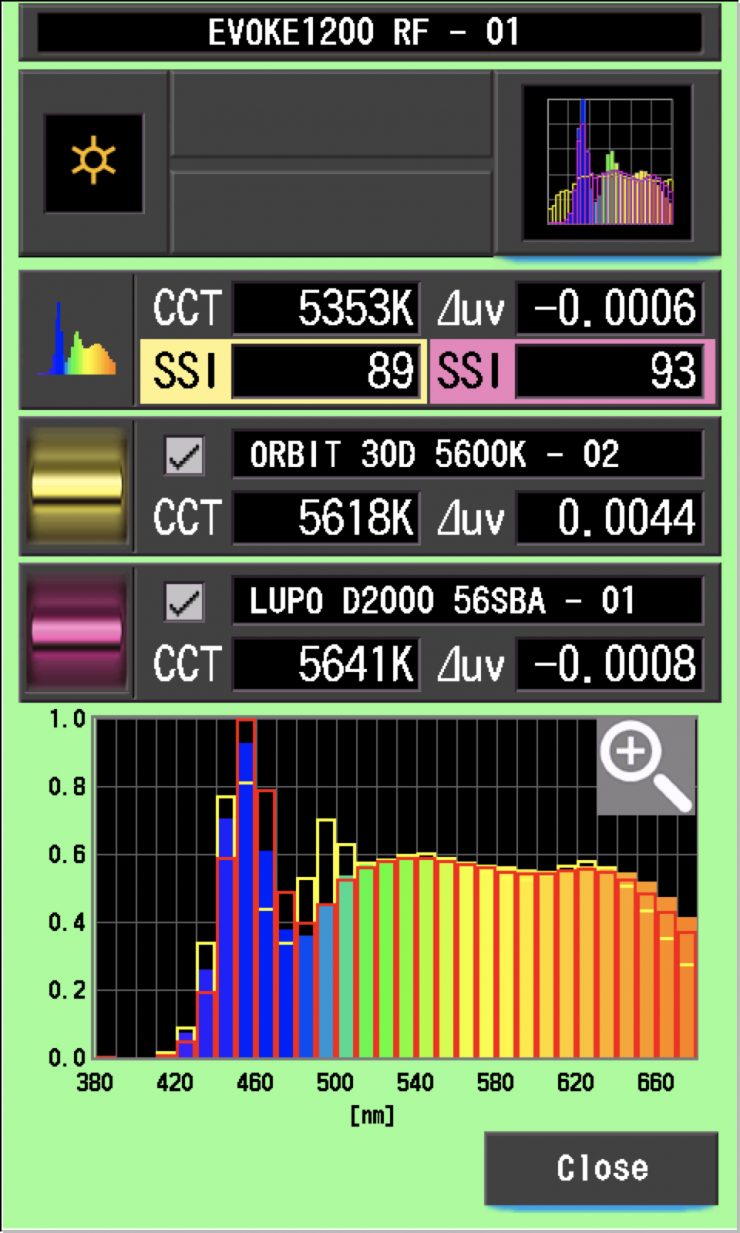
As you can see, the Evoke 1200 matches very well with an ARRi Orbiter and a Lupo Dayled 2000 Pro Dual Color.
SSI tests are a great way of telling you what lights you own or use will work well together.
Spectral Distribution
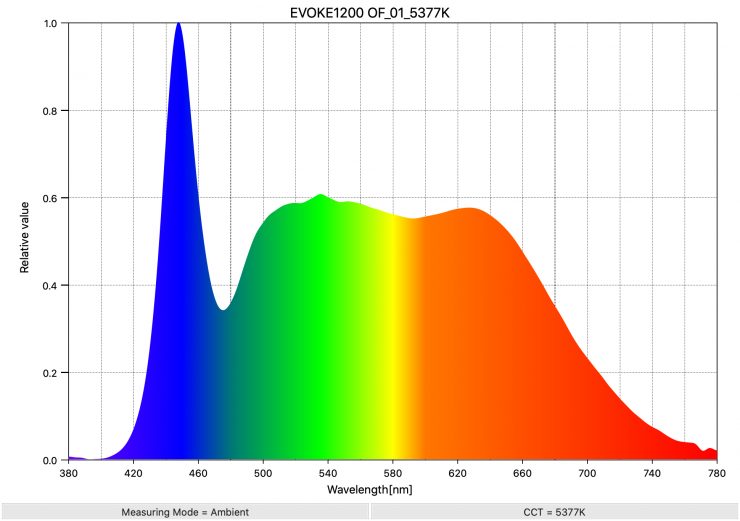
Above you can see the spectral distribution of the Evoke 1200 when it is set at 5600K and used open face. The spectral distribution is reasonably full and nice and even.
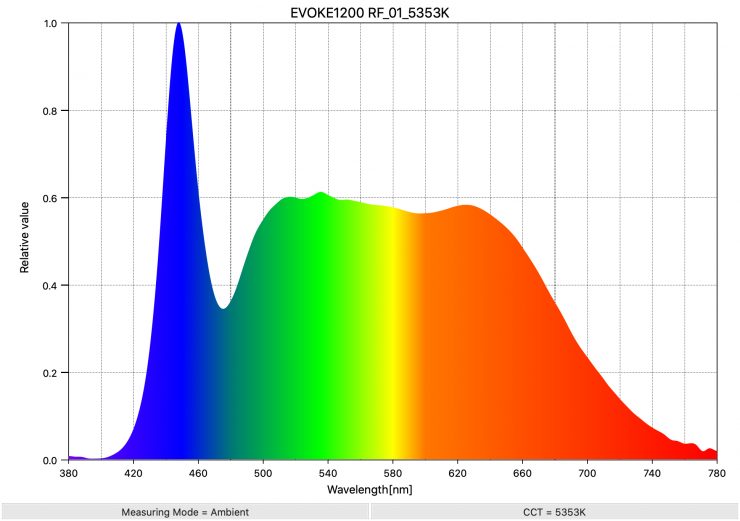
Above you can see the spectral distribution of the Evoke 1200 when it is set at 5600K and used with the reflector.
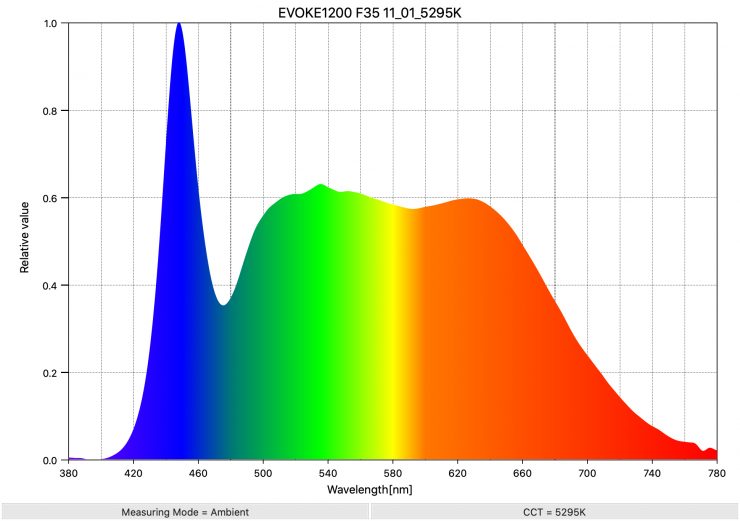
Above you can see the spectral distribution of the Evoke 1200 when it is set at 5600K and used with the F-35 Fresnel.
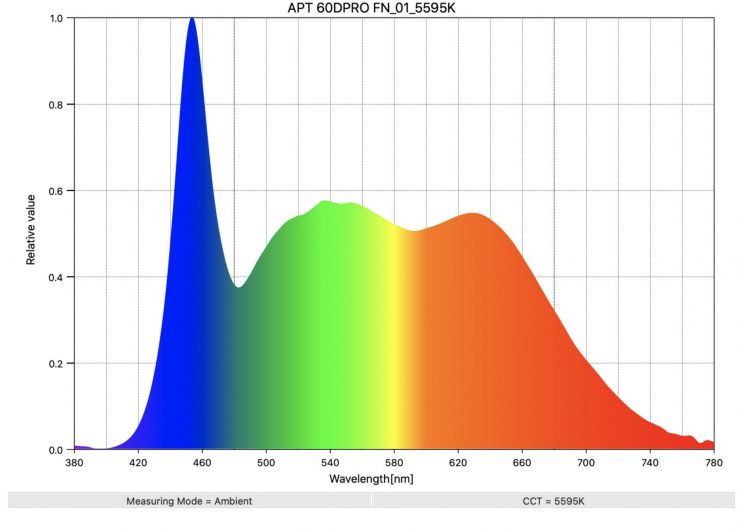
As a comparison, above you can see the spectral distribution of the Aputure LS 600d Pro when used with its optional F10 Fresnel.
Real-World Performance & Quality of Light
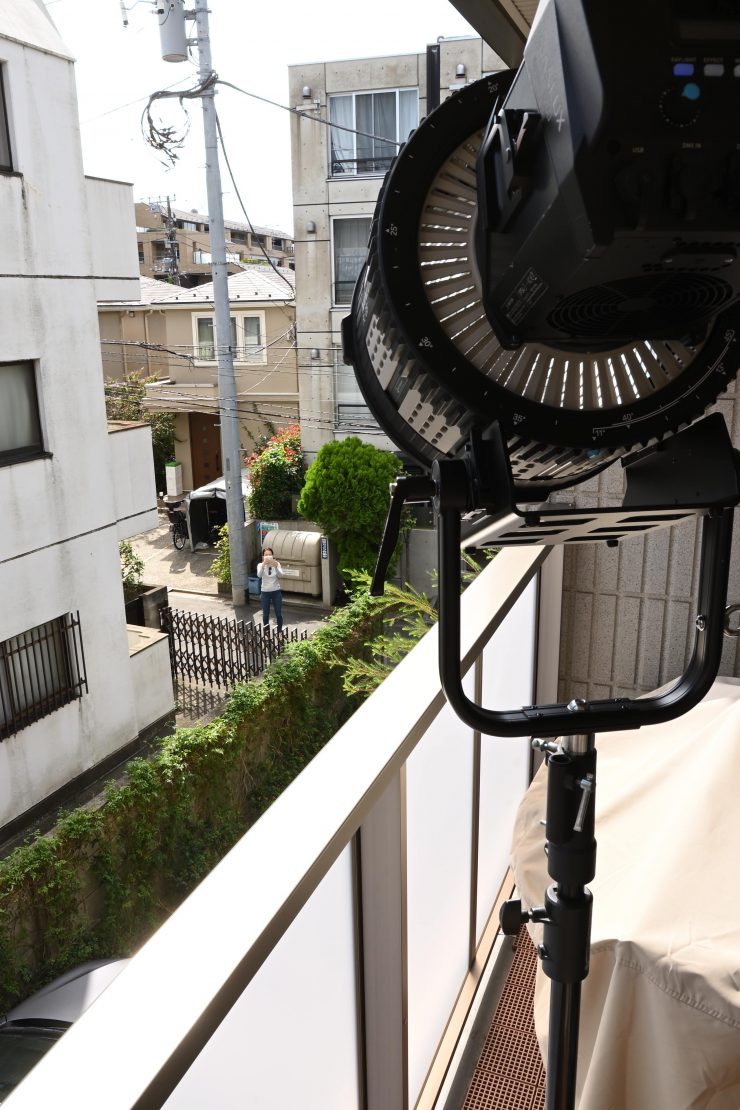
As I always say, photometric scores only tell you part of the story. So let’s find out if the scores from the Evoke 1200 translate into good real-world performance.
The photometric results can only give me scientific data and it is much more important for me to see how the light looks and performs.
Unfortunately, it is very hard at the moment with the Coronavirus for me to showcase the strengths of the light. I live in Japan in an apartment so there isn’t a lot of space to do much testing. I have still tried to do as much as possible, I apologize that I can’t do more!
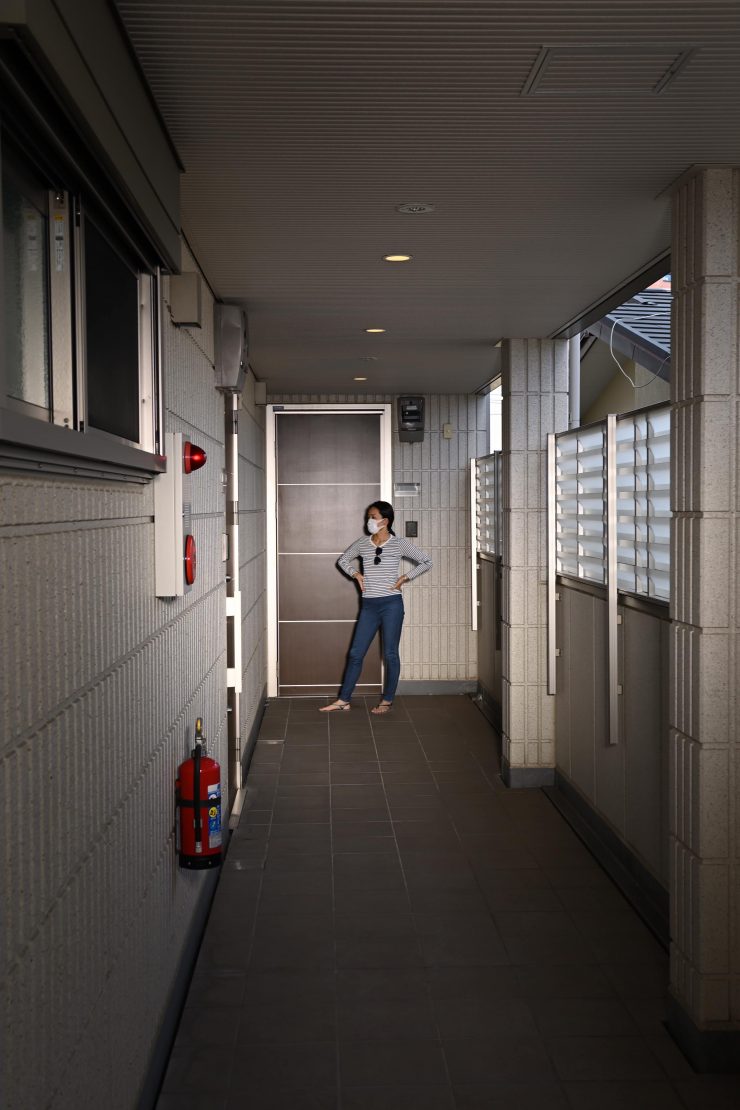
Light on 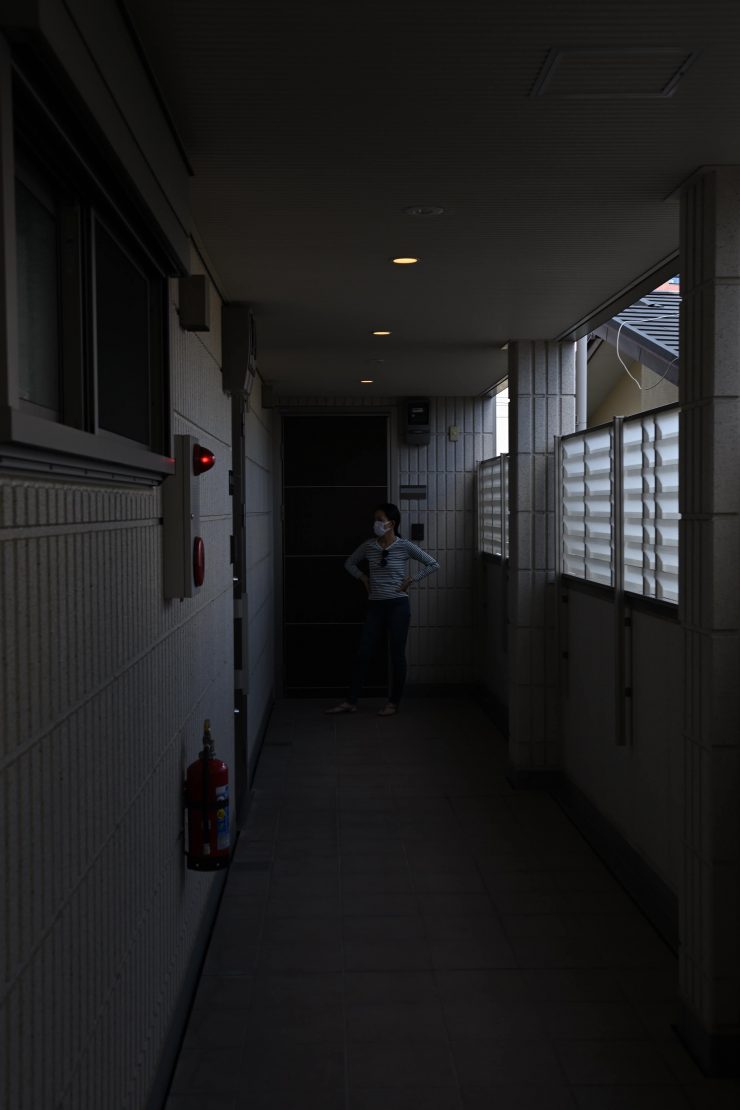
Light off
The Evoke 1200 is a very, very bright fixture no matter how you use it. Having a light with a lot of output is always nice because you can heavily diffuse it when needed, or use it to create a very hard light source by punching it through a window, etc. Above you can see what the light looks like with the F-35 Fresnel set at 11° with the subject a little over 5m / 16.4′ away from where the fixture is. You can see that even at 11° the beam spread is still fairly wide because the size of the Fresnel is so big.
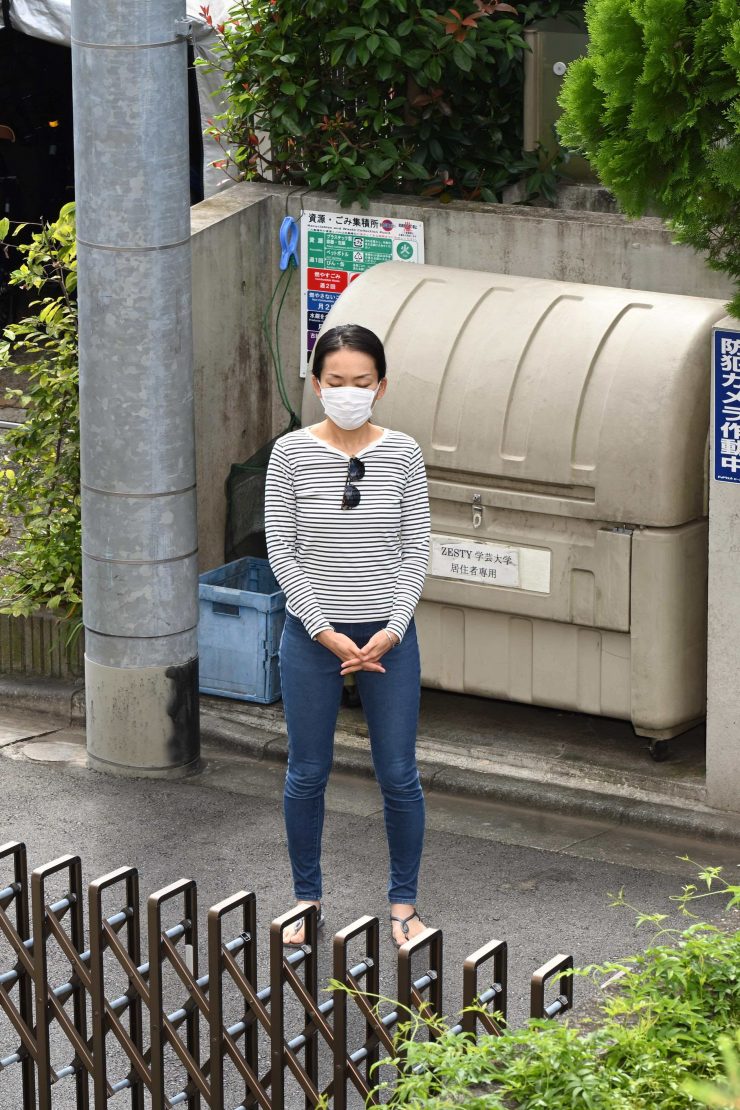
Light on 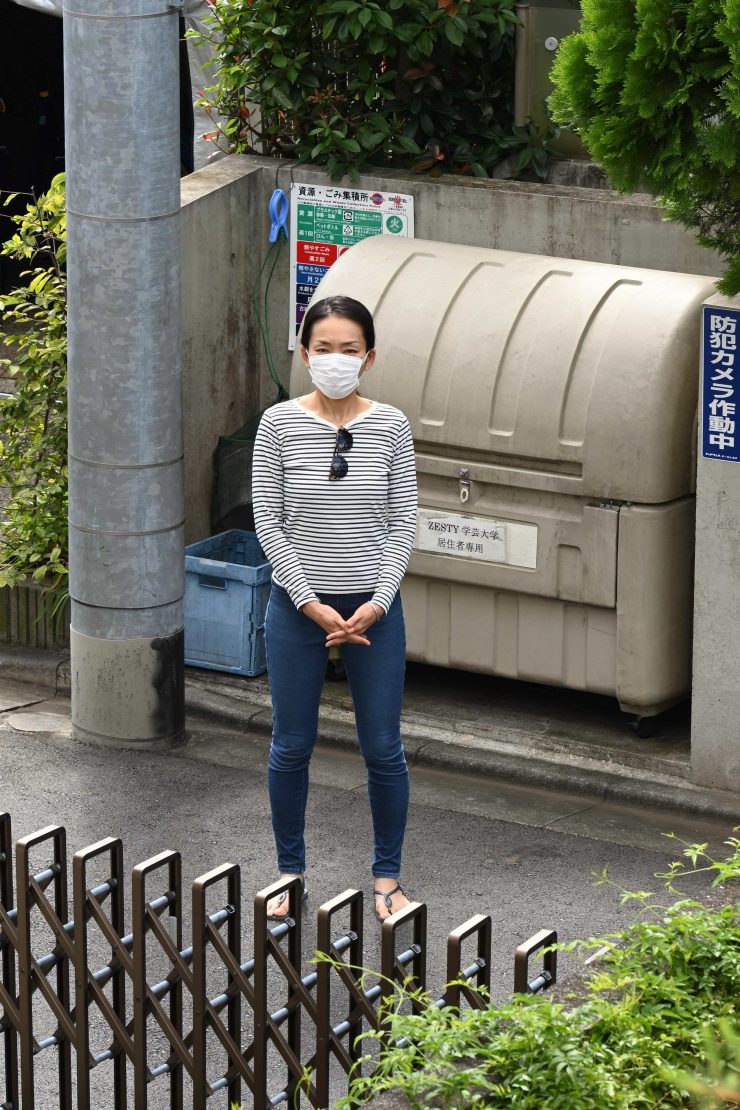
Light off
Above you can see just how much illumination you can get with the subject at around 20m / 65.6′ away from the light source in the middle of the day. The light is blasting straight back into the direction of the sun. This is impressive given the distance and the fact that this is a light that plugged into a regular household mains outlet.
Above you can see just how far away the light was for these tests.
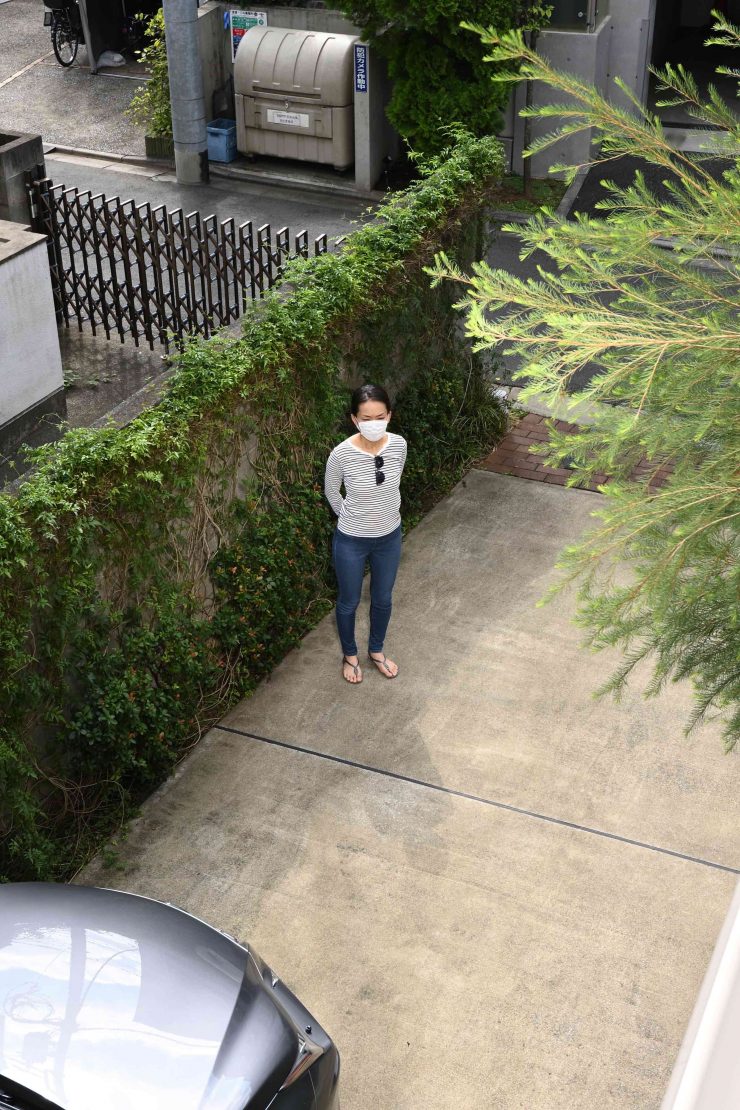
Light On 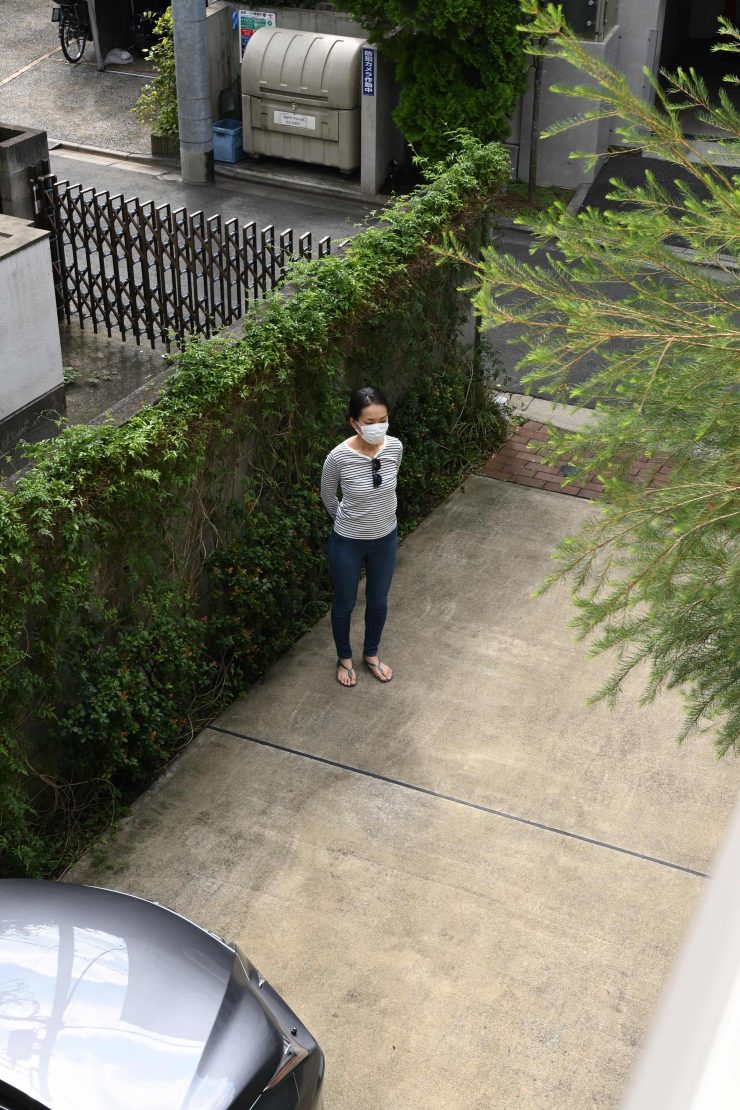
Light Off
Above you can see that if we move our subject closer, around 7-10m from the light source, the Evoke 1200 is making a big difference.
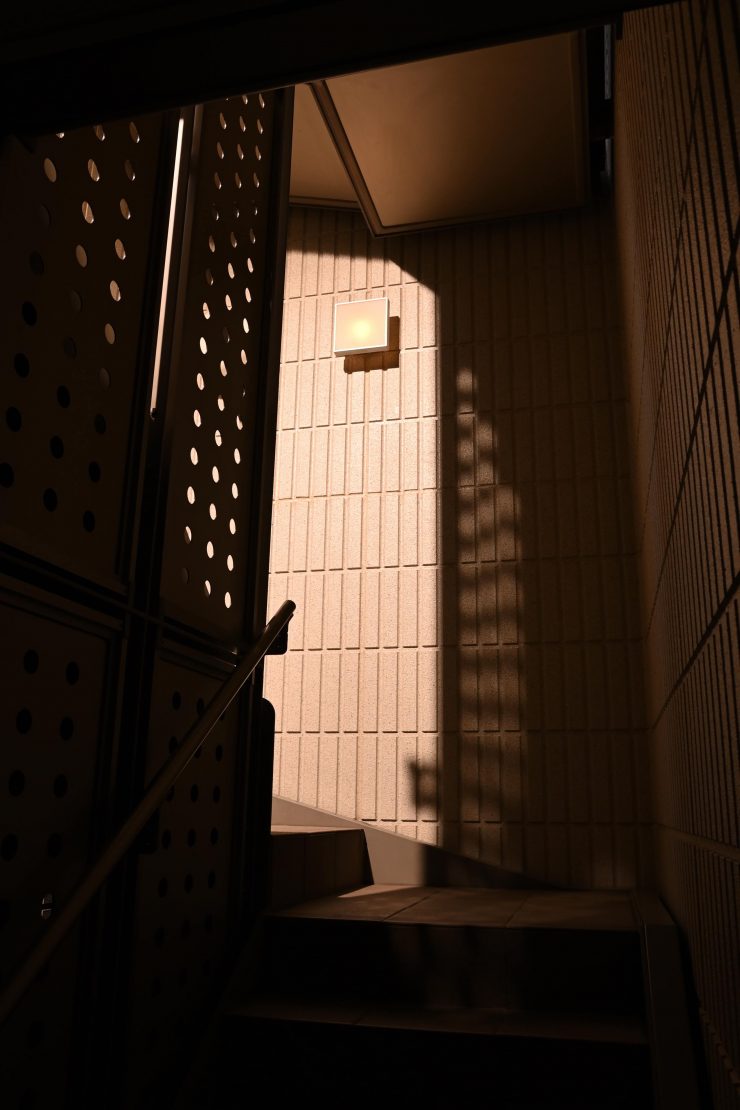
Light On (Fresnel at 11°) 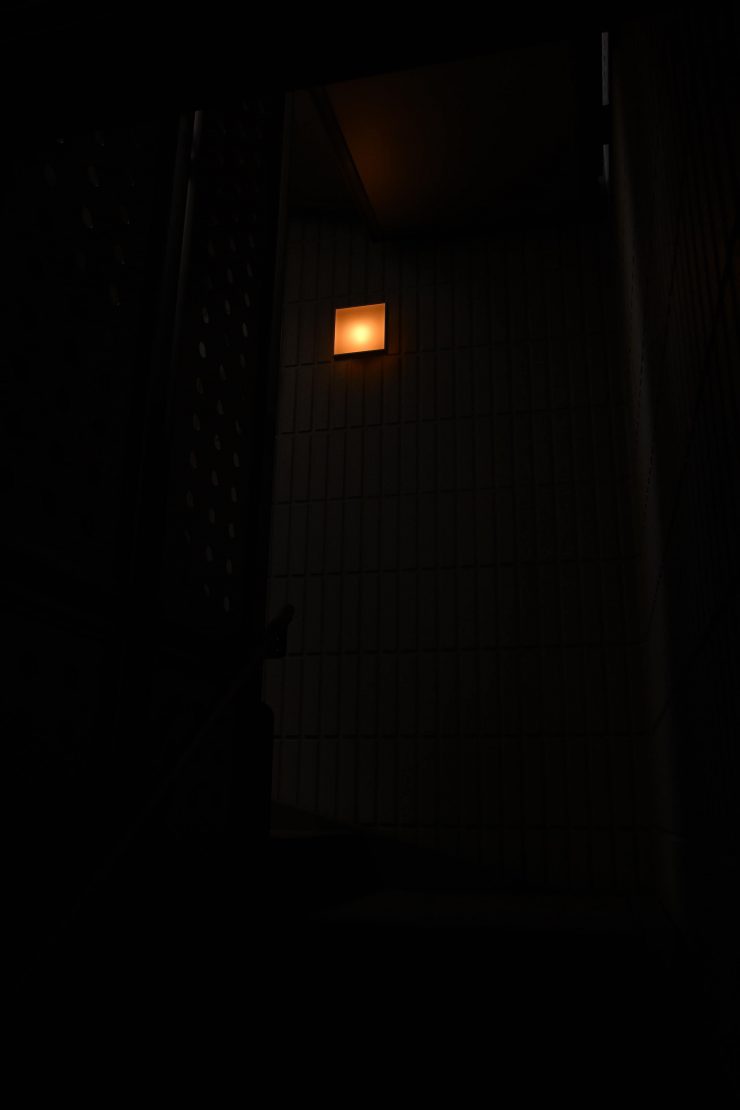
Light Off
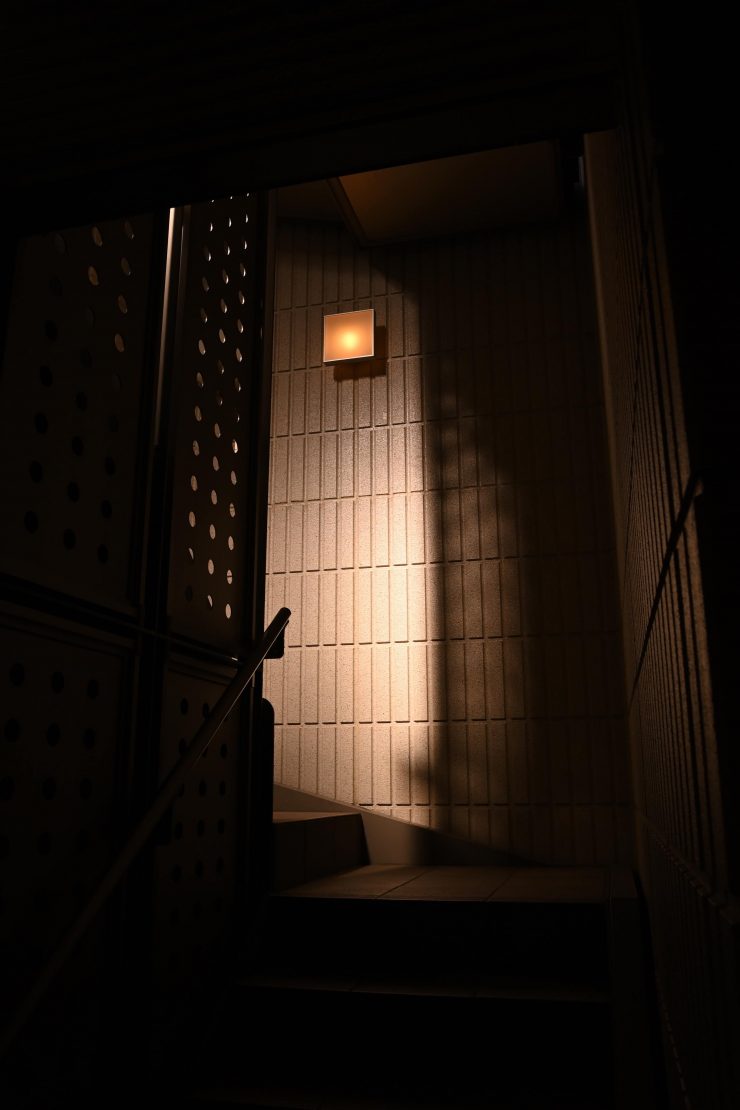
Light On (Fresnel at 45°) 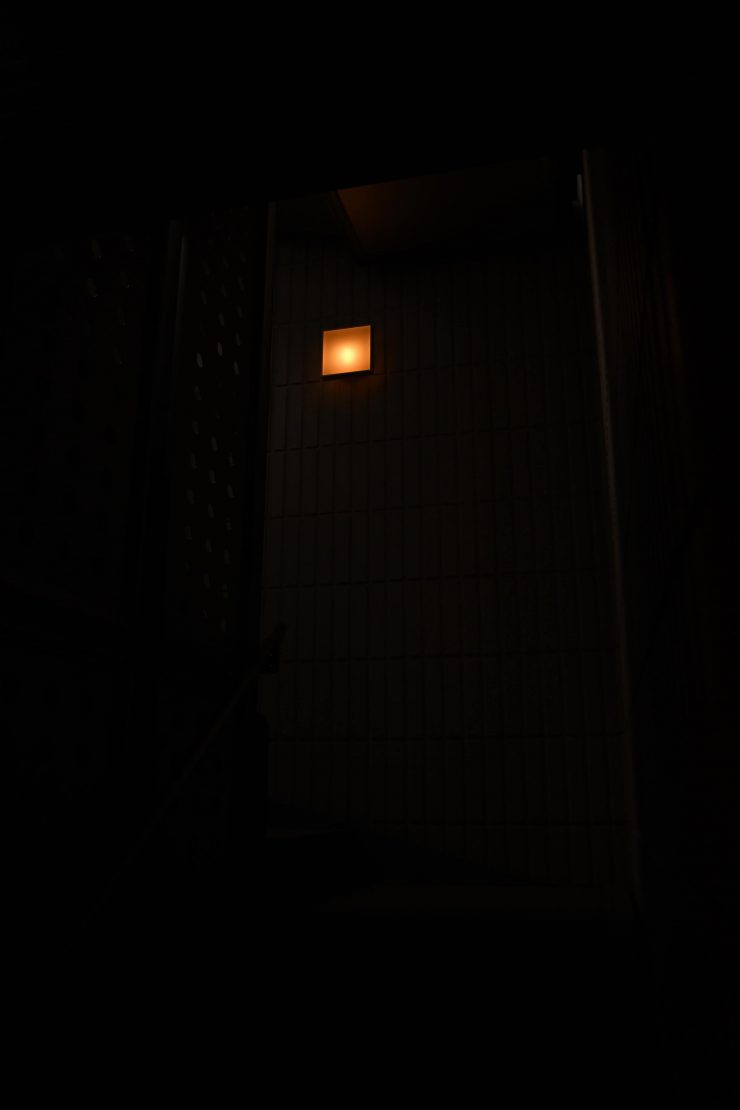
Light Off
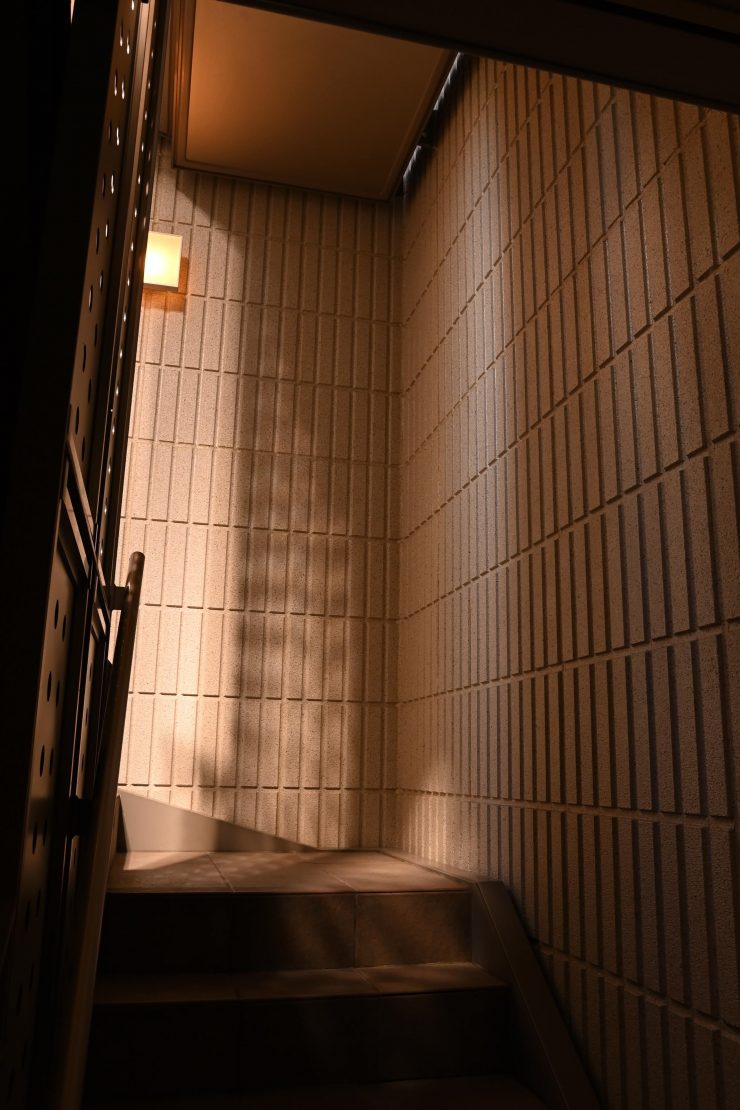
Light On (Fresnel at 45°) 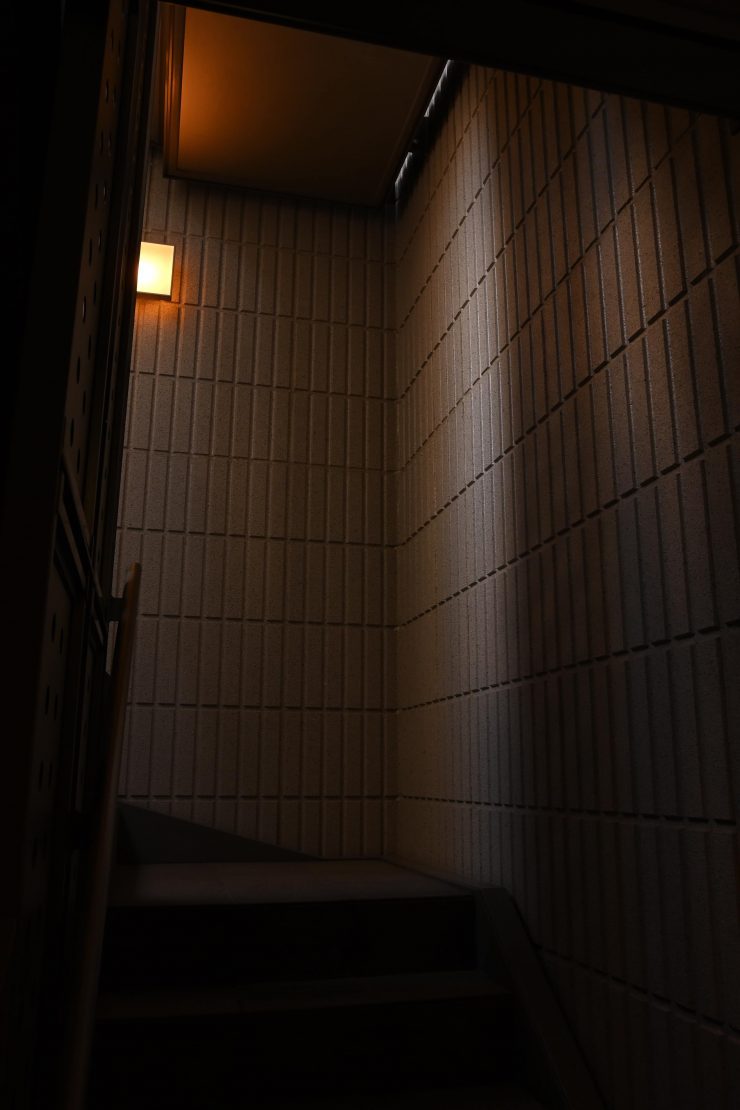
Light Off
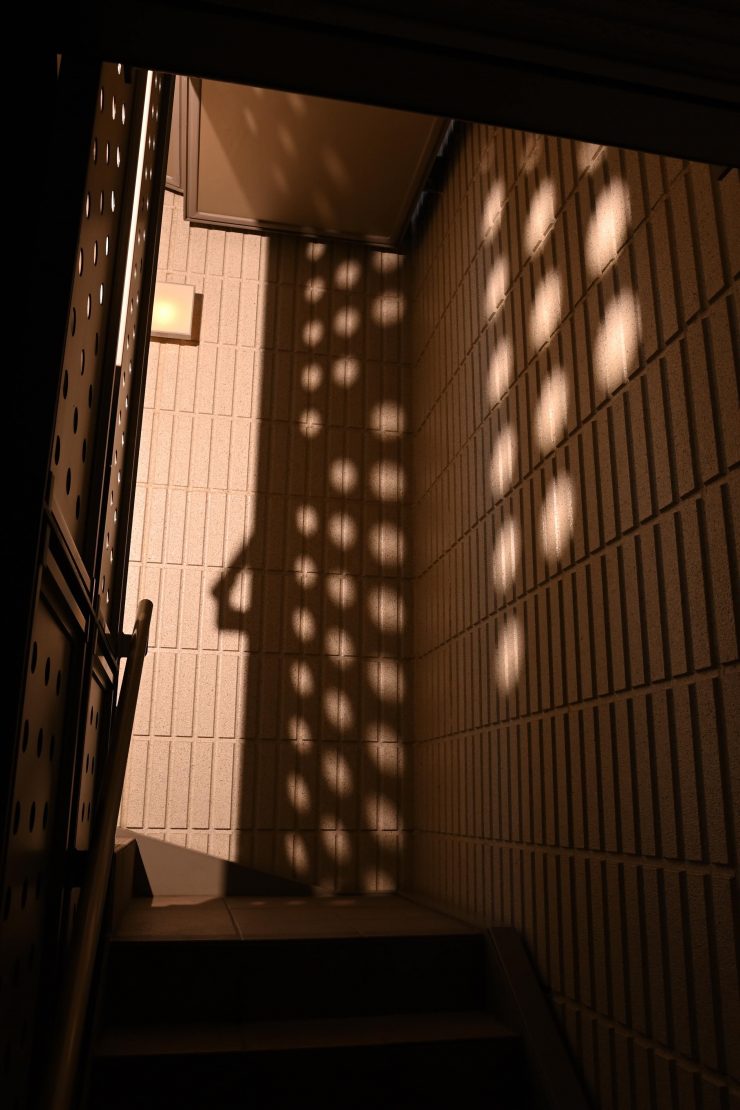
Open face 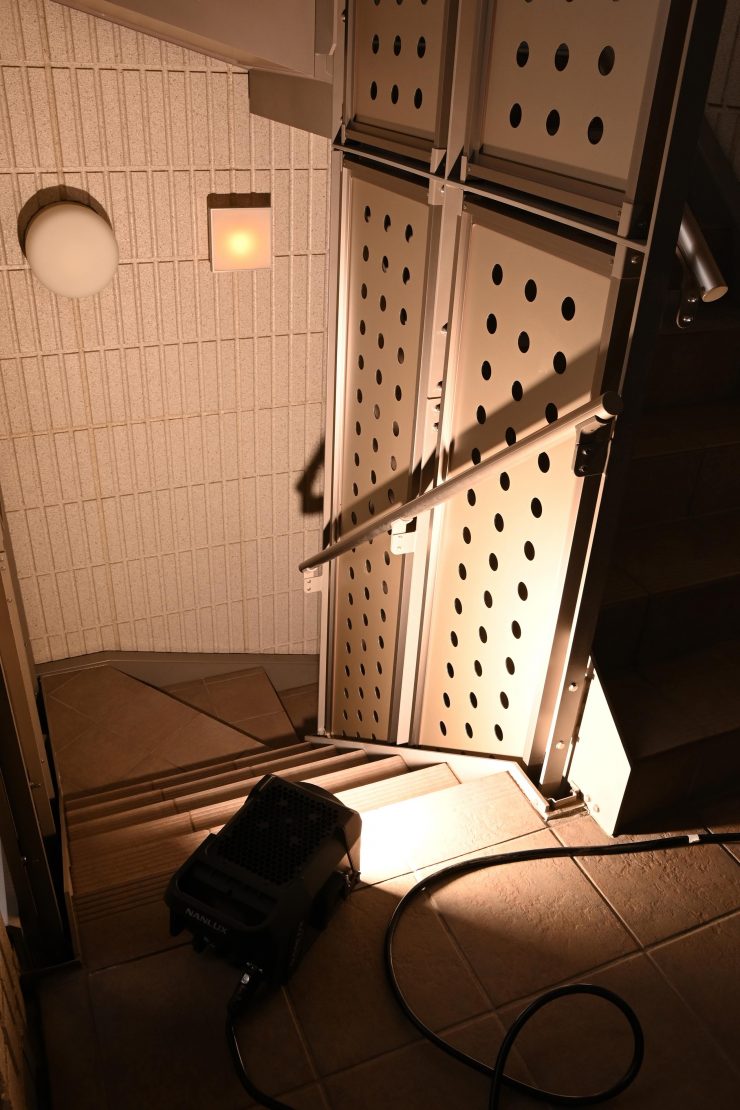
Open face
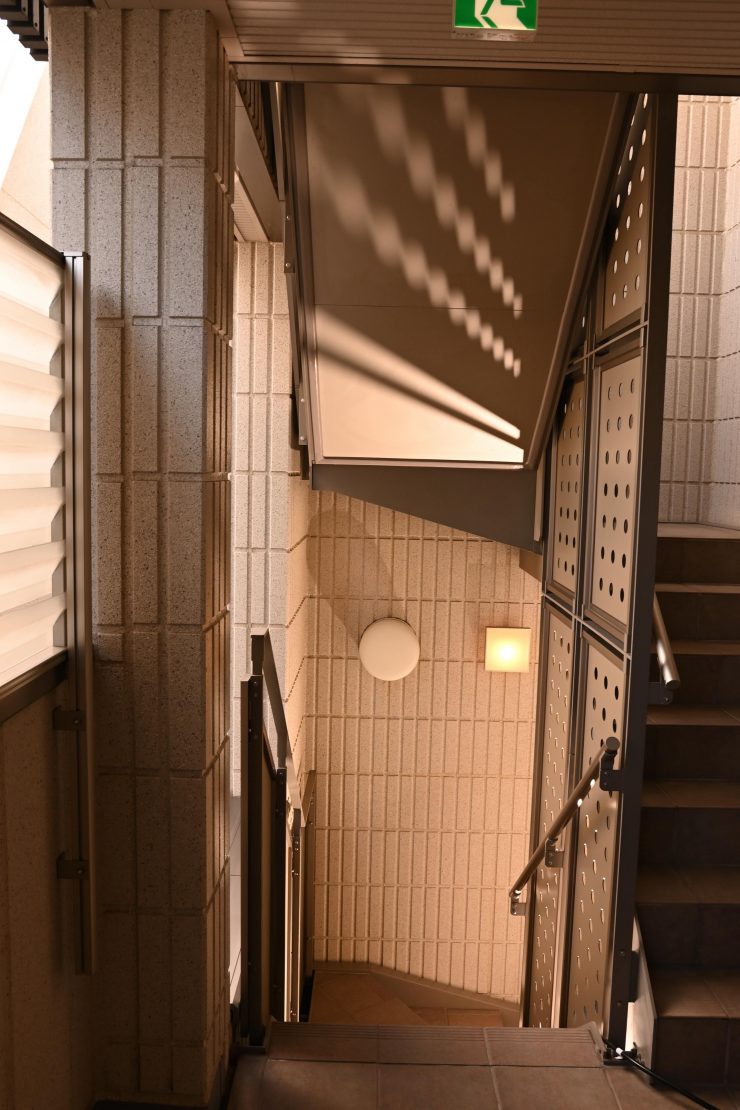
Open face 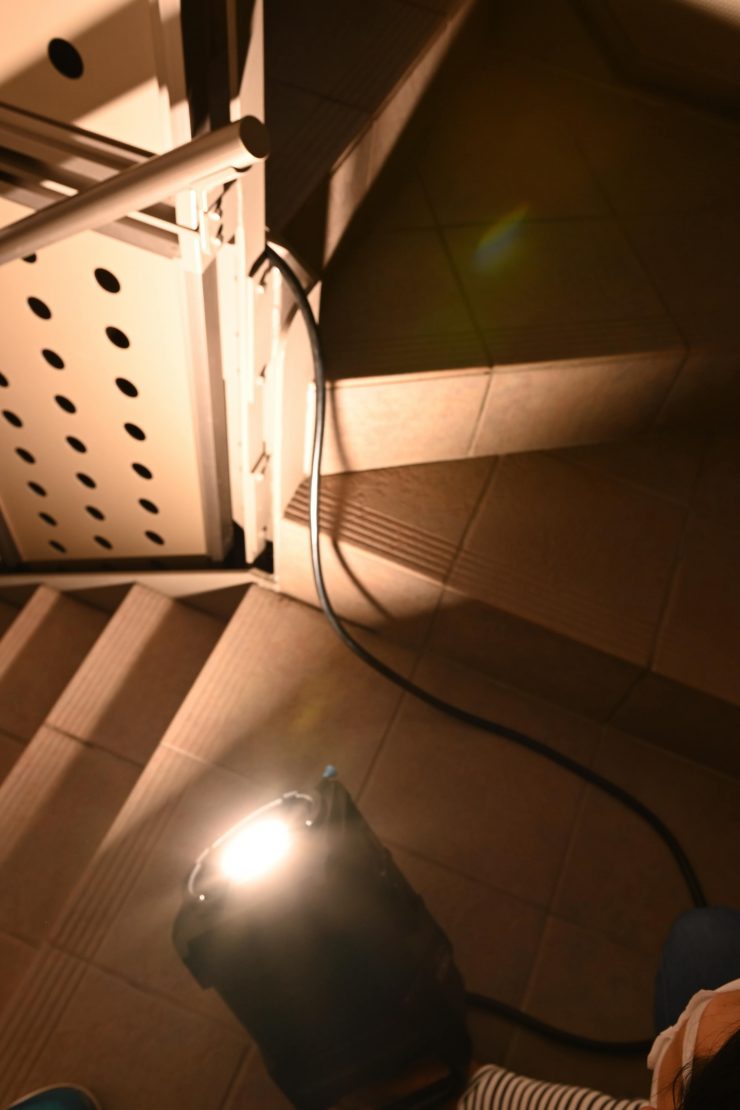
Open face
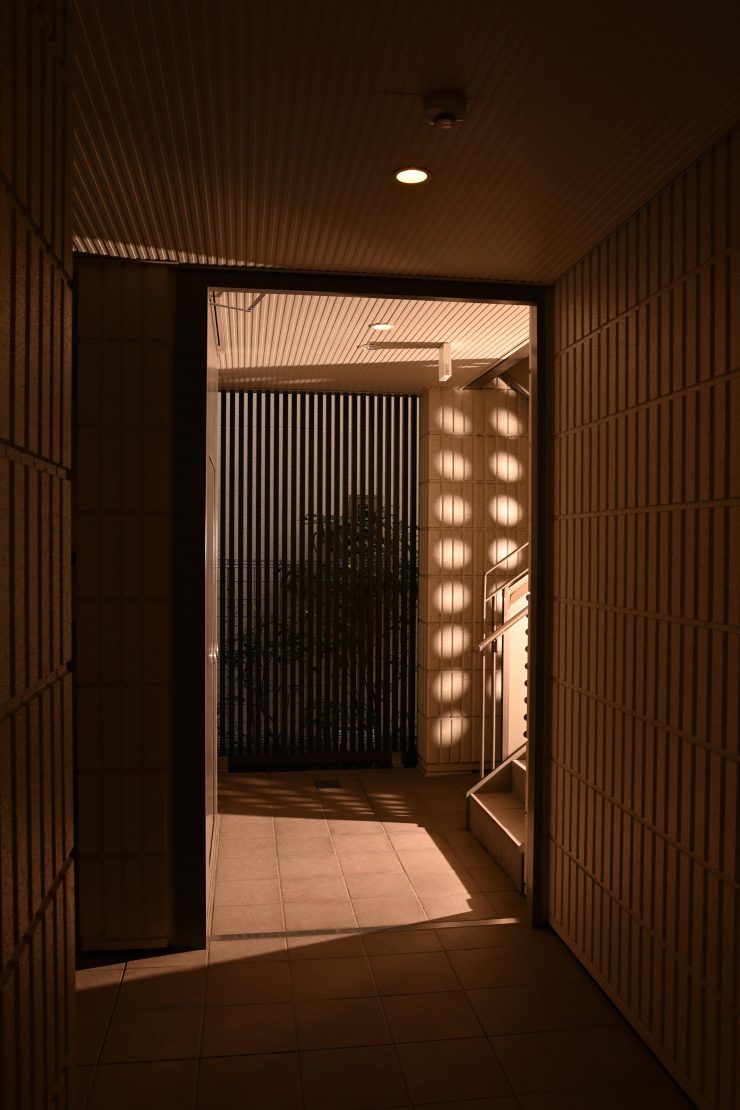
Open face 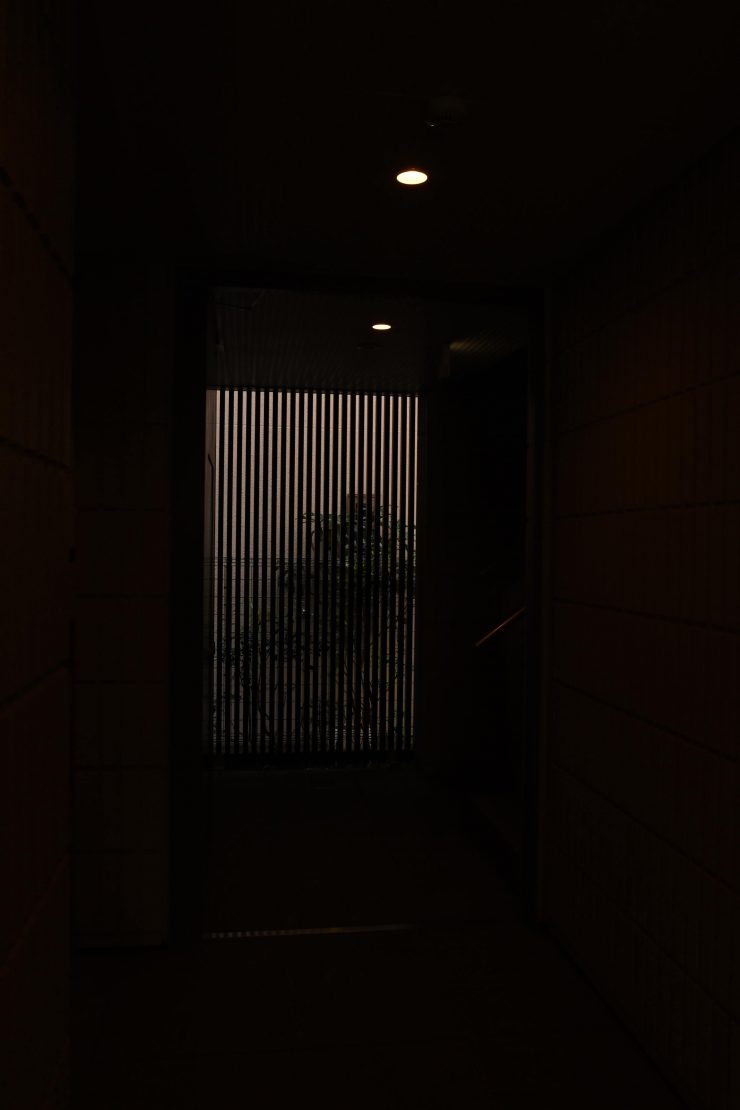
Light Off
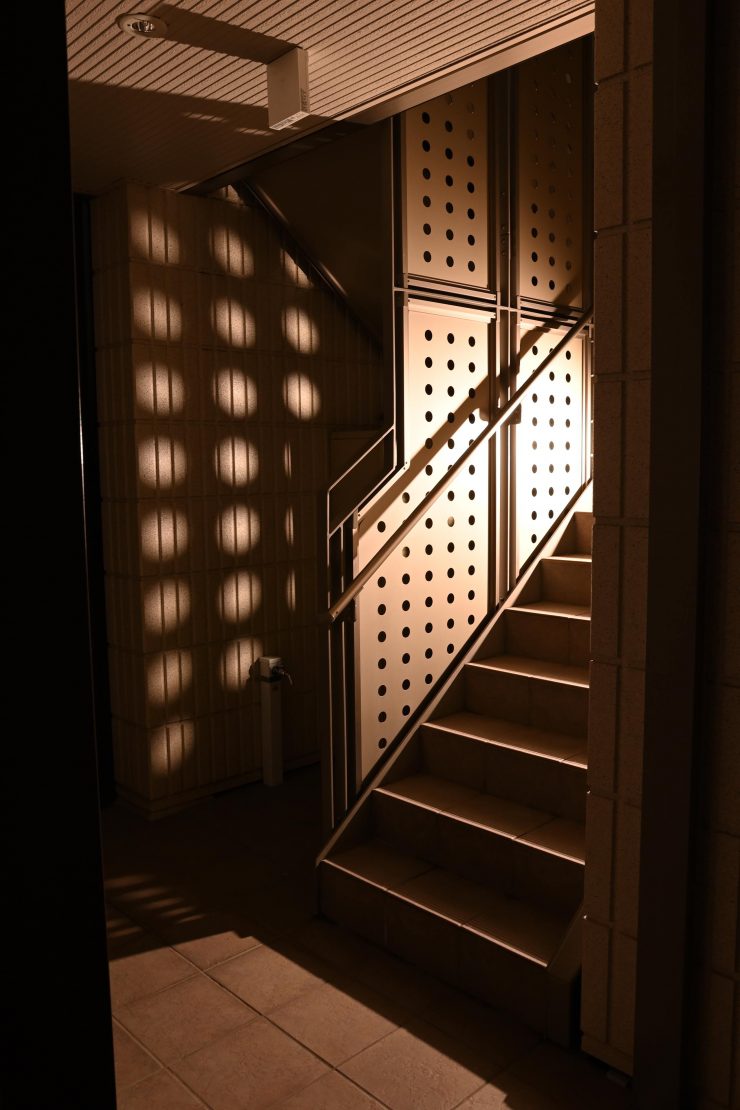
The place where the Evoke 1200 shines is when you are using it to light up backgrounds. Above you can see some examples using the light with the Fresnel at 11° and 45°, and without the Fresnel (open face). Please note that I have used quite a warm white balance to capture these shots.
Who is the Evoke 1200 aimed at?
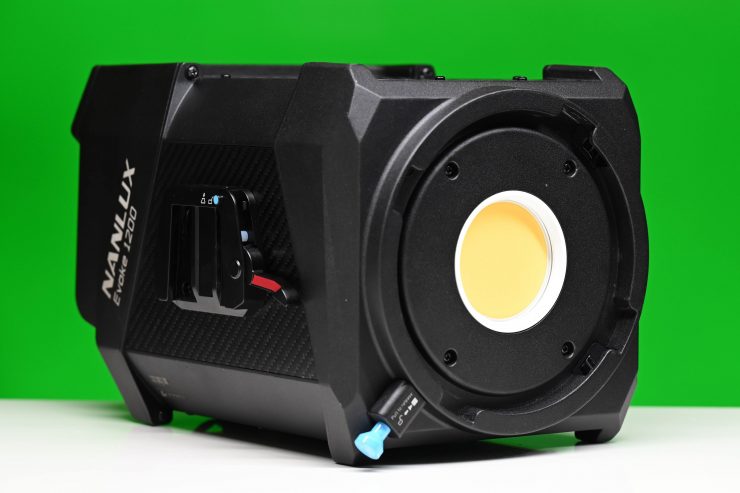
You could use the Evoke 1200 for lots of different applications, but the light is certainly being targeted as a versatile, high-output spotlight for professionals in the TV and film industry.
It is priced to appeal to rental houses and certain owner-operators who are looking for a high-output fixture that can replace a traditional HMI. The Evoke 1200 has the ability to be a hard light source or a soft source and that makes it quite versatile.
The Evoke 1200 is likely to catch the eye of rental houses, production houses, studios, and broadcasters who want a high output HMI equivalent that can be run via mains power. The price is also likely to be a key factor in why the Evoke 1200 gets looked at over other competing fixtures.
Price & Availability
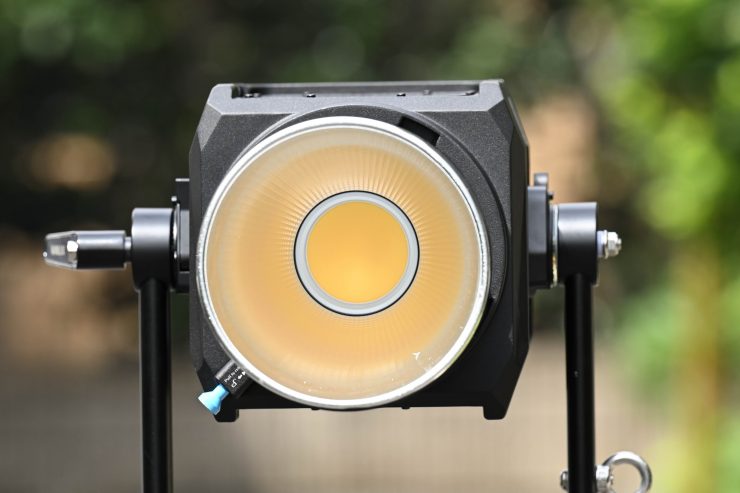
The Nanlux Evoke 1200 retails for $3,380.00 USD. This makes it a very appealing prospect for those shooters who are looking for a light that offers features and functionality that are only currently found in much more expensive fixtures.
The F-35 Fresnel retails for $935 USD. If you are thinking about buying an Evoke 1200, the Fresnel is probably something that a lot of potential customers will also look to purchase.
Below you can see how the price compares to some of the lights that could be considered competition:
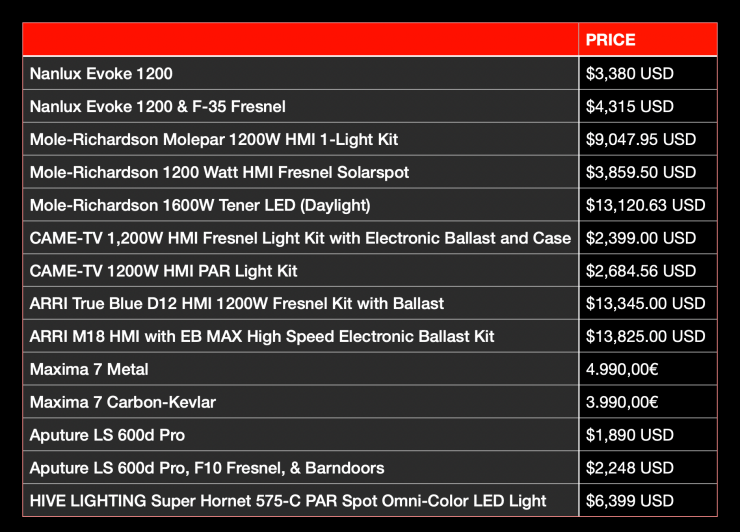
I included lights such as the Aputure LS 600d Pro just so you have a reference as to what smaller sized, lower power draw LED spotlights cost.
Optional Extras
Nanlux does make a few accessories for the Evoke 1200, including softboxes, a Fresnel, flight cases, and a longer connector cable.
The prices for the various accessories are as follows:
- SB-LM-150 PR Parabolic Softbox 150cm with NLM Mount $390 USD
- SB-NLM-150-O Octagonal Softbox 150cm with NLM Mount $300 USD
- LT-NLM-120 Lantern Softbox 120cm with NLM Mount $338 USD
- SB-NLM-100-S Square Softbox 100cm ith NLM Mount $232 USD
- CC-EV1200-FL-FT Flight case for Evoke 1200 & FL-35 Lens $238 USD
- CC-EV1200-FT Flight case for Evoke 1200 $186 USD
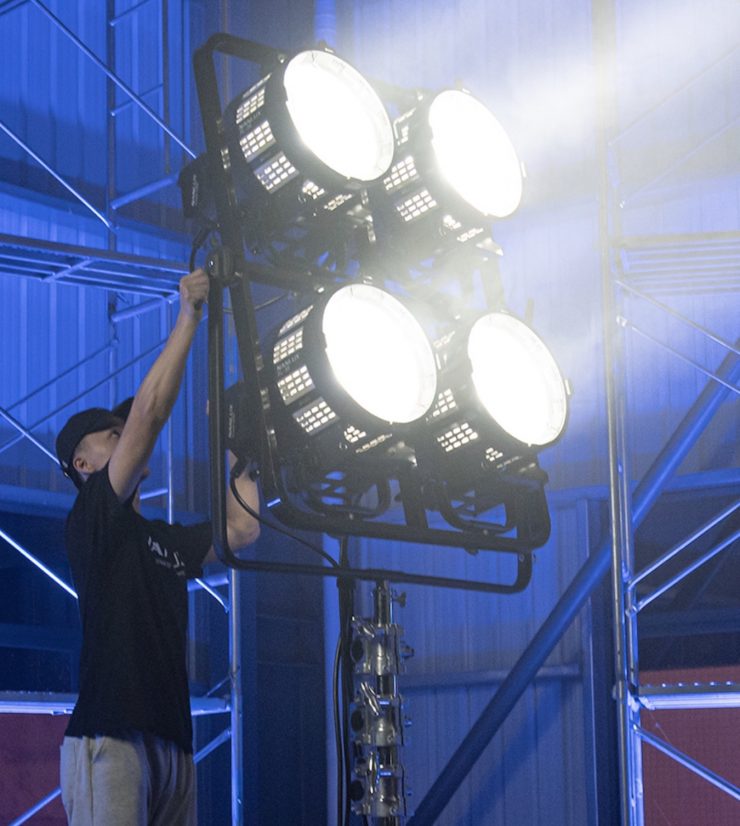
Nanlux also has plans to sell the Evoke 1200 in kits and there will also eventually be multi-light mounting frames available.
Nanlux also told me that they will also be releasing 26° and 60° reflectors.
Conclusion
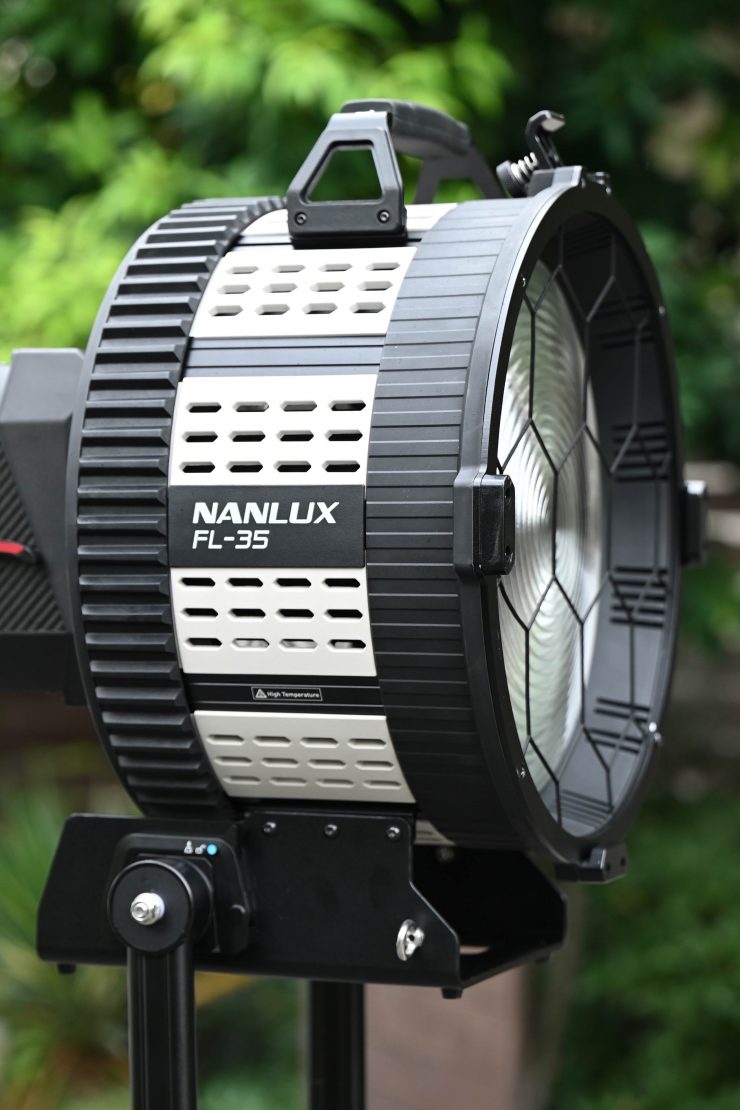
The Nanlux Evoke 1200 is a very impressive fixture. You can create a ton of output by simply plugging it into a regular household mains outlet. I am glad to see a company making something that is a little different from everything else that is out there in the market. Yes, you can argue that this light is brighter, or that light isn’t as bright as this light, but at the end of the day once a light reaches a certain amount of output, telling the difference between 60,000 lx and say 70,000 lx is difficult to see in the real world.
I don’t think there is any doubt that the physical shape, form factor, mount, and quick release system drew a lot of inspiration from the ARRI Orbiter.
The light is very color accurate, although the Kelvin color temperature accuracy could be a little better. The best thing is that the light doesn’t skew magenta or green in any way.
Yes, it is heavy, yes it is a little awkward to mount, yes it is a little noisy, but I think the pros of this light outweigh the cons.
The interface and operating system are super easy to use, and the F-35 Fresnel is definitely worth buying if you plan on purchasing an Evoke 1200.
What you need to factor in is the size and weight of the Nanlux Evoke 1200 and the accessories. This is not an easy light to transport or move around, especially with the F-35 Fresnel. You need to consider this carefully before purchasing. In saying that, this is true of any HMI or large-sized fixture.
The build quality is good, but there are a few little niggling issues I came across.
The Evoke 1200 isn’t a light that will be suitable for a lot of users. Despite being very versatile, the high power draw, physical size and weight, and the additional expense required to run it remotely, all need to be considered carefully. For some people, owning two smaller-sized LED spotlights could arguably be a better decision depending on what your requirements are.
I see the Evoke 1200 being more of a rental item than anything else, despite its relatively affordable price. For a lot of owner/operators it just takes up too much space and it is hard to transport.
All-in-all the Evoke 1200 is an impressive fixture that offers high levels of output and good versatility at an impressive price point.
Technical Specifications

Like what we do and want to support Newsshooter? Consider becoming a Patreon supporter and help us to continue being the best source of news and reviews for professional tools for the independent filmmaker.

